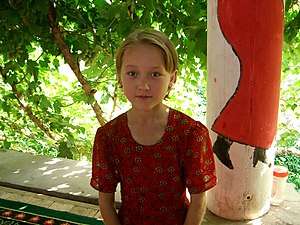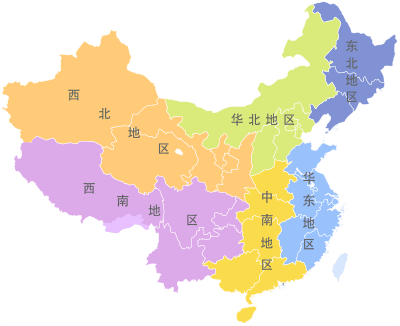History of Xinjiang
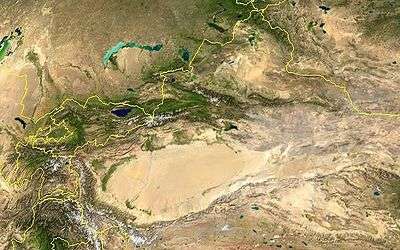

Part of a series on the |
|---|
| History of Xinjiang |
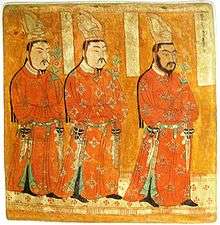 |
The recorded history of the area now known as Xinjiang dates to the 2nd millennium BC. There have been many empires, primarily Han Chinese, Turkic, and Mongol, that have ruled over the region, including the Yuezhi, Xiongnu, Han dynasty, Gaochang, Kingdom of Khotan, Sixteen Kingdoms of the Jin dynasty (Former Liang, Former Qin, Later Liang, and Western Liang), Turkic Khaganate, Tang dynasty, Tibetan Empire, Uyghur Khaganate, Kara-Khanid Khanate, Kingdom of Qocho, Qara Khitai, Mongol Empire, Yuan dynasty, Chagatai Khanate, Yarkent Khanate, Dzungar Khanate, and Qing dynasty. Xinjiang was previously known as "Xiyu" (西域), under the Han dynasty, which drove the Xiongnu empire out of the region in 60 BCE in an effort to secure the profitable Silk Road,[1] but was renamed Xinjiang (新疆, meaning "new frontier") when the region was reconquered by the Manchu-led Qing dynasty in 1759. Xinjiang is now a part of the People's Republic of China, having been so since its founding year of 1949.
Background

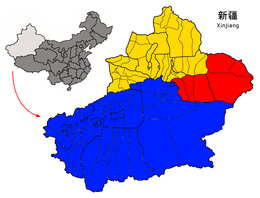
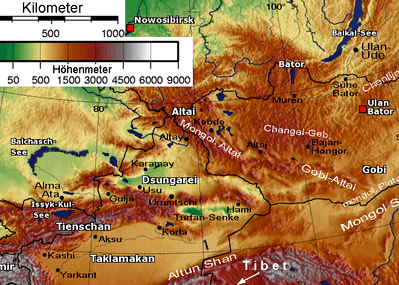
Xinjiang consists of two main geographically, historically, and ethnically distinct regions with different historical names, Dzungaria north of the Tianshan Mountains and the Tarim Basin south of the Tianshan Mountains, before Qing China unified them into one political entity called Xinjiang province in 1884. At the time of the Qing conquest in 1759, Dzungaria was inhabited by steppe dwelling, nomadic Tibetan Buddhist Oirat Mongol Dzungar people, while the Tarim Basin was inhabited by sedentary, oasis dwelling, Turkic speaking Muslim farmers, now known as the Uyghur people. They were governed separately until 1884. The native Uyghur name for the Tarim Basin is Altishahr.
The Qing dynasty was well aware of the differences between the former Buddhist Mongol area to the north of the Tianshan and Turkic Muslim south of the Tianshan, and ruled them in separate administrative units at first.[2] However, Qing people began to think of both areas as part of one distinct region called Xinjiang .[3] The very concept of Xinjiang as one distinct geographic identity was created by the Qing and it was originally not the native inhabitants who viewed it that way, but rather it was the Chinese who held that point of view.[4] During the Qing rule, no sense of "regional identity" was held by ordinary Xinjiang people; rather, Xinjiang's distinct identity was given to the region by the Qing, since it had distinct geography, history and culture, while at the same time it was created by the Chinese, multicultural, settled by Han and Hui, and separated from Central Asia for over a century and a half.[5]
In the late 19th century, it was still being proposed by some people that two separate parts be created out of Xinjiang, the area north of the Tianshan and the area south of the Tianshan, while it was being argued over whether to turn Xinjiang into a province.[6]
In ancient China, the area was known as "Xiyu" or "Western Regions", a name that became prevalent in Chinese records after the Han Dynasty took control of the region.[1][7] For the Uyghurs, the traditional name of the Tarim Basin in southern Xinjiang was Altishahr, which means "six cities" in the Uyghur language. The region of Dzungaria in northern Xinjiang was named after its native inhabitants, the Dzungar Mongols.
The name "East Turkestan" was created by the Russian Sinologist Nikita Bichurin to replace the term "Chinese Turkestan" in 1829.[8] "East Turkestan" was used traditionally to only refer to the Tarim Basin, and not Xinjiang as a whole, with Dzungaria being excluded from the area consisting of "East Turkestan".
After the Qing dynasty reconquered this region in 1884, the area was designated Xinjiang, which was used to refer to any area of a former Chinese empire that had been previously lost but was regained by the Qing, but eventually meant this northwestern Xinjiang alone.[9] In the Uyghur language, Xinjiang is considered more center than northwestern in orientation.[10]
Early Caucasian Inhabitants
According to J. P. Mallory and Victor H. Mair, the Chinese describe the existence of "white people with long hair" or the Bai people in the Shan Hai Jing, who lived beyond their northwestern border.[11]
The well preserved Tarim mummies with Caucasoid features, often with reddish or blond hair, today displayed at the Ürümqi Museum and dated to the 2nd millennium BC, have been found in the same area of the Tarim Basin. Various nomadic tribes, such as the Yuezhi, Saka, and Wusun were probably part of the migration of Indo-European speakers who were settled in eastern Central Asia (possibly as far as Gansu) at that time. The Ordos culture in northern China east of the Yuezhi, is another example, yet skeletal remains from the Ordos culture found have been predominantly Mongoloid. By the time the Han dynasty under Emperor Wu (r. 141-87 BC) wrestled the Western Regions of the Tarim Basin away from its previous overlords, the Xiongnu, it was inhabited by various peoples, including Indo-European Tocharians in Turfan and Kucha and Indo-Iranian Saka peoples centered around Kashgar and Khotan.[12]
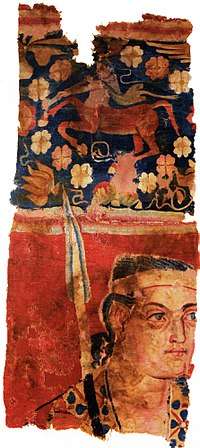

Righthand image: Two Buddhist monks on a mural of the Bezeklik Thousand Buddha Caves near Turpan, Xinjiang, China, 9th century AD; although Albert von Le Coq (1913) assumed the blue-eyed, red-haired monk was a Tocharian,[13] modern scholarship has identified similar Caucasian figures of the same cave temple (No. 9) as ethnic Sogdians,[14] an Eastern Iranian people who inhabited Turfan as an ethnic minority community during the phases of Tang Chinese (7th-8th century) and Uyghur rule (9th-13th century).[15]
Chinese accounts
The first reference to the nomadic Yuezhi was in 645 BC by Guan Zhong in his Guanzi 管子 (Guanzi Essays: 73: 78: 80: 81). He described the Yuzhi 禺氏, or Niuzhi 牛氏, as a people from the north-west who supplied jade to the Chinese from the nearby mountains of Yuzhi 禺氏 at Gansu.[16] The supply of jade from the Tarim Basin[17] from ancient times is well documented archaeologically: "It is well known that ancient Chinese rulers had a strong attachment to jade. All of the jade items excavated from the tomb of Fuhao of the Shang dynasty by Zheng Zhenxiang, more than 750 pieces, were from Khotan in modern Xinjiang. As early as the mid-first millennium BC the Yuezhi engaged in the jade trade, of which the major consumers were the rulers of agricultural China." (Liu (2001), pp. 267–268).
The nomadic tribes of the Yuezhi are documented in Chinese historical accounts, in particular the 2nd-1st century BC "Records of the Great Historian", or Shiji, by Sima Qian. According to these accounts:
- "The Yuezhi originally lived in the area between the Qilian or Heavenly Mountains (Tian Shan) and Dunhuang, but after they were defeated by the Xiongnu they moved far away to the west, beyond Dayuan, where they attacked and conquered the people of Daxia and set up the court of their king on the northern bank of the Gui [= Oxus] River. A small number of their people who were unable to make the journey west sought refuge among the Qiang barbarians in the Southern Mountains, where they are known as the Lesser Yuezhi."[18]
According to Han accounts, the Yuezhi "were flourishing" during the time of the first great Chinese Qin emperor, but were regularly in conflict with the neighbouring tribe of the Xiongnu to the northeast.
Roman accounts
Pliny the Elder, Chap XXIV "Taprobane") reports a curious description of the Seres (in the territories of northwestern China) made by an embassy from Taprobane (Ceylon) to Emperor Claudius, saying that they "exceeded the ordinary human height, had flaxen hair, and blue eyes, and made an uncouth sort of noise by way of talking", suggesting they may be referring to the ancient Caucasian populations of the Tarim Basin.
Genetic evidence
Modern genetic analysis suggests that aboriginal inhabitants had a high proportion of DNA of European origin.[19]
At the cemetery in Sampul (山普拉), ~14 km (8.7 mi) from the archaeological site of Khotan in Lop County, Xinjiang,[20] where Hellenistic art such as the Sampul tapestry has been found (its provenance most likely from the nearby Greco-Bactrian Kingdom),[21] the local inhabitants buried their dead there from roughly 217 BC to 283 AD.[22] DNA analysis of the human remains has revealed genetic affinities to peoples from the Caucasus, specifically a maternal lineage linked to Ossetians and Iranians, as well as an Eastern-Mediterranean paternal lineage.[20][23] Seeming to confirm this link, from historical accounts it is known that Alexander the Great, who married a Sogdian woman from Bactria named Roxana,[24][25][26] encouraged his soldiers and generals to marry local women; consequentially the later kings of the Seleucid Empire and Greco-Bactrian Kingdom had a mixed Persian-Greek ethnic background.[27][28][29][30]
In 2009, the remains of individuals found at the Xiaohe Tomb complex were analyzed for Y-DNA and mtDNA markers. The study found that while Y-DNA corresponded to West Eurasian populations, the mtDNA haplotypes were an admixture of East Asian and European origin.[31] The geographic location of where this admixing took place is suggested to be somewhere in Southern Siberia before these people moved into the Tarim Basin. Xiaohe is the oldest archaeological site yielding human remains discovered in the Tarim Basin to date.
Some Uyghur scholars claim modern Uyghurs descent from both the Turkic Uyghurs and the pre-Turkic Tocharians (Yuezhi), and relatively fair hair and eyes, as well as other so-called 'Caucasoid' physical traits, are not uncommon among Uyghurs. Genetic analyses suggest West Eurasian ("Caucasoid") maternal contribution to Uyghurs is 42.6% and the paternal between 43.9% and 61.2%. The estimation of European component in modern Uyghur population ranged from 30 to 60%.[32]
Struggle between Han dynasty and Xiongnu
.png)
.svg.png)
Traversed by the Northern Silk Road,[33] Western Regions is the Chinese name for the Tarim and Dzungaria regions of what is now northwest China. At the beginning of the Han dynasty (206 BC - AD 220), the region was subservient to the Xiongnu, a powerful nomadic people based in modern Mongolia. In the 2nd century BC, The Han Dynasty made preparations for war when the Emperor Wu of Han dispatched the explorer Zhang Qian to explore the mysterious kingdoms to the west and to form an alliance with the Yuezhi people in order to combat the Xiongnu. As a result of these battles, the Chinese controlled the strategic region from the Ordos and Gansu corridor to Lop Nor. They succeeded in separating the Xiongnu from the Qiang peoples to the south, and also gained direct access to the Western Regions. Han China sent Zhang Qian as an envoy to the states in the region, beginning several decades of struggle between the Xiongnu and Han China over dominance of the region, eventually ending in Chinese success. In 60 BC Han China established the Protectorate of the Western Regions (西域都護府) at Wulei (烏壘; near modern Luntai) to oversee the entire region as far west as the Pamir. This became the first sign of Han Chinese rule in Central Asia, the sovereignty of Han dynasty expanded into Central Asia. Tarim Basin and Indo-European kingdoms was under the control of Han dynasty and was influenced by Han Chinese emperors.
During the usurpation of Wang Mang in China, the dependent states of the protectorate rebelled and returned to Xiongnu domination in AD 13. Over the next century, Han China conducted several expeditions into the region, re-establishing the protectorate from 74-76, 91-107, and from 123 onward. After the fall of the Han dynasty (220), the protectorate continued to be maintained by Cao Wei (until 265) and the Western Jin Dynasty (from 265 onwards).
Uyghur nationalist historians such as Turghun Almas claim that Uyghurs were distinct and independent from Chinese for 6000 years, and that all non-Uyghur peoples are non-indigenous immigrants to Xinjiang.[34] However, the Han Dynasty (206 BCE–220 CE) established military colonies (tuntian) and commanderies (duhufu) to control Xinjiang from 120 BCE, while the Tang dynasty (618-907) also controlled much of Xinjiang until the An Lushan rebellion.[35] Chinese historians refute Uyghur nationalist claims by pointing out the 2000-year history of Han settlement in Xinjiang, documenting the history of Mongol, Kazakh, Uzbek, Manchu, Hui, Xibo indigenes in Xinjiang, and by emphasizing the relatively late "westward migration" of the Huigu (equated with "Uyghur" by the PRC government) people from Mongolia the 9th century.[34] The name "Uyghur" was associated with a Buddhist people in the Tarim Basin in the 9th century, but completely disappeared by the 15th century, until it was revived by the Soviet Union in the 20th century.[36]
A succession of different kingdoms
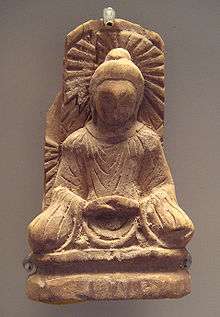
The Western Jin Dynasty succumbed to successive waves of invasions by nomads from the north at the beginning of the 4th century. The short-lived non-Han Chinese kingdoms that ruled northwestern China one after the other, including Former Liang, Former Qin, Later Liang, and Western Liáng, all attempted to maintain the protectorate, with varying extents and degrees of success. After the final reunification of northern China under the Northern Wei empire, its protectorate controlled what is now the southeastern third of Xinjiang. Local states such as Kashgar (Shule Kingdom), Hotan (Yutian), Kucha (Guizi) and Cherchen (Qiemo) controlled the western half, while the central region around Turpan was controlled by Gaochang (later known as Qara-hoja), remnants of a Xiongnu state Northern Liang that once ruled part of what is now Gansu province in northwestern China.
Gokturk tribes
In the late 5th century the Tuyuhun and the Rouran asserted power in southern and northern Xinjiang, respectively, and the Chinese protectorate was lost again. In the 6th century the Turks began to emerge in the Altay region, subservient to the Rouran. Within a century they had defeated the Rouran and established a vast Turkic Khaganate, stretching over most of Central Asia past both the Aral Sea in the west and Lake Baikal in the east. In 583 the Gokturks split into western and eastern halves, with Xinjiang coming under the western half. In 609, China under the Sui Dynasty defeated the Tuyuhun, forced him to take refuge in Qilian mountains.
Tang dynasty and struggle with Tibetan Empire

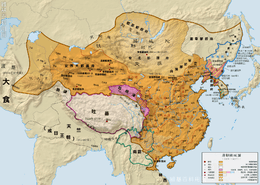
Starting from the 620's and 630's, Chinese Tang dynasty conducted a series of expeditions against the Eastern Turks.[37] By 640, military campaigns were dispatched against the Western Turkic Khaganate, and their vassals, the oasis states of southern Xinjiang.[38] The campaigns against the oasis states began under Emperor Taizong with the annexation of Gaochang in 640.[39] The nearby kingdom of Karasahr was captured by the Tang in 644 and the kingdom of Kucha was conquered in 649.[40]
The expansion into Central Asia continued under Taizong's successor, Emperor Gaozong, who dispatched an army in 657 led by Su Dingfang against the Western Turk qaghan Ashina Helu. Ashina's defeat strengthened Tang rule in southern Xinjiang and brought the regions formerly controlled by the khaganate into the Tang empire.[40] The military expedition included 10,000 horsemen supplied by the Uyghurs, who were close allies of the Tang.[40] The Uyghurs had allied with the Tang ever since the dynasty supported their revolt against the reign of the Xueyantuo, a tribe of Tiele people.[41] Xinjiang was administered through the Anxi Protectorate (安西都護府; "Protectorate Pacifying the West") and the Four Garrisons of Anxi.
Tang hegemony beyond the Pamir Mountains in modern Tajikistan and Afghanistan ended with revolts by the Turks, but the Tang retained a military presence in Xinjiang. These holdings were later invaded by the Tibetan Empire to the south, and Xinjiang alternated between Tang and Tibetan rule as they competed for control of Central Asia.[42] In 662 a rebellion broke out and Tang army was sent to control the situation, but was badly defeated by the Tibetans in the south of Kashgar. After defeating Tang in 670, the Tibetans gained control of the whole region and completely subjugated Kashgar in 676-8 and retained possession until 692, then China regained control of all southern Xinjiang, and retained it for the next fifty years. 728, the local king of Kashgar was awarded a brevet by the Tang emperor. During the devastating Anshi Rebellion, Tibetans invaded Tang China on a wide front from Xinjiang to Yunnan, sacking the Tang capital in 763, and taking control of southern Xinjiang.
A significant milestone of the Tang period of Xinjiang was that it marked the end of Indo-European influence in Xinjiang.[39] This was partially spurred by Chinese policies, which unintentionally sped the turkification of Xinjiang,[42] rather than the sinification that had occurred in other territories conquered by the Tang.[43] The Tang dynasty recruited a large number of Turkic soldiers and generals, and the Chinese garrisons of Xinjiang were for the most part staffed by Turks rather than those of the Han ethnicity. Xinjiang was beginning its transition into a region that is linguistically and culturally Turko-Mongolic, which it still is to this day.[42]
Tang dynasty and Uyghur Khanate
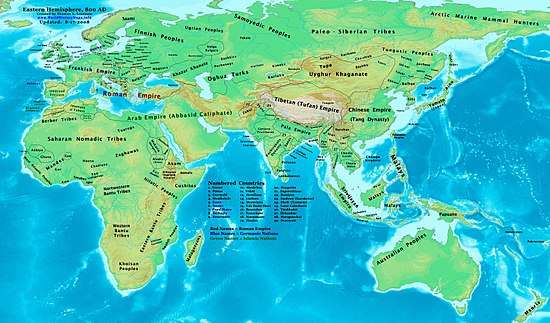
By 745 the Uyghur Khanate stretched from the Caspian Sea to present-day Mongolia and lasted from 745 to 840. After the Battle of Talas in 751, Uyghur Khanate took control of northern Xinjiang, as well as much of Central Asia, including Outer Mongolia, where their empire originated. It was also during this time that Tang China started a process of withdrawal from Central Asia. Bayanchur Khan acted quickly and took over the fertile Tarim Basin as well[44] at about the same time that the Tibetan Empire extended to Xinjiang.
The Chinese defeat at the Battle of Talas combined with a series of rebellions, the largest being of An Lushan, forced the Chinese emperor to turn to Bayanchur Khan for assistance. Seeing this as an ideal opportunity to meddle in Chinese affairs, the Khagan agreed, quelling several rebellions and defeating an invading Tibetan army from the south. As a result, the Uyghurs received tribute from the Chinese and Bayanchur Khan was given the daughter of the Chinese Emperor to marry (princess Ningo).
In 762, in alliance with the Tang, Tengri Bögü (Chinese transcription Idigan) launched a campaign against the Tibetans. He recaptured for the Tang Emperor the western capital Luoyang. Khagan Tengri Bögü met with Manichaean priests from Iran while on campaign, and was converted to Manicheism, adopting it as the official religion of the Uyghur Empire.
In 779 Tengri Bögü, incited by sogdian traders, living in Ordu Baliq, planned an invasion of China to take advantage of the accession of a new emperor. Tengri Bögü's uncle, Tun Bagha Tarkhan opposed this plan, fearing it would result in Uyghur complete assimilation into Han-Chinese culture.
In 840, the Kyrgyz tribe invaded from the north with a force of around 80,000 horsemen. They sacked the Uyghur capital at Ordu Baliq, razing it to the ground. The Kyrgyz captured the Uyghur Khagan, Kürebir (Hesa) and promptly beheaded him. The Kyrgyz went on to destroy other Uyghur cities throughout their empire, burning them to the ground. The last legitimate khagan, Öge, was assassinated in 847, having spent his 6-year reign in fighting the Kyrgyz and the supporters of his rival Ormïzt, a brother of Kürebir. The Kyrgyz invasion destroyed the Uyghur Empire, causing a diaspora of Uyghur people across Central Asia.
Uyghur Khanate and Kara-Khanid Khanate
Both Tibet and the Uyghur Khanate declined in the mid-9th century. After the Uyghur Khanate in Mongolia had been smashed by the Kirghiz in 840, branches of the Uyghurs established themselves in Qocha (Karakhoja) and Beshbalik near today's Turfan and Urumchi. This Uyghur Kara-Khoja Kingdom would remain in eastern Xinjiang until the 14th century, though it would be subject to various overlords during that time.
The Kara-Khanid Khanate arose some time in the ninth century from a confederation of Turkic tribes living in Semirechye, Western Tian Shan (modern Kyrgyzstan), and Western Xinjiang (Kashgaria).[45] They later occupied Transoxania. The Karakhanids were made up mainly of the Karluks, Chigils and Yaghma tribes. The capital of Karakhanid Khanate was Balasaghun on the Chu River, later also Samarkand and Kashgar. The Kara-Khanids converted to Islam, whereas the Uyghur state in eastern Xinjiang remained Manicheaean, but later converted to Buddhism. Nestorian Christianity was also a prominent faith in their kingdom. The Turkic Muslim Karakhanid Khanate attacked and conquered the Buddhist Saka Kingdom of Khotan.
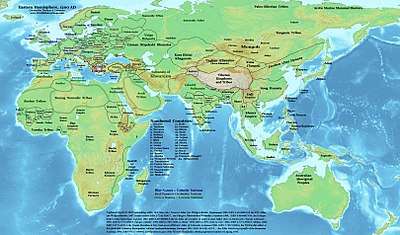
Islamicisation and Turkicisation of Xinjiang
| Turkification of the Tarim Basin | ||||||||
|---|---|---|---|---|---|---|---|---|
| ||||||||
| Belligerents | ||||||||
| Caucasian Indo-European Buddhist Tocharians and Eastern Iranian Sakas (Kingdom of Khotan) | Mongoloid Turkic Buddhist Uyghurs (Kingdom of Qocho) | Mongoloid Turkic Muslim Karluks (Kara-Khanid Khanate) | ||||||
| Commanders and leaders | ||||||||
|
Satok Bughra Khan Ali Arslan Musa Yusuf Qadir Khan | ||||||||
The historical area of what is modern day Xinjiang consisted of the distinct areas of the Tarim Basin and Dzungaria, and was originally populated by Indo-European Tocharian and Iranic Saka peoples who practiced the Buddhist religion. The area was subjected to Turkification and Islamification at the hands of invading Turkic Muslims.
Buddhist Uyghur migration into the Tarim Basin
The discovery of the Tarim mummies has created a stir in the Turkic-speaking Uighur population of the region, who claim the area has always belonged to their culture, while it was not until the 10th century when the Uighurs are said by scholars to have moved to the region from Central Asia.[46] American Sinologist Victor H. Mair claims that "the earliest mummies in the Tarim Basin were exclusively Caucasoid, or Europoid" with "east Asian migrants arriving in the eastern portions of the Tarim Basin around 3,000 years ago", while Mair also notes that it was not until 842 that the Uighur peoples settled in the area.[47]
Protected by the Taklamakan Desert from steppe nomads, elements of Tocharian culture survived until the 7th century, when the arrival of Turkic immigrants from the collapsing Uyghur Khaganate of modern-day Mongolia began to absorb the Tocharians to form the modern-day Uyghur ethnic group.[47]
Mongoloid DNA
The modern Uyghurs are now a mixed hybrid of Mongoloid (East Asian) and Caucasian.[48][49][50]



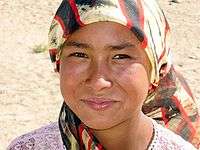
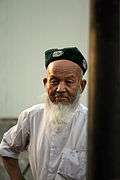
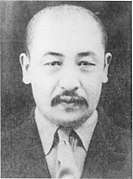
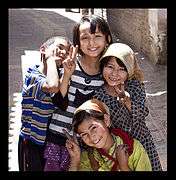
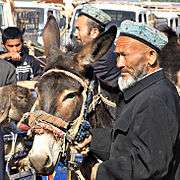
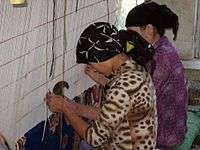
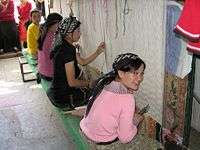

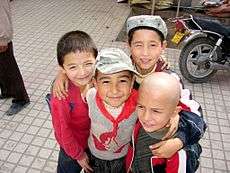
Images of Buddhist and Manichean Uyghurs
Professor James A. Millward described the original Uyghurs as physically Mongoloid, giving as an example the images in Bezeklik at temple 9 of the Uyghur patrons, until they began to mix with the Tarim Basin's original eastern Iranian inhabitants.[51]
Images of Buddhist and Manichean Turkic Uyghurs from the Bezeklik caves and Mogao grottoes. Buddhist murals at the Bezeklik Thousand Buddha Caves were damaged by local Muslim population whose religion proscribed figurative images of sentient beings, the eyes and mouths in particular were often gouged out. Pieces of murals were also broken off for use as fertilizer by the locals.[52]
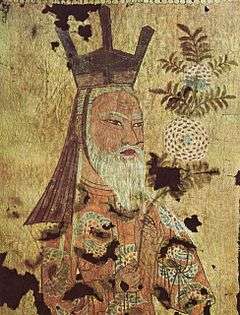
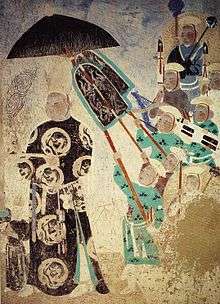



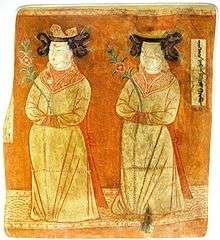


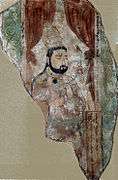

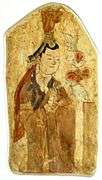
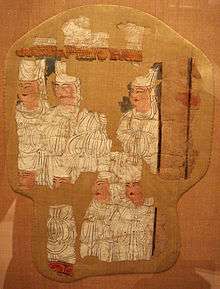

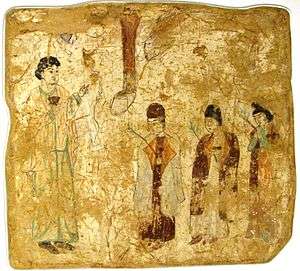
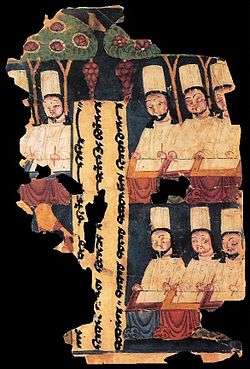
Turkic-Islamic Kara-Khanid conquest of Iranic Saka Buddhist Khotan
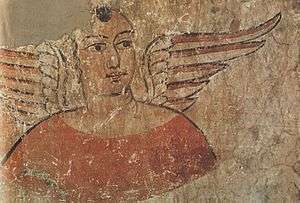
The Islamic attacks and conquest of the Buddhist cities east of Kashgar was started by the Turkic Karakhanid Satok Bughra Khan who in 966 converted to Islam and many tales emerged about the Karakhanid ruling family's war against the Buddhists, Satok Bughra Khan's nephew or grandson Ali Arslan was slain by the Buddhists during the war. Buddhism lost territory to Islam during the Karakhanid reign around the Kashgar area.[53] A long war ensued between Islamic Kashgar and Buddhist Khotan which eventually ended in the conquest of Khotan by Kashgar.[54]
Iranic Saka peoples originally inhabited Yarkand and Kashgar in ancient times. The Buddhist Iranic Saka Kingdom of Khotan was the only city-state that was not conquered yet by the Turkic Uyghur (Buddhist) and the Turkic Qarakhanid (Muslim) states and its ruling family used Indian names and the population were devout Buddhists. The Buddhist entitites of Dunhuang and Khotan had a tight-knit partnership, with intermarriage between Dunhuang and Khotan's rulers and Dunhuang's Mogao grottos and Buddhist temples being funded and sponsored by the Khotan royals, whose likenesses were drawn in the Mogao grottoes.[55] The rulers of Khotan were aware of the menace they faced since they arranged for the Mogao grottoes to paint a growing number of divine figures along with themselves. Halfway in the 10th century Khotan came under attack by the Qarakhanid ruler Musa, and in what proved to be a pivotal moment in the Turkification and Islamification of the Tarim Basin, the Karakhanid leader Yusuf Qadir Khan conquered Khotan around 1006.[55]
The Taẕkirah is a genre of literature written about Sufi Muslim saints in Altishahr. Written sometime in the period from 1700-1849, the Eastern Turkic language (modern Uyghur) Taẕkirah of the Four Sacrificed Imams provides an account of the Muslim Karakhanid war against the Khotanese Buddhists, containing a story about Imams, from Mada'in city (possibly in modern-day Iraq) came 4 Imams who travelled to help the Islamic conquest of Khotan, Yarkand, and Kashgar by Yusuf Qadir Khan, the Qarakhanid leader.[56] Accounts of the battles waged by the invading Muslims upon the indigenous Buddhists takes up most of the Taẕkirah with descriptions such as "blood flows like the Oxus", "heads litter the battlefield like stones" being used to describe the murderous battles over the years until the "infidels" were defeated and driven towards Khotan by Yusuf Qadir Khan and the four Imams, but the Imams were assassinated by the Buddhists prior to the last Muslim victory so Yusuf Qadir Khan assigned Khizr Baba, who was born in Khotan but whose mother originated from western Turkestan's Mawarannahr, to take care of the shrine of the 4 Imams at their tomb and after Yusuf Qadir Khan's conquest of new land in Altishahr towards the east, he adopted the title "King of the East and China".[56] Due to the Imams deaths in battle and burial in Khotan, Altishahr, despite their foreign origins, they are viewed as local saints by the current Muslim population in the region.[56]
Muslim works such as Ḥudūd al-ʿĀlam contained anti-Buddhist rhetoric and polemic against Buddhist Khotan,[57] aimed at "dehumanizing" the Khotanese Buddhists, and the Muslims Kara-Khanids conquered Khotan just 26 years following the completion of Ḥudūd al-ʿĀlam.[58]
Muslims gouged the eyes of Buddhist murals along Silk Road caves and Kashgari recorded in his Turkic dictionary an anti-Buddhist poem/folk song.[59]
Satuq Bughra Khan and his son directed endeavors to proselytize Islam among the Turks and engage in military conquests.[60] The Islamic conquest of Khotan led to alarm in the east and Dunhuang's Cave 17, which contained Khotanese literary works, was closed shut possibly after its caretakers heard that Khotan's Buddhist buildings were razed by the Muslims, the Buddhist religion had suddenly ceased to exist in Khotan.[61]
In 1006, the Muslim Kara-Khanid ruler Yusuf Kadir (Qadir) Khan of Kashgar conquered Khotan, ending Khotan's existence as an independent state. The war was described as a Muslim Jihad (holy war) by the Japanese Professor Takao Moriyasu. The Karakhanid Turkic Muslim writer Mahmud al-Kashgari recorded a short Turkic language poem about the conquest:
English translation:
We came down on them like a flood,
We went out among their cities,
We tore down the idol-temples,
We shat on the Buddha's head!
In Turkic:
kälginläyü aqtïmïz
kändlär üzä čïqtïmïz
furxan ävin yïqtïmïz
burxan üzä sïčtïmïz
Idols of "infidels" were subjected to desecration by being defecated upon by Muslims when the "infidel" country was conquered by the Muslims, according to Muslim tradition (it is not Muslim tradition).[64]
Maps of the Turkicisation of Xinjiang
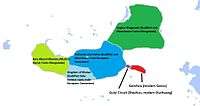
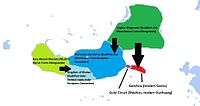
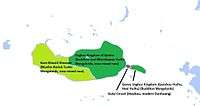
Turkic ultra-nationalist revisionism
Some Uyghur ultra-nationalist revisionists, worried at the prospect that they are descendants of migrants into Xinjiang and could be seen as invaders and not the indigenous inhabitants, have sought to revise history like Turghun Almas in his book Uyghurlar, claiming that Turkic Uyghurs were always natives of Xinjiang, claiming that the Tocharian Tarim mummies were Uyghurs, claiming Uyghurs invented gunpowder, paper, compass, printing, and that Uyghur civilization is 6,000 years old and is the origin of all world civilization.[65][66]
The claims of these "Uyghur nationalist historians", which the majority of Uyghurs believe in, are not backed up by actual evidence.[67][68] The belief that they were native to the Tarim Basin is held by most Uyghurs.[69]
Qurban Wäli is another ultra-nationalist Uyghur who engaged in historical revisionism and claimed Uyghur civilization is 6,000 years old and native to Xinjiang.[70]
The Chinese government pointed out that it was in the 9th century when Uyghurs migrated into Xinjiang,[71][72] but since many Uyghurs believe in the opposite of whatever the Chinese government says, they eagerly believe books written by Uyghur authors which glorify their past and assume what authors like Almas write is automatically true.[73]
Historians say that it was in the 9th century when Uyghurs moved into Xinjiang.[74][75]
Legacy of Han and Tang Chinese rule in Xinjiang
Coins with both Chinese and Karoshthi inscriptions have been found in the southern Tarim Basin.[76]
It was the An Lushan Rebellion and not the defeat at Talas that ended the Tang Chinese presence in Central Asia and forced them to withdraw from Xinjiang- the significance of Talas was overblown, because the Arabs did not proceed any further after the battle.[77] Because the Arabs did not proceed to Xinjiang at all, the battle was of no importance strategically, it was An Lushan's rebellion which ended up forcing the Tang Chinese out of Central Asia.[78] Despite the conversion of some Karluk Turks after the Battle of Talas, the majority of Karluks did not convert to Islam until the mid 10th century under Sultan Satuq Bughra Khan when they established the Kara-Khanid Khanate.[79][80][81][82][83][84] This was long after the Tang dynasty was gone from Central Asia.
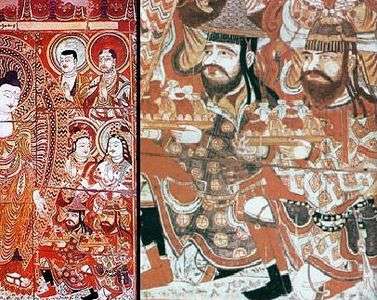
The military victories of the Tang in the western regions and Central Asia have been offered as explanations as to why western peoples referred to China by the name "House of Tang" (Tangjia) and another theory was suggested that China was called "Han" because of the Han dynasty military victories against peoples in the north, and the Turkic word for China, "Tamghaj" has been possibly derived from Tangjia instead of Tabgatch (Tuoba).[85]
In the Chu valley in Central Asia Tang dynasty era Chinese coins continued to be copied and minted after the Chinese left the area.[86]
An indelible impression was left on eastern Xinjiang's administration and culture in Turfan by the Chinese Tang rule which consisted of settlements, and military farms in addition to the spread of Chinese influence such as the sancai three colour glaze in Central Asia and Western Eurasia, in Xinjiang there was continued circulation of Chinese coins.[87]
Turkic Empires after the Tang gained prestige by connecting themselves with north Chinese states with the Qara-Khitay and Qara-Khanid khans using the title of "Chinese emperor", Khitay was used by the Qara-Khitay and Tabghach was used by the Qarakhanids.[88] The entry into the previously Indo-European Soghdian and Tokharian speaking Central Eurasia and Xinjiang of tribes of Turkic speaking origin and the started of Turkicisation originate in the 7th century with the disintegration of the Turkic Khaganate, resulting in Eurasia being populated by many peoples who consider themselves Turks.
Two different branches, the junior Bughra (bull camel) and the Arslan (lion) formed the Qarakhanid royal family. The title "Khan of China" (Tamghaj Khan) (تمغاج خان) was used by the Qarakhanid rulers.[89] The Qarakhanids were the ones who are responsible for the modern Uyghur population being Muslim and the Qarakhanids were converted when Satuq Bughra Khan converted to Islam after contacts with the Muslim Samanids.
Bughra Khan was overthrown by his nephew Satuq when Satuq converted to Islam, the Arslan Khans were also toppled and Balasaghun taken by Satuq, with the conversion of the Qarakhanid Turk population to Islam following Satuq's accession to power and the spread of Islam among the Qarakhanid Turks led to the conquest of Transoxiana and the Samanids by the Qarakhanids and the Qarakhanids were the people who bequeathed the Islamic religion to the modern Uyghurs while the modern Uyghurs adopted the modern name of their ethnic group from the Uyghur Qocho Kingdom and Uyghur Empire.[90]
The Turkic Qarakhanid and Uyghur Qocho Kingdoms were both states founded by invaders while the native populations of the region were Iranic and Tocharian peoples along with some Chinese in Qocho and Indians, who married and mixed with the Turkic invaders, and prominent Qarakhanid people such as Mahmud Kashghari hold a high position among modern Uyghurs.[91]
Kashghari viewed the least Persian mixed Turkic dialects as the "purest" and "the most elegant".[92]
Persian, Arab and other western Asian writers called China by the name "Tamghaj".[93]
The Qarakhanid ruler of Kashgar was called Tamghaj Khan, while the Khitan ruler was called the Khan of Chīn, some Khitans migrated into western areas like the Qarakhanid state even before the establishment of the Kara-Khitan state.[94]
During the Liao dynasty Han Chinese lived in Kedun, situated in present-day Mongolia.[95]
In 1124 the migration of the Khitan under Yelü Dashi included a big part of the Kedun population, which consisted of Han Chinese, Bohai, Jurchen, Mongol tribes, Khitan, in addition to the Xiao consort clan and the Yelü royal family on the march to establish the Qara-Khitan.[96]
The Khitan Qara-Khitai empire in Central Asia kept Chinese characteristics in their state since the Chinese characteristics appealed to the Muslim Central Asians and helped validate Qara Khita rule over them, despite the fact that Han Chinese were to be found among the population of the Qara Khitan because it was comparatively small so it is clear that the Chinese characteristics were not kept to appease them, the Mongols later moved more Han Chinese into Besh Baliq, Almaliq and Samarqand in Central Asia to work as aristans and farmers.[97]
The Qara Khitai used the "image of China" to legitimize their ruler to the Central Asian Muslims since China had a good reputation at the time among Central Asian Muslims before the Mongol invasions, it was viewed as extremely civilized, known for its unique script, its expert artisans were well known, justice and religious tolerance were among the virtues attributed to Chinese despite their idol worship and the Turk, Arab, Byzantium, Indian rulers, and the Chinese emperor were known as the world's "five great kings", the memory of Tang China was engraved into the Muslim perception so their continued to view China through the lens of the Tang dynasty and anachronisms appeared in Muslim writings due to this even after the end of the Tang, China was known as chīn (چين) in Persian and as ṣīn (صين) in Arabic while the Tang dynasty capital Changan was known as Ḥumdān (حمدان).[98]
Muslim Muslim writers like Marwazī and Mahmud Kashghārī had more up to date information about China in their writings, Kashgari viewed Kashgar as part of China. Ṣīn [i.e., China] is originally three fold; Upper, in the east which is called Tawjāch; middle which is Khitāy, lower which is Barkhān in the vicinity of Kashgar. But know Tawjāch is known as Maṣīn and Khitai as Ṣīn" China was called after the Toba rulers of the Northern Wei by the Turks, pronounced by them as Tamghāj, Tabghāj, Tafghāj or Tawjāch. India introduced the name Maha Chin (greater China) which caused the two different names for China in Persian as chīn and māchīn (چين ماچين) and Arabic ṣīn and māṣīn (صين ماصين), Southern China at Canton was known as Chin while Northern China's Changan was known as Machin, but the definition switched and the south was referred to as Machin and the north as Chin after the Tang dynasty, Tang China had controlled Kashgar since of the Tang's Anxi protectorate's "Four Garrisons" seats, Kashgar was among them, and this was what led writers like Kashghārī to place Kashgar within the definition of China, Ṣīn, whose emperor was titled as Tafghāj or Tamghāj, Yugur (yellow Uighurs or Western Yugur) and Khitai or Qitai were all classified as "China" by Marwazī while he wrote that Ṣīnwas bordered by placed SNQU and Maṣīn.[99] Machin, Mahachin, Chin, and Sin were all names of China.[100]
Muslim writers like Marwazī wrote that Transoxania was a former part of China, retaining the legacy of Tang Chinese rule over Transoxania in Muslim writings, In ancient times all the districts of Transoxania had belonged to the kingdom of China [Ṣīn], with the district of Samarqand as its centre. When Islam appeared and God delivered the said district to the Muslims, the Chinese migrated to their [original] centers, but there remained in Samarqand, as a vestige of them, the art of making paper of high quality. And when they migrated to Eastern parts their lands became disjoined and their provinces divided, and there was a king in China and a king in Qitai and a king in Yugur., Muslim writers viewed the Khitai, the Gansu Uighur Kingdom and Kashgar as all part of "China" culturally and geographically with the Muslim Central Asians retaining the legacy of Chinese rule in Central Asia by using titles such as "Khan of China" (تمغاج خان) (Tamghaj Khan or Tawgach) in Turkic and "the King of the East in China" (ملك المشرق (أو الشرق) والصين) (malik al-mashriq (or al-sharq) wa'l-ṣīn) in Arabic which were titles of the Muslim Qarakhanid rulers and their Qarluq ancestors.[101][102]
The title Malik al-Mashriq wa'l-Ṣīn was bestowed by the 'Abbāsid Caliph upon the Tamghaj Khan, the Samarqand Khaqan Yūsuf b. Ḥasan and after that coins and literature had the title Tamghaj Khan appear on them and were continued to be used by the Qarakhanids and the Transoxania-based Western Qarakhanids and some Eastern Qarakhanid monarchs, so therefore the Kara-Khitan (Western Liao)'s usage of Chinese things such as Chinese coins, the Chinese writing system, tablets, seals, Chinese art products like porcelein, mirrors, jade and other Chinese customs were designed to appearl to the local Central Asian Muslim population since the Muslims in the area regarded Central Asia as former Chinese territories and viewed links with China as prestigious and Western Liao's rule over Muslim Central Asia caused the view that Central Asia was a Chinese territory to reinforce upon the Muslims; "Turkestan" and Chīn (China) were identified with each other by Fakhr al-Dīn Mubārak Shāh with China being identified as the country where the cities of Balāsāghūn and Kashghar were located.[103]
The Liao Chinese traditions and the Qara Khitai's clinging helped the Qara Khitai avoid Islamization and conversion to Islam, the Qara Khitai used Chinese and Inner Asian features in their administrative system.[104]
Muslim writers wrote that "Tamghājī silver coins" (sawmhā-yi ṭamghājī) were present in Balkh while tafghājī was used by the writer Ḥabībī, the Qarakhānid leader Böri Tigin (Ibrāhīm Tamghāj Khān) was possibly the one who minted the coins.[105]
The relationship to China was used by the Qara-Khanids to enhace their standing since Central Asian Muslims associated prestige and grandeur with China so the Arabic title "the king of the East and China" (malek al-mašreq wa'l-Ṣin) and the Turkic title "Khan of China" Ṭamḡāj Khan was extensively employed by Khans of the Qara-khanids.[106]
Although in modern Urdu Chin means China, Chin referred to Central Asia in Muhammad Iqbal's time, which is why Iqbal wrote that "Chin is ours" (referring to the Muslims) in his song Tarana-e-Milli.[107]
Aladdin, an Arabic Islamic story which is set in China, may have been referring to Central Asia.[108]
In the Persian epic Shahnameh the Chin and Turkestan are regarded as the eame, the Khan of Turkestan is called the Khan of Chin.[109][110][111]
The Tang Chinese reign over Qocho and Turfan and the Buddhist religion left a lasting legacy upon the Buddhist Uyghur Kingdom of Qocho with the Tang presented names remaining on the more than 50 Buddhist temples with Emperor Tang Taizong's edicts stored in the "Imperial Writings Tower " and Chinese dictionaries like Jingyun, Yuian, Tang yun, and da zang jing (Buddhist scriptures) stored inside the Buddhist temples and Persian monks also maintained a Manichaean temple in the Kingdom., the Persian Hudud al-'Alam uses the name "Chinese town" to called Qocho, the capital of the Uyghur kingdom.[112]
The Turfan Buddhist Uighurs of the Kingdom of Qocho continued to produce the Chinese Qieyun rime dictionary and developed their own pronunciations of Chinese characters, left over from the Tang influence over the area.[113]
The modern Uyghur linguist Abdurishid Yakup pointed out that the Turfan Uyghur Buddhists studied the Chinese language and used Chinese books like Qianziwen (the thousand character classic) and Qieyun *(a rime dictionary) and it was written that "In Qocho city were more than fifty monasteries, all titles of which are granted by the emperors of the Tang dynasty, which keep many Buddhist exts as Tripitaka, Tangyun, Yupuan, Jingyin etc." [114]
In Central Asia the Uighurs viewed the Chinese script as "very prestigious" so when they developed the Old Uyghur alphabet, based on the Syriac script, they deliberately switched it to vertical like Chinese writing from its original horizontal position in Syriac.[115]
Qara Khitai
In 1132, remnants of the Liao dynasty from Manchuria and North China entered Xinjiang, fleeing the onslaught of the Jurchens into North China. They established an exile regime, the Qara Khitai, which became overlord over both Kara-Khanid-held and Uyghur State-held parts of the Tarim Basin for the next century. In 1208, a Naiman prince named Kuchlug fled his homeland after being defeated by the Mongols. He fled westward to the Qara Khitai, where he became an advisor. However, he rebelled three years later and usurped the throne of Qara Khitai. His regime proved to be short-lived however because the Mongols under Genghis Khan would soon invade Central Asia including the Qara Khitai.
Mongol Empire, Yuan dynasty and Chagatai Khanate
After Genghis Khan had unified the Mongols and began his advance west, the Uyghur state in the Turfan-Urumchi area offered its allegiance to the Mongol Empire in 1209, contributing taxes and troops to the Mongol imperial effort and worked as civil servants to the Mongols. In return, the Uyghur rulers retained control of their kingdom. In 1218, Genghis Khan's Mongol Empire captured what was once Qara Khitai's territories. After the break-up of the Mongol Empire into smaller khanates, most of modern-day Xinjiang was briefly controlled by the Yuan dynasty founded by Kublai Khan, the eastern division of the Mongol Empire based in modern-day Beijing. However, during the Kaidu–Kublai war fought between the Yuan and the Chagatai Khanate based in Central Asia under the leadership of Kaidu, most of Xinjiang was occupied by the Chagatai Khanate. This would last until the mid-14th century, when the Chagatai Khanate was divided into two.
Moghulistan
After the death of Qazan Khan in 1346, the Chagatai Khanate, which embraced both East and West Turkestan, was divided into western (Transoxiana) and eastern (Moghulistan) halves. Power in the western half devolved into the hands of several tribal leaders, most notably the Qara'unas. Khans appointed by the tribal rulers were mere puppets. In the east, Tughlugh Timur (1347–1363), an obscure Chaghataite adventurer, gained ascendancy over the nomadic Mongols, and converted to Islam. During his rein (and ruled until 1363), the moghuls were converted to Islam and slowly turkizised. In 1360, and again in 1361, he invaded the western half in the hope that he could reunify the khanate. At their height, the Chaghataite domains extended from the Irtysh River in Siberia down to Ghazni in Afghanistan, and from Transoxiana to the Tarim Basin.
Moghulistan embraced settled lands in Eastern Turkestan as well as nomad lands north of Tengri tagh. The settled lands were known at the time as Manglai Sobe or Mangalai Suyah, which translates as Shiny Land, or Advanced Land Which Faced the Sun. These lands included west and central Tarim oasis-cities, such as Khotan, Yarkand, Yangihisar, Kashgar, Aksu, and Uch Turpan; and hardly involved eastern Tangri Tagh oasis-cities, such as Kucha, Karashahr, Turpan and Kumul, where a local uyghur administration and buddhist population still existed. The nomadic areas comprised the present Kyrghyzstan and part of Kazakhstan, including Jettisu, the area of seven rivers.
Moghulistan existed around 100 years, and then split into two parts: Yarkand state (mamlakati Yarkand), with its capital at Yarkand, which embraced all the settled lands of Eastern Turkestan, and nomad Moghulistan, which embraced the nomad lands north of Tengri Tagh. The founder of Yarkand was Mirza Abu-Bakr, who was from the dughlat tribe. In 1465, he raised a rebellion, captured Yarkand, Kashgar, and Khotan, and declared himself an independent ruler, successfully repelling attacks by the Moghulistan rulers Yunus Khan and his son Akhmad Khan, or Ahmad Alaq, named Alach, "Slaughterer", for his war against the kalmyks.
Dughlat amirs had ruled the country that lay south of the Tarim Basin from the middle of the thirteenth century, on behalf of Chagatai Khan and his descendents, as their satellites. The first dughlat ruler, who received lands directly from the hands of Chagatai, was amir Babdagan or Tarkhan. The capital of the emirate was Kashgar, and the country was known as Mamlakati Kashgar. Although the emirate, representing the settled lands of Eastern Turkestan, was formally under the rule of the moghul khans, the dughlat amirs often tried to put an end to that dependence, and raised frequent rebellions, one of which resulted in the separation of Kashgar from Moghulistan for almost 15 years (1416–1435). Mirza Abu-Bakr ruled Yarkand for 48 years.[116]
Islamic conquest of the Buddhist Uighurs
| Islamification of the Tarim Basin | |||||||
|---|---|---|---|---|---|---|---|
| |||||||
| Belligerents | |||||||
| Turkic Muslim Chagatai Khanate | Turkic Buddhist Uyghurs (Kingdom of Qocho and Qara Del) | ||||||
| Commanders and leaders | |||||||
|
Khizr Khwaja Mansur | |||||||
Buddhism survived in Uyghurstan (Turfan and Qocho). during the Ming dynasty.[117]
The Buddhist Uyghurs of the Kingdom of Qocho and Turfan were converted to Islam by conquest during a ghazat (holy war) at the hands of the Muslim Chagatai Khizr Khwaja.[118]
Kara Del was a Mongolian ruled and Uighur populated Buddhist Kingdom. The Muslim Chagatai Khan Mansur invaded and used the sword to make the population convert to Islam.[119]
After being converted to Islam, the descendants of the previously Buddhist Uyghurs in Turfan failed to retain memory of their ancestral legacy and falsely believed that the "infidel Kalmuks" (Dzungars) were the ones who built Buddhist monuments in their area.[120][121]
According to Joseph Fletcher, For centuries Altishar had been 'the abod of Islam'. Its inhabitants lived under the obligation of Jihad.[122]
Maps of the Islamicisation of Xinjiang
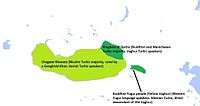
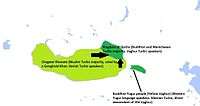

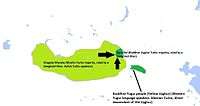
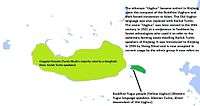
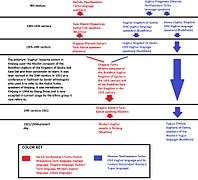
State of Yarkand
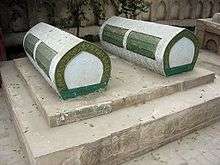
In May, 1514, Sultan Said Khan, grandson of Yunus Khan (ruler of Moghulistan between 1462 and 1487) and third son of Ahmad Alaq, made an expedition against Kashgar from Andijan with only 5000 men, and having captured the Yangi Hissar citadel, that defended Kashgar from south road, took the city, dethroning Mirza Abu-Bakr. Soon after, other cities of Eastern Turkestan — Yarkant, Khotan, Aksu, and Uch Turpan — joined him, and recognized Sultan Said Khan as ruler, creating a union of six cities, called Altishahr. Sultan Said Khan's sudden success is considered to be contributed to by the dissatisfaction of the population with the tyrannical rule of Mirza Abu-Bakr and the unwillingness of the dughlat amirs to fight against a descendant of Chagatai Khan, deciding instead to bring the head of the slain ruler to Sultan Said Khan. This move put an end to almost 300 years of rule (nominal and actual) by the Dughlat Amirs in the cities of West Kashgaria (1219–1514). He made Yarkand the capital of a state, "Mamlakati Yarkand" which lasted until 1678.
The Khojah Kingdom
In the 17th century, the Dzungars (Oirats, Kalmyks) established an empire over much of the region. Oirats controlled an area known as Grand Tartary or the Kalmyk Empire to Westerners, which stretched from the Great Wall of China to the Don River, and from the Himalayas to Siberia. A Sufi master Khoja Āfāq defeated Saidiye kingdom and took the throne at Kashgar with the help of the Oirat (Dzungar) Mongols. After Āfāq's death, the Dzungars held his descendants hostage. The Khoja dynasty rule in the Altishahr (Tarim Basin) region lasted until 1759.
Dzungar Khanate

The Mongolian Dzungar (also Zunghar; Mongolian: Зүүнгар Züüngar) was the collective identity of several Oirat tribes that formed and maintained one of the last nomadic empires. The Dzungar Khanate covered the area called Dzungaria and stretched from the west end of the Great Wall of China to present-day eastern Kazakhstan, and from present-day northern Kyrgyzstan to southern Siberia. Most of this area was only renamed "Xinjiang" by the Chinese after the fall of the Dzungar Empire. It existed from the early 17th century to the mid-18th century.
The Turkic Muslim sedentary people of the Tarim Basin were originally ruled by the Chagatai Khanate while the nomadic Buddhist Oirat Mongol in Dzungaria ruled over the Dzungar Khanate. The Naqshbandi Sufi Khojas, descendants of the Prophet Muhammad, had replaced the Chagatayid Khans as the ruling authority of the Tarim Basin in the early 17th century. There was a struggle between two factions of Khojas, the Afaqi (White Mountain) faction and the Ishaqi (Black Mountain) faction. The Ishaqi defeated the Afaqi, which resulted in the Afaqi Khoja inviting the 5th Dalai Lama, the leader of the Tibetan Buddhists, to intervene on his behalf in 1677. The 5th Dalai Lama then called upon his Dzungar Buddhist followers in the Dzungar Khanate to act on this invitation. The Dzungar Khanate then conquered the Tarim Basin in 1680, setting up the Afaqi Khoja as their puppet ruler.
Khoja Afaq asked the 5th Dalai Lama when he fled to Lhasa to help his Afaqi faction take control of the Tarim Basin (Kashgaria).[123] The Dzungar leader Galdan was then asked by the Dalai Lama to restore Khoja Afaq as ruler of Kashgararia.[124] Khoja Afaq collaborated with Galdan's Dzungars when the Dzungars conquered the Tarim Basin from 1678-1680 and set up the Afaqi Khojas as puppet client rulers.[125][126][127] The Dalai Lama blessed Galdan's conquest of the Tarim Basin and Turfan Basin.[128]
67,000 patman (each patman is 4 piculs and 5 pecks) of grain 48,000 silver ounces were forced to be paid yearly by Kashgar to the Dzungars and cash was also paid by the rest of the cities to the Dzungars. Trade, milling, and distilling taxes, corvée labor,saffron, cotton, and grain were also extracted by the Dzungars from the Tarim Basin. Every harvest season, women and food had to be provided to Dzungars when they came to extract the taxes from them.[129]
When the Dzungars levied the traditional nomadic Alban poll tax upon the Muslims of Altishahr, the Muslims viewed it as the payment of jizyah (a tax traditionally taken from non-Muslims by Muslim conquerors).[130]
After being converted to Islam, the descendants of the previously Buddhist Uyghurs in Turfan failed to retain memory of their ancestral legacy and falsely believed that the "infidel Kalmuks" (Dzungars) were the ones who built Buddhist monuments in their area.[120][121]
Qing dynasty
The Qing dynasty, established by the Manchus in China, gained control over eastern Xinjiang as a result of a long struggle with the Dzungars that began in the seventeenth century. In 1755, the Qing Empire attacked Ghulja, and captured the Dzungar Khan. Over the next two years, the Manchus and Mongol armies of the Qing destroyed the remnants of the Dzungar Khanate, and attempted to divide the Xinjiang region into four sub-Khanates under four chiefs. Similarly, the Qing made members of a clan of Sufi shaykhs known as the Khojas, rulers in the western Tarim Basin, south of the Tianshan Mountains. After Oirat nobel Amursana's request to be declared Dzungar khan went unanswered, he led a revolt against the Qing. Over the next two years, Qing armies destroyed the remnants of the Dzungar khanate.
The Turkic Muslims of the Turfan and Kumul Oases then submitted to the Qing dynasty of China, and asked China to free them from the Dzungars. The Qing accepted the rulers of Turfan and Kumul as Qing vassals. The Qing dynasty waged war against the Dzungars for decades until finally defeating them and then Qing Manchu Bannermen carried out the Dzungar genocide, nearly wiping them from existence and depopulating Dzungaria. The Qing then freed the Afaqi Khoja leader Burhan-ud-din and his brother Khoja Jihan from their imprisonment by the Dzungars, and appointed them to rule as Qing vassals over the Tarim Basin. The Khoja brothers decided to renege on this deal and declare themselves as independent leaders of the Tarim Basin. The Qing and the Turfan leader Emin Khoja crushed their revolt and China then took full control of both Dzungaria and the Tarim Basin by 1759.
After perpetrating wholesale massacres on the native Dzungar Oirat Mongol population in the Dzungar genocide, in 1759, the Qing finally consolidated their authority by settling Chinese emigrants, together with a Manchu Qing garrison. The Qing put the whole region under the rule of a General of Ili, headquartered at the fort of Huiyuan (the so-called "Manchu Kuldja", or Yili), 30 km (19 mi)west of Ghulja (Yining). The Qing Qianlong Emperor conquered the Dzungarian plateau and the Tarim Basin, bringing the two separate regions, respectively north and south of the Tianshan mountains, under his rule as Xinjiang.[131] The south was inhabited by Turkic Muslims (Uyghurs) and the north by Dzungar Mongols.[132] The Dzungars were also called "Eleuths" or "Kalmyks".
The Qing identified their state as "China" (Zhongguo), and referred to it as "Dulimbai Gurun" in Manchu. The Qing equated the lands of the Qing state (including present-day Manchuria, Dzungaria in Xinjiang, Mongolia, and other areas) as "China" in both the Chinese and Manchu languages, defining China as a multi-ethnic state. The Qianlong Emperor compared his achievements with that of the Han and Tang ventures into Central Asia.[133] Qianlong's conquest of Xinjiang was driven by his mindfulness of the examples set by the Han and Tang[134] Qing scholars who wrote the official Imperial Qing gazetteer for Xinjiang made frequent references to the Han and Tang era names of the region.[135] The Qing conqueror of Xinjiang, Zhao Hui, is ranked for his achievements with the Tang dynasty General Gao Xianzhi and the Han dynasty Generals Ban Chao and Li Guangli.[136] Both aspects of the Han and Tang models for ruling Xinjiang were adopted by the Qing and the Qing system also superficially resembled that of nomadic powers like the Qara Khitay, but in reality the Qing system was different from that of the nomads, both in terms of territory conquered geographically and their centralized administrative system, resembling a western stye (European and Russian) system of rule.[137] The Qing portrayed their conquest of Xinjiang in officials works as a continuation and restoration of the Han and Tang accomplishments in the region, mentioning the previous achievements of those dynasties.[138] The Qing justified their conquest by claiming that the Han and Tang era borders were being restored,[139] and identifying the Han and Tang's grandeur and authority with the Qing.[140] Many Manchu and Mongol Qing writers who wrote about Xinjiang did so in the Chinese language, from a culturally Chinese point of view.[141] Han and Tang era stories about Xinjiang were recounted and ancient Chinese places names were reused and circulated.[142] Han and Tang era records and accounts of Xinjiang were the only writings on the region available to Qing era Chinese in the 18th century and needed to be replaced with updated accounts by the literati.[132][141]
After Qing dynasty defeated the Dzungar Oirat Mongols and exterminated them from their native land of Dzungaria in the genocide, the Qing settled Han, Hui, Manchus, Xibe, and Taranchis (Uyghurs) from the Tarim Basin, into Dzungaria. Han Chinese criminals and political exiles were exiled to Dzhungaria, such as Lin Zexu. Chinese Hui Muslims and Salar Muslims belonging to banned Sufi orders like the Jahriyya were also exiled to Dzhungaria as well. In the aftermath of the crushing of the 1781 Jahriyya rebellion, Jahriyya adherents were exiled.
Han and Hui merchants were initially only allowed to trade in the Tarim Basin, while Han and Hui settlement in the Tarim Basin was banned, until the Muhammad Yusuf Khoja invasion, in 1830 when the Qing rewarded the merchants for fighting off Khoja by allowing them to settle down.[143] Robert Michell noted that as of 1870, there were many Chinese of all occupations living in Dzungaria and they were well settled in the area, while in Turkestan (Tarim Basin) there were only a few Chinese merchants and soldiers in several garrisons among the Muslim population.[144][145] At the start of the 19th century, 40 years after the Qing reconquest, there were around 155,000 Han and Hui Chinese in northern Xinjiang and somewhat more than twice that number of Uyghurs in southern Xinjiang.[146]
Yakub Beg ruled at the height of The Great Game era when the British, Russian, and Manchu Qing empires were all vying for Central Asia. Kashgaria extended from the capital Kashgar in south-western Xinjiang to Ürümqi, Turfan, and Hami in central and eastern Xinjiang more than a thousand kilometers to the north-east, including a majority of what was known at the time as East Turkestan.[147] Kashgar and the other cities of the Tarim basin remained under Yakub Beg's rule until December 1877. Yakub Beg's rule lasted until General Zuo Zongtang (also known as General Tso) reconquered the region in 1877 for Qing China. In 1881, Qing China recovered the Gulja region through diplomatic negotiations (Treaty of Saint Petersburg (1881)).
In 1884, Qing China renamed the conquered region, established Xinjiang ("new frontier") as a province, formally applying onto it the political system of China proper. The two previously separate regions, Dzungaria, known as Zhunbu (準部, Dzungar region) or Tianshan Beilu (天山北路, Northern March),[148][149][150] and the Tarim Basin, which had been known as Altishahr, Huibu (Muslim region), Huijiang (Muslim-land) or "Tianshan Nanlu" (天山南路, Southern March),[151][152] were combined into a single province called Xinjiang in 1884.[153] Before this, there was never one administrative unit in which North Xinjiang (Zhunbu) and Southern Xinjiang (Huibu) were integrated together.[154] Dzungaria's alternate name is 北疆 Beijing (North Xinjiang) and Altishahr's alternate name is 南疆 Nanjiang (South Xinjiang).[155]
After Xinjiang was converted into a province by the Qing, the provincialisation and reconstruction programs initiated by the Qing resulted in the Chinese government helping Uyghurs migrate from southern Xinjiang to other areas of the province, like the area between Qitai and the capital, which was formerly nearly completely inhabited by Han Chinese, and other areas like Urumqi, Tacheng (Tabarghatai), Yili, Jinghe, Kur Kara Usu, Ruoqiang, Lop Nor, and the Tarim River's lower reaches.[156] It was during Qing times that Uyghurs were settled throughout all of Xinjiang, from their original home cities in the western Tarim Basin.
Temporary marriage
There were eras in Xinjiang's history where intermarriage was common, "laxity" which set upon Uyghur women led them to marry Chinese men and not wear the veil in the period after Yaqub Beg's rule ended, it is also believed by Uyghurs that some Uyghurs have Han Chinese ancestry from historical intermarriage, such as those living in Turpan.[157] From 1911-1949 when the Guomindang ruled, Han soldiers were approached for relationships by a number of Uyghur girls.[158]
Although banned in Islam, a form of temporary marriage which the man could easily terminate and ignoring the traditional marriage contract was created called marriage of convenience by Turki Muslims in Xinjiang and one was conducted by the repetition of the Quran's Surah Fatiha by an Emam between Ughlug Beg's great granddaughter Nura Han and Ahmad Kamal.[159]
Even though Muslim women are forbidden to marry non-Muslims in Islamic law, from 1880-1949 it was frequently violated in Xinjiang since Chinese men married Muslim Turki (Uyghur) women, a reason suggested by foriengers that it was due to the women being poor, while the Turki women who married Chinese were labelled as whores by the Turki community, these marriages were illegitimate according to Islamic law but the women obtained benefits from marrying Chinese men since the Chinese defended them from Islamic authorities so the women were not subjected to the tax on prostitution and were able to save their income for themselves. Chinese men gave their Turki wives privileges which Turki men's wives did not have, since the wives of Chinese did not have to wear a veil and a Chinese man in Kashgar once beat a mullah who tried to force his Turki Kashgari wife to veil. The Turki women also benefited in that they were not subjected to any legal binding to their Chinese husbands so they could make their Chinese husbands provide them with as much their money as she wanted for her relatives and herself since otherwise the women could just leave, and the property of Chinese men was left to their Turki wives after they died.[160] Turki women considered Turki men to be inferior husbands to Chinese and Hindus. Because they were viewed as "impure", Islamic cemeteries banned the Turki wives of Chinese men from being buried within them, the Turki women got around this problem by giving shrines donations and buying a grave in other towns. Besides Chinese men, other men such as Hindus, Armenians, Jews, Russians, and Badakhshanis intermarried with local Turki women.[161] The local society accepted the Turki women and Chinese men's mixed offspring as their own people despite the marriages being in violation of Islamic law. Turki women also conducted temporary marriages with Chinese men such as Chinese soldiers temporarily stationed around them as soldiers for tours of duty, after which the Chinese men returned to their own cities, with the Chinese men selling their mixed daughters with the Turki women to his comrades, taking their sons with them if they could afford it but leaving them if they couldn't, and selling their temporary Turki wife to a comrade or leaving her behind.[162] The basic formalities of normal marriages were maintained as a facade even in temporary marriages.[163] Prostitution by Turki women due to the buying of daughters from impoverished families and divorced women was recorded by Scotsman George Hunter.[164] Mullahs officiated temporary marriages and both the divorce and the marriage proceedings were undertaken by the mullah at the same ceremony if the marriage was only to last for a certain arranged time and there was a temporary marriage bazaar in Yangi Hissar according to Nazaroff.[165][166] Islamic law was being violated by the temporary marriages which particularly violated Sunni Islam.[167]
Valikhanov claimed that foreigners children in Turkistan were referred to by the name çalğurt. Turki women were bashed as of being negative character by a Kashgari Turki woman's Tibetan husband- racist views of each other's ethnicities between partners in interethnic marriages still persisted sometimes. It was mostly Turki women marrying foreign men with a few cases of the opposite occurring in this era.t[168]
Andijani (Kokandi) Turkic Muslim merchants (from modern Uzbekistan), who shared the same religion, a similar culture, cuisine, clothing, and phenotypes with the Altishahri Uyghurs, frequently married local Altishahri women and the name "chalgurt" was applied to their mixed race daughters and sons, the daughters were left behind with their Uyghur Altishahri mothers while the sons were taken by the Kokandi fathers when they returned to their homeland.[169]
The Qing banned Khoqandi merchants from marrying Kashgari women. Due to 'group jealously' disputes broke out due to Chinese and Turki crossing both religious and ethnic differences and engaging and sex. Turki locals viewed fellow Turkic Muslim Andijanis also as competitors for their own women. A Turki proverb said Do not let a man from Andijan into your house.[170]
Turki women were able to inherited the property of their Chinese husbands after they died.[171]
In Xinjiang temporary marriage, marriage de convenance, called "waqitliq toy" in Turki, was one of the prevalent forms of polygamy, "the mulla who performs the ceremony arranging for the divorce at the same time", with women and men marrying for a fixed period of time for several days are a week. While temporary marriage was banned in Russian Turkestan, Chinese ruled Xinjiang permitted the temporary marriage where it was widespread.[172]
Chinese merchants and soldiers, foreigners like Russians, foreign Muslims, and other Turki merchants all engaged in temporary marriages with Turki women, since a lot of foreigners lived in Yarkand, temporary marriage flourished there more than it did towards areas with fewer foreigners like areas towards Kucha's east.[173]
Childless, married youthful women were called "chaucan" in Turkey, and Forsyth mission participant Dr. Bellew said that "there was the chaucan always ready to contract an alliance for a long or short period with the merchant or traveller visiting the country or with anybody else".[174][175] Henry Lansdell wrote in 1893 in his book Chinese Central Asia an account of temporary marriage practiced by a Turki Muslim woman, who married three different Chinese officers and a Muslim official.[176] The station of prostitutes was accorded by society to these Muslim women who had sex with Chinese men.[177]
Turkic Muslims in different areas of Xinjiang held derogatory views of each other such as claiming that Chinese men were welcomed by the loose Yamçi girls.[178]
Intermarriage and patronage of prostitutes were among the forms of interaction between the Turki in Xinjiang and visiting Chinese merchants.[179]
Many of the young Kashgari women were most attractive in appearance, and some of the little girls quite lovely, their plaits of long hair falling from under a jaunty little embroidered cap, their big dark eyes, flashing teeth and piquant olive faces reminding me of Italian or Spanish children. One most beautiful boy stands out in my memory. He was clad in a new shirt and trousers of flowered pink, his crimson velvet cap embroidered with gold, and as he smiled and salaamed to us I thought he looked like a fairy prince. The women wear their hair in two or five plaits much thickened and lengthened by the addition of yak's hair, but the children in several tiny plaits.
The peasants are fairly well off, as the soil is rich, the abundant water-supply free, and the taxation comparatively light. It was always interesting to meet them taking their live stock into market. Flocks of sheep with tiny lambs, black and white, pattered along the dusty road; here a goat followed its master like a dog, trotting behind the diminutive ass which the farmer bestrode; or boys, clad in the whity-brown native cloth, shouted incessantly at donkeys almost invisible under enormous loads of forage, or carried fowls and ducks in bunches head downwards, a sight that always made me long to come to the rescue of the luckless birds.
It was pleasant to see the women riding alone on horseback, managing their mounts to perfection. They formed a sharp contrast to their Persian sisters, who either sit behind their husbands or have their steeds led by the bridle; and instead of keeping silence in public, as is the rule for the shrouded women of Iran, these farmers' wives chaffered and haggled with the men in the bazar outside the city, transacting business with their veils thrown back.
Certainly the mullas do their best to keep the fair sex in their place, and are in the habit of beating those who show their faces in the Great Bazar. But I was told that poetic justice had lately been meted out to one of these upholders of the law of Islam, for by mistake he chastised a Kashgari woman married to a Chinaman, whereupon the irate husband set upon him with a big stick and castigated him soundly.[180][181][182][183]
Almost every Chinaman in Yarkand, soldier or civilian, takes unto himself a temporary wife, dispensing entirely with the services of the clergy, as being superfluous, and most of the high officials also give way to the same amiable weakness, their mistresses being in almost all cases natives of Khotan, which city enjoys the unenviable distinction of supplying every large city in Turkestan with courtesans.
When a Chinaman is called back to his own home in China proper, or a Chinese soldier has served his time in Turkestan and has to return to his native city of Pekin or Shanghai, he either leaves his temporary wife behind to shift for herself, or he sells her to a friend. If he has a family he takes the boys with him~—if he can afford it—failing that, the sons are left alone and unprotected to fight the battle of life, While in the case of daughters, he sells them to one of his former companions for a trifling sum.
The natives, although all Mahammadans, have a strong predilection for the Chinese, and seem to like their manners and customs, and never seem to resent this behaviour to their womankind, their own manners, customs, and morals (?) being of the very loosest description.[184][185]
That a Muslim should take in marriage one of alien faith is not objected to; it is rather deemed a meritorious act thus to bring an unbeliever to the true religion. The Muslim woman, on the other hand, must not be given in marriage to a non-Muslim; such a union is regarded as the most heinous of sins. In this matter, however, compromises are sometimes made with heaven: the marriage of a Turki princess with the emperor Ch'ien-lung has already been referred to; and, when the present writer passed through Minjol (a day's journey west of Kashgar) in 1902, a Chinese with a Turki wife (? concubine) was presented to him.[186]
He procured me a Chinese interpreter, Fong Shi, a pleasant and agreeable young Chinaman, who wrote his mother-tongue with ease and spoke Jagatai Turki fluently, and—did not smoke opium. He left his wife and child behind him in Khotan, Liu Darin making himself answerable for their maintenance. But I also paid Fong Shi three months' salary in advance, and that money he gave to his wife. Whenever I could find leisure he was to give me lessons in Chinese, and we began at once, even before we left Khotan.[187][188]..........
Thus the young Chinaman's proud dream of one day riding through the gates of Peking and beholding the palace (yamen) of his fabulously mighty emperor, as well as of perhaps securing, through my recommendation, a lucrative post, and finally, though by no means last in his estimation, of exchanging the Turki wife he had left behind in Khotan for a Chinese bride—this proud dream was pricked at the foot of Arka-tagh. Sadly and silently he stood alone in the desert, gazing after us, as we continued our way towards the far-distant goal of his youthful ambition.[189][190]
Uyghur prostitutes were encountered by Carl Gustaf Emil Mannerheim who wrote they were especially to be found in Khotan.[191][192][193] He commented on "venereal diseases".[194]
Different ethnic groups had different attitudes toward prostitution. George W. Hunter (missionary) noted that while Tungan Muslims (Chinese Muslims) would almost never prostitute their daughters, Turki Muslims (Uyghurs) would prostitute their daughters, which was why Turki prostitutes were common around the country.[195]
An anti-Russian uproar broke out when Russian customs officials, 3 Cossacks and a Russian courier invited local Turki Muslim (Uyghur) prostitutes to a party in January 1902 in Kashgar, this caused a massive brawl by the inflamed local Turki Muslim populace against the Russians on the pretense of protecting Muslim women because there was anti-Russian sentiment being built up, even though morality was not strict in Kashgar, the local Turki Muslims violently clashed with the Russians before they were dispersed, the Chinese sought to end to tensions to prevent the Russians from building up a pretext to invade.[196][197][198]
After the riot, the Russians sent troops to Sarikol in Tashkurghan and demanded that the Sarikol postal services be placed under Russian supervision, the locals of Sarikol believed that the Russians would seize the entire district from the Chinese and send more soldiers even after the Russians tried to negotiate with the Begs of Sarikol and sway them to their side, they failed since the Sarikoli officials and authorities demanded in a petition to the Amban of Yarkand that they be evacuated to Yarkand to avoid being harassed by the Russians and objected to the Russian presence in Sarikol, the Sarikolis did not believe the Russian claim that they would leave them alone and only involved themselves in the mail service.[199][200]
Le Coq reported that in his time sometimes Turkis distrusted Tungans (Hui Muslims) more than Han Chinese, so that a Tungan would never be given a Turki woman in marriage by her father, while a (Han) Chinese men could be given a Turki woman in marriage by her father.[201]
In Kashgar in 1933 the Chinese kept concubines and spouses who were Turkic women.[202]
Swedish Christian missionaries observed the oppressive conditions for Uyghur Muslim women in Xinjiang during their stay there. While Uyghur Muslim women were oppressed, by comparison Han Chinese women were free and few of them bothered to become maids unlike Uyghur Muslim women.[203] The lack of Han Chinese women led to Uyghur Muslim women marrying Han Chinese men. These women were hate by their families and people. The Uighur Muslims viewed single unmarried women as prostitutes and held them in extreme disregard.[204] Child marriages for girls was very common and the Uyghurs called girls "overripe" if they were not married by 15 or 16 years old. 4 wives were allowwd along with any amount of temporary marriages contracted by Mullahs to "pleasure wives" for a set time period.[205] Some had 60 and 35 wives. Divorces and marrying was rampant with marriages and divorces being conducted by Mullahs simultaneously and some men married hundreds and could divorce women for no reason. Wives were forced to stay in the house and had to be obedient to their husbands and were judged according to how much children they could bear. Unmarried Muslim Uyghur women married non-Muslims like Chinese, Hindus, Armenians, Jews, and Russians if they could not find a Muslim husband while they were calling to Allah to grant them marriage by the shrines of saints. Unmarried women were viewed as whores and many children were born with venereal diseases because of these.[206] The birth of a girl was seen as a terrible calamity by the local Uighur Muslims and boys were worth more to them. The constant stream of marriage and divorces led to children being mistreated by stepparents.[207] A Swedish missionary said "These girls were surely the first girls in Eastern Turkestan who had had a real youth before getting married. The Muslim woman has no youth. Directly from childhood’s carefree playing of games she enters life’s bitter everyday toil… She is but a child and a wife." The marriage of 9 year old Aisha to the Prophet Muhammad was cited by Uyghur Muslims to justify marrying girl children, whom they viewed as mere products. The Muslims also attacked the Swedish Christian mission and Hindus resident in the city.[208]
Lobbying by the Swedish Christian missionaries led to child marriage for under 15 year old girls to be banned by the Chinese Governor in Urumchi although the Uyghur Muslims ignored the law. Uyghur women converts to Christianity did not wear the veil and local Uyghur Muslim women were inspired by the Swedish missionary Christian women to be independent and pursue education instead of marriage, saying “Look at the Swedes, they remain single their whole lives if they want to.”, and one man was astonished that Jesus had a conversation with the Samaritan woman.[209]
Veiling
In the 1930s during the Kumul Rebellion the traveller Ahmad Kamal was asked by Turki (Uyghur) men if the veils donned by Turki women in Xinjiang were also worn by women in America (Amerikaluk).[210] The label of "whores" (Jilops) was used for Russian (Russ) and American (Amerikaluk) women by Turki men when what these women wore in public while bathing and the fact that no veil was worn by them was described by Ahmad Kamal to the Turki men.[211] Nomadic women did not wear the face veil and neither did peasant women. It was urban rich women who wore the face veil. Ahmad Kamal saw an unveiled peasant woman Jennett Han.[212] The face veil was only allowed to be taken off in the house and where just their husbands and fellow women could see them.[213] Veils were dropped by young women while the old "hags" were angry when boudoir in the gardens of Turki women were spied on by Ahmad Kamal and his companions.[214][215] Veils were worn by Turki women.[216]
Face covering veils with caps of otter were worn in the streets by women in public in Xinjiang as witnessed by Ahmad Kamal in the 1930s.[217] In order to properly mount her stirrup with her foot, one Turki woman had to temporarily lift her veil to see better.[218] The face of the girl who was to marry Ahmad Kamal was covered by the veil.[219] Nura Han removed her face veil after marrying Ahmad Kamal.[220] A cap of otter and a veil was worn by Nura Han.[221] Muslim women faced no risk in Urumqi of being deveiled by the government (hookemet) so Ahmad Kamal wore a face veil and women's attire to escape.[222]
One saying was that Muslim maidens wear the red that bespeaks a virgin, and the transparency of their veils reveals a desire to change their raiment's hue. [223][224] In order to see Ahmad Kamal and his two companions a veil was slightly lifeted by a donkey borne woman.[225]
In the streets of the bazar of Urumchi Turki women did not veil unlike southern Xinjiang's Muslim bazars where women veiled in public according to Ahmad Kamal.[226]
Education[227] and Culture
Mosques ran the schools which were known as mektep.[228] The Jadidists Turkic Muslims from Russia spread new ideas on education.[229][230][231][232][233] The Jadidists popularized the identity of "Turkestani".[234] Between the 1600s and 1900s many Turki language tazkirah texts were written.[235] Grammar, logic, syntax, and Islamic law were the subjects taught in colleges.[236] Madrasas and Mosques were where most education took place in the Maktap while poetry, logic, grammar, and Islamic law were taught in the Madrasas.[237] There was no education in history while there was Quran, logic, dogma, and grammar of Arabic taught in the madrasas.[238] Indian produced literature in the Persian language was exported to Kashgar.[239][240] Chinese books were also read by Uyghurs.[241] The city of Kashgar's earliest printed work was translated by Johannes Avetaranian. He helped with producing the Turki language version of the sic. Shung-chi Emperor's work[242] The "Sacred Edict" by the Kangxi Emperor was released in both Turki and Chinese when printed in Xinjiang by Zuo Zongtang.[243] One of the Shunzhui Emperor's literary works was rendered into Turki and published in Kashgar by Nur Muhammad.[244] Various attempts at publishing and printing were attempted.[245][246]
Women
Among Uyghurs it was thought that God designed women to endure hardship and work, the word for "helpless one", ʿājiza, was used to call women who were not married while women who were married were called mazlūm among Turkic Muslims in Xinjiang, however, divorce and remarriage was facile for the women[247] The modern Uyghur dialect in Turfan uses the Arabic word for oppressed, maẓlum, to refer to "married old woman" and pronounce it as mäzim.[248] Woman were normally referred to as "oppressed person" (mazlum-kishi), 13 or 12 years old was the age of marriage for women in Khotan, Yarkand, and Kashgar.[249] Robert Barkley Shaw wrote that * Mazlúm, lit. "oppressed one," is used in Káshghar, &c., instead of the word woman."[250] A woman's robe was referred to as mazlúm-cha chappan.[251] Women were used for reproduction, sex, and housework.[252]
There was a very minimum female marriage age.[253] Marriage age for girls was 10 years old and for boys, 12 years old.[254] Before puberty commenced child marriages were practices with both boys and girls. Cousin marriages were practiced by the wealthy. There was no marriage between adherents of the Artish located pro-China Black Mountain and the Kucha located anti China White Mountain sects.[255] The label of "overripe" was placed on girls who were of ages 16 and 14 so girls were married off far younger with girl as young as age 8, which marked the time when husbands were sought out as suitable matches by parents.[256] The high amount of "child marriages" at an extreme young age led to high divorce rates.[257] Sometimes men aged 50 or 40 took young girls as brides in marriages set up by parents and this was criticized by the Uyghur Christian Nur Luke, who abandoned Islam.[163] It was demanded that married girls be confined to the house.[258] Marriages were arranged and arbitrated over due to financial and religious obligations from both parties.[259] Less complicated arrangements were made for widows and divorcees who wanted to marry again.[260] Public shaming was arranged for adulterers.[261] Ceremonies were held after the birth of a child.[262]
Uyghur sayings on women:[263][264][265][266]
Firewood serves for winter, a wife serves for her husband's pleasure. (Qişniŋ rahiti oton, ärniŋ rahiti xoton.)
Woman is the slave of the house. (Xotun kişi tüt tamniñ quli.)
Allah is God for a woman, the husband is half God. (Ayalniñ pütün xudasi XUDA, yärim Xudasi är.)
the first wife is a good woman, the second a witch, and the third a prostitute. (birgä täkkän yaxši, ikkigä täkkän baxši, üčkä täkkän paxši.)
A family with many women will be miserable. (Qizi barniñ därdi bar.)
Let your daughter marry or you will die of regret instead of illness. (Qiziñ Öyde ärsiz uzaq turmiğay, ölärsän puşaymanda sän ağirmay.)
Woman: long hair, short wit. (Xotun xäqniñ çaçi uzun, ä qli qisqa.)
A woman without a husband is like a horse without a halter. (Ärsiz xotun, yugänsiz baytal.)
Men rely on life, a wife relies on her husband. (Är jeni bilän, xişri äri bilän.)
Population
The Qing dynasty gave large amounts of land to Chinese Hui Muslims and Han Chinese who settled in Dzungaria, while Turkic Muslim Taranchis were also moved into Dzungaria in the Ili region from Aqsu in 1760, the population of the Tarim Basin swelled to twice its original size during Qing rule for 60 years since the start, No permanent settlement was allowed in the Tarim Basin, with only merchants and soldiers being allowed to stay temporarily,[267] up into the 1830s after Jahangir's invasion and Altishahr was open to Han Chinese and Hui (Tungan) colonization, the 19th century rebellions caused the population of Han to drop, the name "Eastern Turkestan" was used for the area consisting of Uyghuristan (Turfan and Hami) in the northeast and Altishahr/Kashgaria in the southwest, with various estimates given by foreign visitors on the entire region's population- At the start of Qing rule, the population was concentrated more towards Kucha's western region with around 260,000 people living in Altishahr, with 300,000 living at the start of the 19th century, one tenth of them lived in Uyghuristan in the east while Kashgaria had seven tenths of the population.[268]
Around 1,200,000 people lived in Kashgaria according to Kuropatkin at the close of the 19th century,[269] while 1,015,000 people lived in Kashgaria according to Forsyth. 2.5 million was the population guessed by Grennard, the population was commonly estimated at 2-3 million in 1922 according to Golomb while it was estimated at 5 million according to Yang Zengxin, it was then estimated at 6-8 million in 1931.[270]
According to Sir Percy Molesworth Sykes in 1920, The population of Chinese Turkestan is estimated at about one million and a half. It is almost entirely confined to the oases, chief of which are Kashgar with 300,000, Yangi Shahr with 200,000, Yarkand with 200,000, and Aksu and Khotan each with 190,000 inhabitants. The population may also be grouped into two main classes as " settled " and " nomadic," with a small semi-nomadic division. The nomads, together with the semi-nomads, do not aggregate more than 125,000 in all..[271]
There were around 2,900,173 Uyghurs post 1933.[272]
An estimate of 65,000 Kirghiz, 92,000 Hui, 326,000 Kazakh, 187,000 Han, and 2,984,000 Uyghur adding up to a total population of 3,730,000 in all of Xinjiang in 1941 was estimated by Toops, and 4,334,000 people lived in Xinjiang according to Hoppe in 1949.[273]
3,730,000 people lived in Xinjiang and 3,439,000 of those people were Muslims and 2,941,000 of those Muslims were Uighurs in the 1940s.[274] Jean Bowie Shor wrote that there were 3,000,000 Uigurs and gave 3,500,000 as the total amount of residents in Xinjiang.[275]
Uyghur Muslims rioted against Indian Hindu traders when the Hindus attempted to practice their religious affairs in public and also rose up against the Swedish Christian mission in 1907.[276]
Post-Qing and Republican era
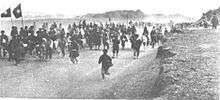
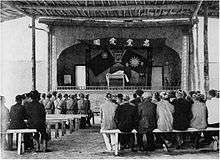
In 1912 the Qing dynasty was replaced by the Republic of China. Yuan Dahua, the last Qing governor of Xinjiang, fled. One of his subordinates Yang Zengxin, acceded to the Republic of China in March of the same year, and maintained control of Xinjiang until his assassination in 1928.
The name "Altishahr and Zungharia",[277] "Altisheher-Junghar",[278] "Altishähär-Junghariyä"[279] was used to refer to the region.
Mongols have at times advocated for the historical Oirat Dzungar Mongol area of Dzungaria in northern Xinjiang, to be annexed to the Mongolian state in the name of Pan-Mongolism.
Legends grew among the remaining Oirats that Amursana had not died after he fled to Russia, but was alive and would return to his people to liberate them from Manchu Qing rule and restore the Oirat nation. Prophecies had been circulating about the return of Amursana and the revival of the Oirats in the Altai region.[280][281] The Oirat Kalmyk Ja Lama claimed to be a grandson of Amursana and then claimed to be a reincarnation of Amursana himself, preaching anti-Manchu propaganda in western Mongolia in the 1890s and calling for the overthrow of the Qing dynasty.[282] Ja Lama was arrested and deported several times. However, he returned to the Oirat Torghuts in Altay (in Dzungaria) in 1910 and in 1912 he helped the Outer Mongolians mount an attack on the last Qing garrison at Kovd, where the Manchu Amban was refusing to leave and fighting the newly declared independent Mongolian state.[283][284][285][286][287][288] The Manchu Qing force was defeated and slaughtered by the Mongols after Khovd fell.[289][290]
Ja Lama told the Oirat remnants in Xinjiang: "I am a mendicant monk from the Russian Tsar's kingdom, but I am born of the great Mongols. My herds are on the Volga river, my water source is the Irtysh. There are many hero warriors with me. I have many riches. Now I have come to meet with you beggars, you remnants of the Oirats, in the time when the war for power begins. Will you support the enemy? My homeland is Altai, Irtysh, Khobuk-sari, Emil, Bortala, Ili, and Alatai. This is the Oirat mother country. By descent, I am the great-grandson of Amursana, the reincarnation of Mahakala, owning the horse Maralbashi. I am he whom they call the hero Dambijantsan. I came to move my pastures back to my own land, to collect my subject households and bondservants, to give favour, and to move freely."[291][292]
Ja Lama built an Oirat fiefdom centered on Kovd,[293] he and fellow Oirats from Altai wanted to emulate the original Oirat empire and build another grand united Oirat nation from the nomads of western China and Mongolia,[294] but was arrested by Russian Cossacks and deported in 1914 on the request of the Monglian government after the local Mongols complained of his excesses, and out of fear that he would create an Oirat separatist state and divide them from the Khalkha Mongols.[295] Ja Lama returned in 1918 to Mongolia and resumed his activities and supported himself by extorting passing caravans,[296][297][298] but was assassinated in 1922 on the orders of the new Communist Mongolian authorities under Damdin Sükhbaatar.[299][300][301]
The part Buryat Momgol Transbaikalian Cossack Ataman Grigory Semyonov declared a "Great Mongol State" in 1918 and had designs to unify the Oirat Mongol lands, portions of Xinjiang, Transbaikal, Inner Mongolia, Outer Mongolia, Tannu Uriankhai, Khovd, Hu-lun-pei-erh and Tibet into one Mongolian state.[302]
The Buryat Mongol Agvan Dorzhiev tried advocating for Oirat Mongol areas like Tarbagatai, Ili, and Altai to get added to the Outer Mongolian state.[303] Out of concern that China would be provoked, this proposed addition of the Oirat Dzungaria to the new Outer Mongolian state was rejected by the Soviets.[304]
Swedish Christian missionary J. E. Lundahl wrote in 1917 that the local Muslim women in Xinjiang married Chinese men because of a lack of Chinese women, the relatives of the woman and other Muslims reviled the women for their marriages.[305]
An anti-Christian mob broke out among the Muslims in Kashgar against the Swedish missionaries in 1923.[306]
In the name of Islam, the Uyghur leader Abdullah Bughra violently physically assaulted the Yarkand-based Swedish missionaries and would have executed them, except they were only banished due to the British Aqsaqal's intercession in their favor.[307]
Different ethnic groups had different attitudes toward prostitution. George W. Hunter (missionary) noted that Turki Muslims (Uyghurs) would prostitute their daughters, while such a thing would never happen among Tungan Muslims (Chinese Muslims), which was why Turki prostitutes were common around the country.[308]
During the Kumul Rebellion in Xinjiang in the 1930s, Buddhist murals were deliberately vandalized by Muslims.[309]
Following insurgencies against Governor Jin Shuren in the early 1930s, a rebellion in Kashgar led to the establishment of the short-lived First East Turkistan Republic (First ETR) in 1933. The ETR claimed authority around the Tarim Basin from Aksu in the north to Khotan in the south, and was suppressed by the armies of the Chinese Muslim warlord Ma Zhongying in 1934.
The Chinese in the Old city of Kashgar had mistresses and wives who were Turkic, on 3 May 1933, these Turkic women and 100 Chinese were murdered by Kirghiz when they pillaged the city in the Battle of Kashgar (1933)[310]
In 1933, Sheng Shicai, a Chinese warlord, seized control of Xinjiang with support from the Soviet Union, which helped him defeat Ma Zhongying. Sheng ruled the region for a decade during which he permitted greater Soviet influence on Xinjiang's ethnic, economic and security policies.
In 1936, after Sheng Shicai expelled 30,000 Kazakhs from Xinjiang to Qinghai, Hui led by General Ma Bufang massacred their fellow Muslim Kazakhs, until there were 135 of them left.[311][312][313]
From Northern Xinjiang over 7,000 Kazakhs fled to the Tibetan-Qinghai plateau region via Gansu and were wreaking massive havoc so Ma Bufang solved the problem by relegating the Kazakhs into designated pastureland in Qinghai, but Hui, Tibetans, and Kazakhs in the region continued to clash against each other.[314]
Tibetans attacked and fought against the Kazakhs as they entered Tibet via Gansu and Qinghai.
In northern Tibet Kazakhs clashed with Tibetan soldiers and then the Kazakhs were sent to Ladakh.[315]
Tibetan troops robbed and killed Kazakhs 400 miles east of Lhasa at Chamdo when the Kazakhs were entering Tibet.[316][317]
In 1934, 1935, 1936-1938 from Qumil Eliqsan led the Kerey Kazakhs to migrate to Gansu and the amount was estimated at 18,000, and they entered Gansu and Qinghai.[318]
Sheng invited a group of Chinese Communists to Xinjiang including Mao Zedong's brother Mao Zemin, but in 1943, fearing a conspiracy against him, Sheng killed all Chinese Communists, including Mao Zemin. In the summer of 1944, during the Ili Rebellion, a Second East Turkistan Republic (Second ETR) was established, this time, with Soviet support, in what is now Ili Kazakh Autonomous Prefecture in northern Xinjiang. The Three Districts Revolution, as it is known in China, threatened the Nationalist provincial government in Ürümqi. Sheng Shicai fell from power and Zhang Zhizhong was sent from Nanjing to negotiate a truce with the Second ETR and the USSR. An uneasy coalition provincial government was formed and brought nominal unity to Xinjiang with separate administrations.
The coalition government came to an end at the conclusion of the Chinese Civil War when the victorious Chinese Communists entered Xinjiang in 1949. The leadership of the Second ETR was persuaded by the Soviet Union to negotiate with the Chinese Communists. Most were killed in an airplane crash en route to a peace conference in Beijing in late August. The remaining leadership under Saifuddin Azizi agreed to join the newly founded People's Republic of China. The Nationalist military commanders in Xinjiang, Tao Zhiyue and provincial governor Burhan Shahidis surrendered to the People's Liberation Army (PLA) in September. Kazak militias under Osman Batur resisted the PLA into the early 1950s. The Xinjiang Uyghur Autonomous Region of the PRC was established on 1 October 1955, replacing Xinjiang Province.
In Urumqi (Uyghur) Muslim women who married Han Chinese men were assaulted by hordes of (Uyghur) Muslims on 11 July 1947, and the women were seized and kidnapped by the hordes. Old (Uyghur) Muslim men forcibly married the women. In response to the chaos a curfew was placed at 11 p.m.[319]
The marriages between Muslim (Uyghur) women and Han Chinese men infuriated the Uyghur leader Isa Yusuf Alptekin.[320]
Mixed Han-Uyghur partners are pressured to leave their parents and sometimes leave Xinjiang entirely, from 1911-1949 when the Guomindang ruled China, Han Chinese Generals in the military were sought after and wooed by Uyghur women due to their poverty, but in 1949 when the Communists took over, the Uyghur population branded them as milliy munapiq (ethnic scum) and threatened and coerced them into accompanying their Han partners in moving to Taiwan, Uyghur parents warn not to return to Xinjiang their female and male children if they married Han after moving to "China proper" for attending educational institutions, so they can avoid ostracism and condemnation from their fellow Uyghurs, a case where a Han male dating Uyghur woman told Dr. Smith Finley about a relationship between a Han man and her elder sister resulted in the Uyghur community condemning and pressuring her mother.[321]
PRC rule
During the Ili Rebellion the Soviet Union backed Uyghur separatists to form the Second East Turkistan Republic (2nd ETR) from 1944 to 1949 in what is now Ili Kazakh Autonomous Prefecture (Ili, Tarbagatay and Altay Districts) in northern Xinjiang while the majority of Xinjiang was under Republic of China Kuomintang control.[322] The People's Liberation Army entered Xinjiang in 1949 and the Kuomintang commander Tao Zhiyue surrendered the province to them.[323] Five ETR leaders who were to negotiate with the Chinese over the ETR's sovereignty died in an air crash in 1949 in Soviet airspace over the Kazakh Soviet Socialist Republic.[324]
According to the PRC, the 2nd ETR was Xinjiang's revolution, a positive part of the communist revolution in China; the 2nd ETR acceded to and 'welcomed' the PLA when it entered Xinjiang, a process known as the Incorporation of Xinjiang into the People's Republic of China.
Uyghur nationalists often incorrectly claim that 5% of Xinjiang's population in 1949 was Han, and that the other 95% was Uyghur, erasing the presence of Kazakhs, Xibes, and others, and ignoring the fact that Hans were around one third of Xinjiang's population at 1800, during the time of the Qing Dynasty.[325]
The autonomous region of the PRC was established on 1 October 1955, replacing the province.[323] In 1955 (the first modern census in China was taken in 1953), Uyghurs were counted as 73% of Xinjiang's total population of 5.11 million.[326] Although Xinjiang as a whole is designated as a "Uyghur Autonomous Region", since 1954 more than 50% of Xinjiang's land area are designated autonomous areas for 13 native non-Uyghur groups.[327] The modern Uyghur people experienced ethnogenesis especially from 1955, when the PRC officially recognized that ethnic category - in opposition to the Han - of formerly separately self-identified oasis peoples.[328]
The PRC's first nuclear test was carried out at Lop Nur, Xinjiang, on 16 October 1964. A Japanese researcher known for prominently opposing the tests as "the Devil's conduct" speculated that between 100,000 and 200,000 people may have been killed due to the consequential radiation,[329] although the Lop Nur area has not been permanently inhabited since the 1920s,[330] being located between the Taklamakan and Kumtag deserts in Ruoqiang County, which has an area of almost 200,000 km2 (77,000 sq mi) with a population density of only 0.16/km2. Chinese media challenged this conclusion without providing an alternate number.[331]
The People's Republic of China has directed the majority of Han migrants towards the sparsely populated Dzungaria (Dzungar Basin), before 1953 most of Xinjiang's population (75%) lived in the Tarim Basin, so the new Han migrants resulted in the distribution of population between Dzungaria and the Tarim being changed.[332][333][334] Most new Chinese migrants ended up in the northern region, in Dzungaria.[335] Han and Hui made up the majority of the population in Dzungaria's cities while Uighurs made up most of the population in Kashgaria's cities.[336] Eastern and Central Dzungaria are the specific areas where these Han and Hui are concentrated.[337] China made sure that new Han migrants were settled in entirely new areas uninhabited by Uyghurs so as to not disturb the already existing Uyghur communities.[338] Lars-Erik Nyman noted that Kashgaria was the native land of the Uighurs, "but a migration has been in progress to Dzungaria since the 18th century".[339]
Both Han economic migrants from other parts of China and Uyghur economic migrants from southern Xinjiang have been flooding into northern Xinjiang since the 1980s.[340]
Southern Xinjiang is where the majority of the Uyghur population resides, while it is in Northern Xinjiang cities where the majority of the Han (90%) population of Xinjiang reside.[341] Southern Xinjiang is dominated by its nine million Uighur majority population, while northern Xinjiang is where the mostly urban Han population holds sway.[342] This situation has been followed by an imbalance in the economic situation between the two ethnic groups, since the Northern Junghar Basin (Dzungaria) has been more developed than the Uighur south.[343]
From the 1950s to 1970s, 92% of migrants to Xinjiang were Han and 8% were Hui. Most of these migrants were unorganized settlers - "as [they are still] now", coming from neighboring Gansu province to seek trading opportunities.[344]
The Soviet Union incited separatist activities in Xinjiang through propaganda, encouraging Kazakhs to flee to the Soviet Union and attacking China. China responded by reinforcing the Xinjiang-Soviet border area specifically with Han Bingtuan militia and farmers.[345] The Soviets massively intensified their broadcasts inciting Uyghurs to revolt against the Chinese via Radio Tashkent since 1967 and directly harbored and supported separatist guerilla fighters to attack the Chinese border, in 1966 the amount of Soviet sponsored separatist attacks on China numbered 5,000.[346] The Soviets transmitted a radio broadcast from Radio Tashkent into Xinjiang on 14 May 1967, boasting of the fact that the Soviets had supported the Second East Turkestan Republic against China.[347] In addition to Radio Tashkent, other Soviet media outlets aimed at disseminating propaganda towards Uyghurs urging that they proclaim independence and revolt against China included Radio Alma-Ata and the Alma-Ata published Sherki Türkistan Evazi ("The Voice of Eastern Turkestan") newspaper.[348] After the Sino-Soviet split in 1962, over 60,000 Uyghurs and Kazakhs defected from Xinjiang to the Kazakh Soviet Socialist Republic, in response to Soviet propaganda which promised Xinjiang independence. Uyghur exiles later threatened China with rumors of a Uyghur "liberation army" in the thousands that were supposedly recruited from Sovietized emigres.[349]
The Soviet Union was involved in funding and support to the East Turkestan People's Revolutionary Party (ETPRP), the largest militant Uyghur separatist organization in its time, to start a violent uprising against China in 1968.[350][351][352][353][354] In the 1970s, the Soviets also supported the United Revolutionary Front of East Turkestan (URFET) to fight against the Chinese.[355]
"Bloody incidents" in 1966-67 flared up as Chinese and Soviet forces clashed along the border as the Soviets trained anti-Chinese guerillas and urged Uyghurs to revolt against China, hailing their "national liberation struggle".[356] In 1969, Chinese and Soviet forces directly fought each other along the Xinjiang-Soviet border.[357][358][359][360]
The Soviet Union supported Uyghur nationalist propaganda and Uyghur separatist movements against China. The Soviet historians claimed that the Uyghur native land was Xinjiang and Uyghur nationalism was promoted by Soviet versions of history on turcology.[361] Soviet turcologists like D.I. Tikhonov wrote pro-independence works on Uyghur history and the Soviet supported Uyghur historian Tursun Rakhimov wrote more historical works supporting Uyghur independence and attacking the Chinese government, claiming that Xinjiang was an entity created by China made out of the different parts of East Turkestan and Dzungaria.[362] These Soviet Uyghur historians were waging an "ideological war" against China, emphasizing the "national liberation movement" of Uyghurs throughout history.[363] The Soviet Communist Party supported the publication of works which glorified the Second East Turkestan Republic and the Ili Rebellion against China in its anti-China propaganda war.[364] Soviet propaganda writers wrote works claiming that Uyghurs lived better lives and were able to practice their culture only in Soviet Central Asia and not in Xinjiang.[365] In 1979 Soviet KGB agent Victor Louis wrote a thesis claiming that the Soviets should support a "war of liberation" against the "imperial" China to support Uighur, Tibetan, Mongol, and Manchu independence.[366][367] The Soviet KGB itself supported Uyghur separatists against China.[368]
Uyghur nationalist historian Turghun Almas and his book Uyghurlar (The Uyghurs) and Uyghur nationalist accounts of history were galvanized by Soviet stances on history, "firmly grounded" in Soviet Turcological works, and both heavily influenced and partially created by Soviet historians and Soviet works on Turkic peoples.[369] Soviet historiography spawned the rendering of Uyghur history found in Uyghurlar.[370] Almas claimed that Central Asia was "the motherland of the Uyghurs" and also the "ancient golden cradle of world culture".[371]
Xinjiang's importance to China increased after the Soviet invasion of Afghanistan in 1979, leading to China's perception of being encircled by the Soviets.[372] The China supported the Afghan mujahideen during the Soviet invasion, and broadcast reports of Soviet atrocities on Afghan Muslims to Uyghurs in order to counter Soviet propaganda broadcasts into Xinjiang, which boasted that Soviet minorities lived better and incited Muslims to revolt.[373] Chinese radio beamed anti-Soviet broadcasts to Central Asian ethnic minorities like the Kazakhs.[357] The Soviets feared disloyalty among the non-Russian Kazakh, Uzbek, and Kyrgyz in the event of Chinese troops attacking the Soviet Union and entering Central Asia. Russians were goaded with the taunt "Just wait till the Chinese get here, they'll show you what's what!" by Central Asians when they had altercations.[374] The Chinese authorities viewed the Han migrants in Xinjiang as vital to defending the area against the Soviet Union.[375] China opened up camps to train the Afghan Mujahideen near Kashgar and Khotan and supplied them with hundreds of millions of dollars worth of small arms, rockets, mines, and anti-tank weapons.[376][377]
Since the Chinese economic reform from the late 1970s has exacerbated uneven regional development, more Uyghurs have migrated to Xinjiang cities and some Hans have also migrated to Xinjiang for independent economic advancement. Increased ethnic contact and labor competition coincided with Uyghur separatist terrorism from the 1990s, such as the 1997 Ürümqi bus bombings.[378]
In the 1980s, 90% of Xinjiang Han lived in north Xinjiang (Jiangbei, historical Dzungaria). In the mid-1990s, Uyghurs consisted of 90% of south Xinjiang (Nanjiang, historical Tarim)'s population.[344] In 1980, the liberal reformist Hu Yaobang announced the expulsion of ethnic Han cadres in Xinjiang to eastern China. Hu was purged in 1987 for a series of demonstrations that he is said to have provoked in other areas of China. The prominent Xinjiang and national official Wang Zhen criticized Hu for destroying Xinjiang Han cadres' "sense of security", and for exacerbating ethnic tensions.[379]
In the 1990s, there was a net inflow of Han people to Xinjiang, many of whom were previously prevented from moving because of the declining number of social services tied to hukou (residency permits).[380] As of 1996, 13.6% of Xinjiang's population was employed by the publicly traded Xinjiang Production and Construction Corps (Bingtuan) corporation. 90% of the Bingtuan's activities relate to agriculture, and 88% of Bingtuan employees are Han, although the percentage of Hans with ties to the Bingtuan has decreased.[381] Han emigration from Xinjiang has also resulted in an increase of minority-identified agricultural workers as a total percentage of Xinjiang's farmers, from 69.4% in 1982 to 76.7% in 1990.[382] During the 1990s, about 1.2 million temporary migrants entered Xinjiang every year to stay for the cotton picking season.[383] Many Uyghur trading communities exist outside of Xinjiang; the largest in Beijing is one village of a few thousand.[383]
A chain of aggressive and belligerent press releases in the 1990s making false claims about violent insurrections in Xinjiang, and exaggerating both the number of Chinese migrants and the total number of Uyghurs in Xinjiang were made by the former Soviet supported URFET leader Yusupbek Mukhlisi.[384][385]
In 2000, Uyghurs "comprised 45 per cent of Xinjiang's population, but only 12.8 per cent of Urumqi's population." Despite having 9% of Xinjiang's population, Urumqi accounts for 25% of the region's GDP, and many rural Uyghurs have been migrating to that city to seek work in the dominant light, heavy, and petrochemical industries.[386] Hans in Xinjiang are demographically older, better-educated, and work in higher-paying professions than their Uyghur cohabitants. Hans are more likely to cite business reasons for moving to Urumqi, while some Uyghurs also cite trouble with the law back home and family reasons for their moving to Urumqi.[387] Hans and Uyghurs are equally represented in Urumqi's floating population that works mostly in commerce. Self-segregation within the city is widespread, in terms of residential concentration, employment relationships, and a social norm of endogamy.[388] As of 2010, Uyghurs constitute a majority in the Tarim Basin, and a mere plurality in Xinjiang as a whole.[389] Han and Hui mostly live in northern Xinjiang (Dzungaria), and are separated from areas of historical Uyghur dominance south of the Tian Shan mountains (southwestern Xinjiang), where Uyghurs account for about 90% of the population.[390]
Uyghur is the dominant language in southern Xinjiang while Mandarin is the dominant language in northern Xinjiang.[391]
During the Great Chinese Famine (1958–1961), Xinjiang experienced a great emigration of residents both to the Soviet Union and to East China. After a number of student demonstrations in the 1980s, the Baren Township riot of April 1990 led to more than 20 deaths.[392] 1997 saw the Ghulja Incident and Urumqi bus bombs,[393] while police continue to battle with religious separatists from the East Turkestan Islamic Movement.
Han Youwen, a Salar general, once served as vice chairman of Xinjiang.
Manchu, Daur, Tartar, Tajik, Xibo, Uzbeks, Russians, Kirgiz, Hui, Mongols, Kazakhs, Han, and Uyghur make up the ethniciites in Xinjiang, the Uyghur population has grown along with the Kazakh, there were 1.3 million Kazakhs and 8.4 million Uyghurs in 2001, an increase from 900,000 Kazakhs and 6 million Uyghurs in 1982, which was an increase from 500,000 Kazakhs and 4 million Uyghurs in the 1960s, there had been a declining death rate for child birth and diseases have been checked by advanced medical care, helping Xinjiang's population growth, and China does not strictly apply birth control to the area.[394]
There was a 1.7 growth in the Uyghur population in Xinjiang while there was a 4.4% growth from 1940-1982 in the Hui population in Xinjiang. Uyghur Muslims and Hui Muslims have experienced a growth in major tensions against each other due to the Hui population surging in its growth. Some old Uyghurs in Kashgar remember that the Hui army at the Battle of Kashgar (1934) massacred 2,000 to 8,000 Uyghurs, which caused tension as more Hui moved into Kashgar from other parts of China.[395] Some Hui criticize Uyghur separatism, Dru C. Gladney said the Hui "don't tend to get too involved in international Islamic conflict, They don't want to be branded as radical Muslims."[396][397] Hui and Uyghur live separately, attending different mosques.[398]
In recent years, Xinjiang has been a focal point of ethnic and other tensions.[399][400]
After girls below the marriage age were illegally wedded to Uyghur men, prison sentences were handed out to them.[401]
The "Doğu Türkistan Bülteni Haber Ajansı" which supports the Turkistan Islamic Party, claimed that the AIDS virus was being used against Uyghurs.[402][403][404][405]
Fundamentalist Islamists prevent Uyghur women who are infected with HIV from getting drugs for their condition.[406]
Hui Muslim drug dealers are accused by Uyghurs of pushing heroin on Uyghurs.[407] Heroin has been vended by Hui dealers.[408] There is a typecast image in the public eye of heroin being the province of Hui dealers.[409] Hui have been involved in the Golden Triangle drug area.[410]
Recent incidents include the 2007 Xinjiang raid,[411] a thwarted 2008 suicide bombing attempt on a China Southern Airlines flight,[412] and the 2008 Xinjiang attack which resulted in the deaths of sixteen police officers four days before the Beijing Olympics.[413][414] Further incidents include the July 2009 Ürümqi riots, the September 2009 Xinjiang unrest, and the 2010 Aksu bombing that led to the trials of 376 people.[415] In 2013 and 2014 a series of attacks on railway stations and a market, which claimed the lives of 70 people, and wounded hundreds more, resulted in a 12-month government clampdown. Two mass sentencing trials involving 94 people convicted of terrorism charges, resulted in three receiving death sentences, and the others lengthy jail terms.[416]
From 1949 to 2001, education has expanded greatly in the region, with 6,221 primary schools up from 1,335; 1,929 middle schools up from 9, and institutions of higher learning at 21, up from 1. The illiteracy rate for young and middle-age people has decreased to less than 2%. Agricultural science has made inroads into the region, as well as innovative methods of road construction in the desert.
Culturally, Xinjiang maintains 81 public libraries and 23 museums, compared to none of each in 1949, and Xinjiang has 98 newspapers in 44 languages, up from 4 newspapers in 1952. According to official statistics, the ratios of doctors, medical workers, medical clinics, and hospital beds to people surpass the national average, and immunization rates have reached 85%.[417]
A 28 year old mixed race woman named Amy whose father was Han and whose mother was Uyghur was interviewed by The Atlantic and she spoke of being estranged from Uyghurs and viewed Uyghur men's appearances negatively.[418] After a Han Chinese man named Xiaohe and a Uyghur woman named Aygul married, the Uyghur women was physically assaulted by her father. A Uyghur family cut off their daughter, a Uyghur woman Ahman who had a Han Chinese husband named Ming. When she had a Han Chinese boyfriend in school her fellow Uyghurs violently assaulted her. Uyghurs are often angered and shun inter-ethnic families with Han men and Uyghur women. These interethnic pairs fled Xinjiang to Beijing.[419]
Exceptions through general opposition to intermarriage could take place in event of the Han converting to Islam or the Uyghur and Han partners moving away to another location.[420]
Although currently Uyghurs have an extremely low intermarriage overall, Dr. Joanne Smith Finley wrote that there is tiny rise in marriages between Han men and Uyghur women and out of all ethnic groups, ahead of Hui and Kazakhs, Han are the ethnic group with whom Uyghurs marry with the most within their total small rate of intermarriage, and Uyghur females married out more than Uyghur males at 0.46 to 0.2%, with Uyghur males being the least likely people to intermarry in Xinjiang.[421] Multiple studies and interviews found that the current prevalent form of intermarriage between Han and Uyghur is Han men being taken as husbands by Uyghur women.[422]
Family relatives who object to interracial marriages of their relatives often lead to lasting difficulties, with relatives pressuing the marriage not to take place or forcing the couple to be estranged from the family.[423]
Many interracial couples face the prospect of being disowned by their parents and cut off if they intermarried, while some couples, in the face of opposition, chose to run off with their partners.[424]
Uyghur parents have cut off or told to stay away from Xinjiang, their children who married Han after going to "China proper" to pursue their education, some interracial couples had secret marriages to hide from their relatives and parents in Ghulja.[425]
Dr. Joanne Smith Finley interviewed Uyghur youth and found that Uyghur parents often pressure their children, daughters and sons, not to intermarry, the reactions from their children are mixed, with some Uyghurs like Mälikä and Aygül saying they would have to obey their parents and split up from their Han partner, while other Uyghurs said they would abscond and run away with their Han partner like a 20 year old Uyghur woman named Gülshäm who said she would run off with a Han if the relationship was not allowed by her father.[426]
Communities in which there has been racial conflict may put negative pressure on interracial couples and act as an impediment to them.[427] Conflict and war between different races leads to community prejudice against couples consisting of the two different races.[428]
A 15 year old Uyghur boy naked Burkhan rejected the idea of marrying a Han female and told Dr. Smith Finley that he would be totally shunned by his fellow Uyghurs if he did it, while a 20 year old Uyghur woman named Gülshäm said that she was open to marriage with Han, she cheered on mixed couples as courageous, condemning her fellow Uyghurs for their harsh opposition to intermarriage, after Gülshäm brought up the subject of dating a Han boyfriend with a female friend, her friend then threatened violence against her if she ever dated a Han.[429]
When intermarriage takes place with a reviled ethnicity, families may disown their children for doing it.[430]
War and conflict between different peoples can hinder intermarriage between them.[431]
Marriage with Hui is detested by many Uyghurs even though they are both Muslims, religion plays a role at restricting marriages between non-Muslims and Muslims.[432]
Muslims pressure men who marry into their community to convert to Islam.[433]
A number of Uyghur parents demand Han males and females who want to marry their daughters or sons convert to Islam, it was reported that there were many conversions to Islam by Han males who married Uyghur women by a Uyghur man, Nurmämät who was interviewed by Dr. Smith Finley.[434]
Becoming a Muslim results in more acceptance among Uyghurs of Han spouses, a case in Urumqi of a Han male who converted to Islam and married a Uyghur woman, was reported by an 18 year old Uyghur male, Ömär, who lived in the same area as the man and voiced the approval of the Uyghur community, the man adopted doppa hat, went to the mosque to pray and changed his name to Jümäkhun and was accepted as a real Muslim, while another case of a Han woman converting to Islam to marry a Uyghur was viewed with suspicion since the Uyghurs suspected her of faking the conversion and she would not integrate with the Uyghur community at all.[435]
Han and Hui intermarry with each other much more than Hui do with Uyghurs, despite Hui and Uyghur both being Muslim, and according to Uyghurs, Hui marriages with Uyghur frequently break apart and end in divorce.[436]
Children who are of mixed Han and Uyghur ethnicities are known as erzhuanzi (二转子) and Uyghurs call them piryotki.[437] They are shunned by Uyghurs at social gatherings and events.[438]
Many Uyghurs oppose mixed race marriages and the majority of Uyghur men interviewed by Professor Blaine Kaltman viewed Han Chinese women as physically unattractive and none of them were dating Han women and had no desire to, vieweing them as alien and "too skinny" while they said they were attracted to Turkish and Russian actresses, Han parents in turn were negative towards Uyghur men and believed that women would suffer abuse at the hands of a Uyghur spouse.[439] Han youth were more open to interracial dating and Han parents, both mothers and fathers were more willing to let their sons date Uyghur girls while they object to their daughters dating Uyghur boys since they believe their girls would be in danger.[440]
Most Uyghurs in both Xinjiang and in Han cities Shenzhen, Shanghai, and Beijing, desire that their son marry with fellow Uyghurs to preserve their culture, a Uyghur man interviewed by Professor Kaltman in Urumqi expressed his willingness to let a Han man marry his daughter, but wanted his son to marry another Uyghur [441]
Interracial dating is prevalent among Han people and "Chinese Uighur" (assimilated Uyghurs who speak Mandarin), one government employee Uyghur man interviewed by Professor Kaltman said he does not anticipate a Han marrying his daughter but he would not object to it if she wanted to, Professor Kaltman interviewed an additional Uyghur man who said he would not allow a Han woman to date his son because his descendants would not be raised as Uyghur,[442] but he would approve of his son marrying Kazakh or Russian girls.[443]
A psychotherapist treated a Han Chinese named Wang Minxing who was married to a taller Uyghur woman named Ayi Guli, she became a partner in his furniture manufacturing company and aborted two children they had together before they married, after they married she did not abort when she became pregnant a third time after their marriage.[444] Wang wanted a son and Ayi was exempt from the policy on was allowed to give birth to another child but Ayi felt that she became a businesswoman to escape this patriarchal child bearing role.[445]
Continued tensions
"If you do not wage jihad, you will never be able to get rid of the oppression of the infidels which makes you abandon the religion and which makes slaves of you. Thus, you will not be able to be rescued from the oppression of this world and the torments of the hereafter, or find eternal happiness until you return to the religion of Allah. . ." - Abdul Haq (Memetiming Memeti), a commander in the Uyghur separatist movement Turkistan Islamic Party (East Turkestan Islamic Movement), from a video released by TIP, February 9. 2009.[446]
"We have to conquer our own country and purify it of all infidels. Then, we should conquer the infidels' countries and spread Islam. The infidels who are usurping our countries have announced war against Islam and Muslims, forcing Muslims to abandon Islam and change their beliefs." - Abdullah Mansour, leader of the Uyghur separatist movement Turkistan Islamic Party (East Turkestan Islamic Movement), from "The Duty of Faith and Support," Voice of Islam/al-Fajr Media Center, August 26, 2009.[447]
Amnesty International and Human Rights Watch speculate that Uyghur resentment towards alleged repression of Uyghur culture may explain some of the ethnic riots that have occurred in Xinjiang during the PRC period.
Conversely, Han Chinese are treated as second class citizens by PRC policies, in which many of the ethnic autonomy policies are discriminatory against them[448] (see Affirmative action in China and autonomous entities of China) and previous Chinese dynasties owned Xinjiang before the Uyghur Empire. Independence advocates view Chinese rule in Xinjiang, and policies like the Xinjiang Production and Construction Corps as Chinese imperialism.
In the 1980s there was a scattering of student demonstrations and riots against police action that took on an ethnic aspect; and the Baren Township riot in April, 1990, an abortive uprising, resulted in more than 50 deaths.
A police round-up and execution of 30 suspected separatists[449] during Ramadan resulted in large demonstrations in February 1997 which were characterised as riots in the Chinese state media,[450] which western have described as peaceful.[451] These demonstrations culminated in the Gulja Incident on 5 February, where a PLA crackdown on the demonstrations led to at least 9 deaths and perhaps more than 100.[449] The Ürümqi bus bombs of 25 February 1997, killed 9 and injured 68. The situation in Xinjiang was relatively quiet from the late nineties through mid-2006, though inter-ethnic tensions no doubt remained.[452]
Recent incidents include the 2007 Xinjiang raid,[453] a thwarted 2008 suicide bombing attempt on a China Southern Airlines flight,[454] and the 2008 Xinjiang attack which resulted in the deaths of sixteen police officers four days before the Beijing Olympics.[455][456] Further incidents include the July 2009 Ürümqi riots, the September 2009 Xinjiang unrest, and the 2010 Aksu bombing that led to the trials of 376 people.[457] The 2011 Hotan attack in July led to the deaths of 18 civilians. Although all of the attackers were Uyghur,[458] both Han and Uyghur people were victims.[459]
Uyghur Muslim opposition to a Buddhist Aspara statue in Ürümqi in Xinjiang was cited as a possible reason for its destruction in 2012.[460][461] A Muslim Kazakh viewed a giant Buddha statue near Ürümqi as "alien cultural symbols".[462]
The East Turkestan Islamic Movement (Turkistan Islamic Party) is allied with the Islamic Movement of Uzbekistan[463] along with the Pakistani Taliban (Tehreek i Taliban Pakistan)[464] and Al-Qaeda.[465][466]
Al Qaeda appointed TIP (ETIM) member Abdul Haq al Turkistani to their Shura Majlis.[467] Al Qaeda also appointed TIP (ETIM) member Abdul Shakoor Turkistani as military commander of their forces in the FATA region of Pakistan.[468]
TIP (ETIM) issued a eulogy for Doku Umarov of the Caucasian Emirate upon his death.[469][470][471]
Al-Qaeda leader Ayman al-Zawahiri released a statement supporting Jihad in Xinjiang against Chinese, in the Caucasus against the Russians and naming Somalia, Yemen, Syria, Iraq, and Afghanistan as places of warfare.[472] Zawahiri endorsed "jihad to liberate every span of land of the Muslims that has been usurped and violated, from Kashgar to Andalusia, and from the Caucasus to Somalia and Central Africa".[473] Uyghurs inhabit Kashgar, the city which was mentioned by Zawahiri.[474]
TIP (ETIM) sent the "Turkistan Brigade" (Katibat Turkistani) to take part in the Syrian Civil War,[475] most noticeably in the 2015 Jisr al-Shughur offensive.[476][477][478][479] TIP (ETIM) members in Syria fight alongside the Al-Qaeda branch Al Nusrah Front since TIP is allied to Al-Qaeda in Pakistan and Afghanistan and conducted suicide bombings for Nusrah Front.[480] Members of TIP have been killed in battle in Syria.[481] TIP (ETIM) eulogized and applauded members of its organization who participated in suicide bombings and members who were killed in action in Jisr al Shughur.[482] Members of the group helped other Jihadists enforce religious law in Idlib such as wrecking alcohol in stores and this was noted that with "support of Allah and by the strike of the fist of the Mujahideen from the Al Nusrah Front, Ahrar al Sham and Turkistan," that they undertook these actions by a Syrian Jihadist in Jaysh al Fateh.[483] A Jabhat Al Nusra Jihadist called Abu Mohamed Al-Ansari interviewed by VICE News after the Idlib offensive said that "The battle was good, praise be to God. The brothers from all the groups started working together and coordinating. Each faction is responsible for a side. The majority were immigrant brothers from Turkestan. They are the ones who attacked the important points."[484] The spokesman of Jabhat Al-Nusra Abu Maria al-Qahtani claimed that Muslims were "oppressed" in "Turkestan" and that Nusra needs to "defend" them.[485][486] TIP (ETIM) joined in on the Jihadist offensive in the Al-Ghab plain along with Al-Qaeda affiliated Jund al Aqsa against the Syrian army, referring to the Syrian army by the disparaging name "Nusayri".[487][488][489] In Idlib four villages were seized by the Turkistan Islamic Party around August 2015.[490] and the TIP said they "met with the brothers in Jund al Aqsa".[491] The Turkistan Islamic Party and Jabhat Al-Nusra launched a joint operation which overran the Syrian military's Abu Dhuhur airbase.[492][493][494] The Turkistan Islamic Party released photos of their Uyghur fighters at Abu Dhuhur.[495][496][497][498][499] At Abu Dhuhur, Sheikh Muhaysini (an Al-Qaeda linked Saudi cleric) took pictures with Turkistan Islamic Party which was released by Islam Awazi.[500] Syrian regime military prisoners from Abu Dhuhur were exhibited in photos released by the Turkistan Islamic Party.[501] A video released by Turkistan Islamic Party featured Junud al-Sham deputy leader Abu Bakr al Shishani.[502] The Turkistan Islamic Party's Islam Awazi released photos of its fighters in Syria.[503]
A mass execution of 56 captured Syrian soldiers was carried out by the Turkestan Islamic Party along with Jabhat al-Nusra at Abu al-Duhur.[504][505][506][507][508][509][510][511]
One of Sayfullakh Shishani's fighters in Jabhat al-Nusra claimed that a united faction called al-Muhajireen was formed out of the unification of the Uyghur Turkistan, Uzbek Abu Salyaha and Al-Bukhari, Ahlu Sunnah wal-Jama'a, and Jaish al-Muhajireen wal Ansar.[512]
Katiba Turkistan joined with Ahrar al-Sham, Jabhat al-Nusra, and Junud al-Sham against the Syrian army in the battle for Jisr al-Shughur.[513]
Syrian Churches have been demolished by Turkistan Islamic Party Uyghur fighters, who exalted in the acts of destruction, and in Homs and Idlib battlefields the Turkistan Islamic Party cooperated with Uzbek brigades and Jabhat al-Nusra, Jabhat al-Nusra and IS (ISIL) compete with each other to recruit Uyghur fighters.[514]
Turkish connections were used by Uyghur fighters to go into Syria and the humanitarian Uyghur Eastern Turkistan Education and Solidarity Association (ETESA) which is located in Turkey sent Uyghurs into Syria, endorsed the killing of the pro-China Imam Juma Tayir, applauded attacks in China, and posted on its website content from the TIP.[515]
Al-Qaeda included an article in its magazine "Resurgence" promoting East Turkestan Independence titled "Did You Know? 10 Facts About East Turkistan", the article was ridden with errors and false claims such as claiming Quranic education was banned, and included other claims such as "East Turkistan has never been a part of China" and it was "independent of China for more than 1,800 years", "In 1949, 93 percent of the population of East Turkistan was Uyghur (Turk Muslims) while 7 percent was Chinese", and that "After the Communist takeover in 1949, more than 4.5 million Turkish Muslims were killed by the Communist government", with Al-Qaeda calling for the "occupied Muslim land" "East Turkistan" to be "recovered [into] the shade of the Islamic Caliphate".[516]
As part of an effort to reach out to foreign Muslims, on the Ink of Swords (Medad al-Sayouf) Network, an Arabic language magazine titled "Islamic Turkistan" (Turkistan al-Islamia) was issued by ETIM in January 2009 and it described ETIM as "a group of workers for Islam and the mujahideen in the Cause of Allah in order to liberate Turkistan", and said that the aim of ETIM was to "establish an Islamic Caliphate in the light of the Book and the Sunnah", "in the Cause of Allah, promotion of virtue, prevention of vice, and the call to Allah.", to create an Islamic State by means of jihad.[517]
Fellow Al-Qaeda aligned Islamist organizations with the aim of a worldwide Islamic Caliphate cooperate with TIP (ETIM) whose own goal is an Islamic State, with TIP fighting against the militaries of Syria and Pakistan in addition to China and being assisted by Central Asian, Gulf, European, and North American based outfits and the TIP leader Abdullah Mansour used the words "mujahideen" and "jihadi operation" in a Uighur language video produced by TIP's Islam Awazi (ئىسلام ئاۋازى) Media Center when TIP took responsibility for the 29 October 2013 Tianmen Square terrorist attack.[518]
Islam Awazi released a video called "We Are Coming O Buddhists" (نحن قادمون أيّها البوذيون) of a TIP affiliated Uyghur cleric named Sheikh Abu Dhar 'Azzam who also called for the killing of Buddhists in addition to Chinese, saying in Arabic that "Killing you... Slaughtering you... And cutting off your heads is all good", "Kill you, spill your blood, cut off your head is a good thing", the unedited message said "We are Muslims, and you are our enemies oh Buddhists and Chinese: You will not see us and killing you, and spilling your blood, and cutting your heads of: all of it is good, insha Allah" ( نحن مسلمون، ولو كنتم أعداءنا أيُّها البوذيون والصينيون: لن تروا منا إلا خيرًا، وقتلكم وإسالة دمائكم، وقطع رؤوسكم: كله خير إن شاء الله.ـ) on 24 February 2014, he also said "we are a nation that loves death while you are a nation that loves wine and women, and we are coming insha Allah, we want to kill Buddhists to the east of this land and to the west of it". ( إننا قوم نحب الموت كما تحبون الخمر والنساء، وإننا قادمون إن شاء الله، نحن نريد أن نقتل البوذيين في شرق الأرض وغربها.ـ), he also said "those Chinese Buddhists, their small eyes, flat noses. Judgment day will not come, until we attacked them. Judgment day will not come, until we slaughter them. Judgment day will not come, until our war with them and attacking them." ( وأوصيكم بأن هؤلاء الصينيين البوذيين صغار الأعين فطس الأنوف: لا تقوم الساعة حتى نقاتلهم، لا تقوم الساعة حتى نذبحهم، لا تقوم الساعة حتى نتلاحم معهم، ونقاتل ضدهم.ـ)[519][520]
The Hadith collection Sahih al-Bukhari records a Sahih Hadith by Muhammad on the Turks- Narrated Abu Huraira: Allah's Messenger (ﷺ) said, "The Hour will not be established until you fight with the Turks; people with small eyes, red faces, and flat noses. Their faces will look like shields coated with leather. The Hour will not be established till you fight with people whose shoes are made of hair." (حَدَّثَنَا سَعِيدُ بْنُ مُحَمَّدٍ، حَدَّثَنَا يَعْقُوبُ، حَدَّثَنَا أَبِي، عَنْ صَالِحٍ، عَنِ الأَعْرَجِ، قَالَ قَالَ أَبُو هُرَيْرَةَ ـ رضى الله عنه ـ قَالَ رَسُولُ اللَّهِ صلى الله عليه وسلم " لاَ تَقُومُ السَّاعَةُ حَتَّى تُقَاتِلُوا التُّرْكَ صِغَارَ الأَعْيُنِ، حُمْرَ الْوُجُوهِ، ذُلْفَ الأُنُوفِ، كَأَنَّ وُجُوهَهُمُ الْمَجَانُّ الْمُطَرَّقَةُ، وَلاَ تَقُومُ السَّاعَةُ حَتَّى تُقَاتِلُوا قَوْمًا نِعَالُهُمُ الشَّعَرُ ".)[521] Another Sahih al-Bukhari Hadith says Narrated Abu Huraira: The Prophet (ﷺ) said, "The Hour will not be established till you fight a nation wearing hairy shoes, and till you fight the Turks, who will have small eyes, red faces and flat noses; and their faces will be like flat shields. And you will find that the best people are those who hate responsibility of ruling most of all till they are chosen to be the rulers. And the people are of different natures: The best in the pre-Islamic period are the best in Islam. A time will come when any of you will love to see me rather than to have his family and property doubled."(حَدَّثَنَا أَبُو الْيَمَانِ، أَخْبَرَنَا شُعَيْبٌ، حَدَّثَنَا أَبُو الزِّنَادِ، عَنِ الأَعْرَجِ، عَنْ أَبِي هُرَيْرَةَ ـ رضى الله عنه ـ عَنِ النَّبِيِّ صلى الله عليه وسلم قَالَ " لاَ تَقُومُ السَّاعَةُ حَتَّى تُقَاتِلُوا قَوْمًا نِعَالُهُمُ الشَّعَرُ، وَحَتَّى تُقَاتِلُوا التُّرْكَ، صِغَارَ الأَعْيُنِ، حُمْرَ الْوُجُوهِ، ذُلْفَ الأُنُوفِ كَأَنَّ وُجُوهَهُمُ الْمَجَانُّ الْمُطْرَقَةُ ". ""وَتَجِدُونَ مِنْ خَيْرِ النَّاسِ أَشَدَّهُمْ كَرَاهِيَةً لِهَذَا الأَمْرِ، حَتَّى يَقَعَ فِيهِ، وَالنَّاسُ مَعَادِنُ، خِيَارُهُمْ فِي الْجَاهِلِيَّةِ خِيَارُهُمْ فِي الإِسْلاَمِ." "وَلَيَأْتِيَنَّ عَلَى أَحَدِكُمْ زَمَانٌ لأَنْ يَرَانِي أَحَبُّ إِلَيْهِ مِنْ أَنْ يَكُونَ لَهُ مِثْلُ أَهْلِهِ وَمَالِهِ.").[522] A Sahih Hadith is also found in Sunan Nasai - It was narrated from Abu Hurairah that the Messenger of Allah (ﷺ) said: "The Hour will not begin until the Muslims fight the Turks, a people with faces like hammered shields who wear clothes made of hair and shoes made of hair." (أَخْبَرَنَا قُتَيْبَةُ، قَالَ حَدَّثَنَا يَعْقُوبُ، عَنْ سُهَيْلٍ، عَنْ أَبِيهِ، عَنْ أَبِي هُرَيْرَةَ، أَنَّ رَسُولَ اللَّهِ صلى الله عليه وسلم قَالَ " لاَ تَقُومُ السَّاعَةُ حَتَّى يُقَاتِلَ الْمُسْلِمُونَ التُّرْكَ قَوْمًا وُجُوهُهُمْ كَالْمَجَانِّ الْمُطَرَّقَةِ يَلْبَسُونَ الشَّعَرَ وَيَمْشُونَ فِي الشَّعَرِ " .)[523] A Sahih Hadith is also found in Abu Dawud- Abu Hurairah reported the Prophet (May peace be upon him) as saying: The last hour will not come before the Muslims fight with the Turks, a people whose faces look as if they were shields covered with skin, and who will wear sandals of hair. (حَدَّثَنَا قُتَيْبَةُ، حَدَّثَنَا يَعْقُوبُ، - يَعْنِي الإِسْكَنْدَرَانِيَّ - عَنْ سُهَيْلٍ، - يَعْنِي ابْنَ أَبِي صَالِحٍ - عَنْ أَبِيهِ، عَنْ أَبِي هُرَيْرَةَ، أَنَّ رَسُولَ اللَّهِ صلى الله عليه وسلم قَالَ " لاَ تَقُومُ السَّاعَةُ حَتَّى يُقَاتِلَ الْمُسْلِمُونَ التُّرْكَ قَوْمًا وُجُوهُهُمْ كَالْمَجَانِّ الْمُطْرَقَةِ يَلْبَسُونَ الشَّعْرَ " .)[524]
In 2013 Islam Awazi released footage of Uyghur TIP members fighting against the Afghan National Army.[525] Islam Awazi released a video of fighters training in eastern Afghanistan.[526] A video released by Islam Awazi showed TIP members ambushing a bomb disposal unit in Afghanistan which was unarmed.[527] One video released by Islam Awazi showed one of their members being knocked over by the SPG-9 he was firing, accompanied by the phrase Inna Lillahi wa inna ilaihi raji'un in Arabic.[528]
Islam Awazi released photos of a Turkistan Islamic Party training camp.[529]
Images of Uyghur Turkistan Islamic Party fighters in Syria were released by Islam Awazi.[530] The Turkistan Islamic Party released photos showing a Uyghur media team with their camera and laptop in Syria.[531]
Islam Awazi released a video showing Burqa clad women being militarily trained by the Turkistan Islamic Party with guns and RPGs.[532][533][534][535]
Camps training children for Jihad are being run by the Turkistan Islamic Party in Syria.[536] Photos of the child military training camps in Syria were released by the Turkistan Islamic Party, who labelled the children as "little mujahideen".[537][538]
Photos of a training camp for Uyghur children run by the Turkistan Islamic Party were released by Islam Awazi.[539][540] Photos released by Turkistan Islamic Party's Islam Awazi media which showed Uyghur militants along with Uyghur children in Syria, including one child holding an AK-47, the Uyghurs cooperated with Jabhat Al-Nusra and had pledged alleigance (bay'ah) to Taliban leader Mullah Omar.[541] Another photo released by Islam Awazi showed Uyghur children training with AK-47's and with shahada headbands at a camp in the Afpak (Afghanistan-Pakistan) region.[542] Pictures were released by Islam Awazi of Afghanistan-based Turkistan Islamic Party training children for Jihad.[543] A video of a training camp in Waziristan in Pakistan's tribal areas showing children being trained with weapons was released by the Turkistan Islamic Party's Islam Awazi.[544]
Pictures of Uyghur girls wearing Hijab and posing with guns were posted by the Turkistan Islamic Party's Islam Awazi.[545][546][547]
Photos released by TIP's Islam Awazi showed Uyghur children in Idlib, Syria, with AK-47s, reading Qurans, and Burqa clad women praying.[548] The child soldiers were also shown engaging in religious studies.[549]
The village of Az-Zanbaqi (الزنبقي) in Jisr al-Shughur's countryside has become a base for a massive amount of Uyghur Turkistan Islamic Party militants and their families in Syria, estimated at around 3,500, military camps in the area are training hundreds of children from these families; Hezbollah media, Iranian media and Syrian government media accused Turkish intelligence of being involved in transporting these Uyghurs via Turkey to Syria, with the aim of using them first in Syria to help Jabhat Al-Nusra and gain combat experience fighting against the Syrian Army before sending them back to Xinjiang to fight against China if they manage to survive.[550][551][552][553][554][555][556][557][558][559]
The terrorist organization Islamic State of Iraq and the Levant released a video featuring an 80 year old Uyghur man who came to join ISIS in Syria along with his grandchildren, wife, and daughter after he was inspired by his son who died in combat in Syria. The video featured Uyghur children singing about martyrdom and a 10 year old Uyghur child threatening China, saying : "O Chinese kuffar (non-believers), know that we are preparing in the land of the khilafah (caliphate) and we will come to you and raise this flag in Turkestan with the permission of Allah."[560][561][562][563][564] The old Uyghur man said "'I made hijrah accompanied by my four grandsons, my daughter and my wife".[565][566][567]
Turkish passports were used by Uyghurs who were seeking to contact Mujahidin Indonesia Timur, a pro-ISIS organization in Sulawesi in Indonesia.[568]
The Turkish run English language BGNNews news agency reported that the Turkish Meydan newspaper discovered that Uyghur fighters joining ISIL were being helped by businessman Nurali T., who led a Zeytinburnu district based network in Istanbul, which produced counterfeit Turkish passports numbering up to 100,000 to give to Uyghurs from China and help them go to Turkey form where they would enter Iraq and Syria to join ISIL, Uyghurs from China travel to Malaysia via Cambodia and Thailand and then travel onto Turkey, since a visa is not needed for travel between Turkey and Malaysia, then staying at locations in Istanbul, and then going to Iraq and Syria by traveling to southeastern Turkey, the information was revealed by AG who participates in the network, he noted that even though Turkish authorities are able to detect the fake passports they do not deport the Uyghurs and allow them into Turkey, AG said that: "Turkey has secret dealings with the Uighurs. The authorities first confiscate the passports but then release the individuals."[569]
After Thailand deported Uyghurs back to China whom China suspected to have "been on their way to Turkey, Syria or Iraq to join jihad" , John Kirby, a United States State Department spokesman, slammed the move and said Thailand should "allow those remaining ethnic Uighurs to depart voluntarily to a country of their choice".[570]
See also
Notes

- 1 2 Susan Whitfield (2004). The Silk Road: Trade, Travel, War and Faith. Serindia Publications. p. 27. ISBN 9781932476132. Retrieved 17 April 2014.
- ↑ Liu & Faure 1996, p. 69.
- ↑ Liu & Faure 1996, p. 70.
- ↑ Liu & Faure 1996, p. 67.
- ↑ Liu & Faure 1996, p. 77.
- ↑ Liu & Faure 1996, p. 78.
- ↑ Fairbank, K. John. The Cambridge History of China. Cambridge University Press. 1978. p. 269. ISBN 0-521-24327-0.
- ↑ Bellér-Hann 2007, p. 34.
- ↑ "Cultivating and Guarding the West Regions: the Establishment of Xinjiang Province" (in Chinese). China Central Television. 6 December 2004. Retrieved 27 August 2009.
- ↑ Chiao-min Hsieh, Max Lu. "Changing China: A Geographic Appraisal", p. 413, ISBN 0-8133-3474-8.
- ↑ "The strange creatures of the Shanhai jing: (...) we find recorded north of the territory of the "fish dragons" the land of the Whites (Bai), whose bodies are white and whose long hair falls on their shoulders. Such a description could accord well with a Caucasoid population beyond the frontiers of Ancient China and some scholars have identified these Whites as Yuezhi." J. P. Mallory and Victor H. Mair, "The Tarim Mummies", p. 55, ISBN 0-500-05101-1.
- ↑ Xavier Tremblay (2007), "The Spread of Buddhism in Serindia: Buddhism Among Iranians, Tocharians and Turks before the 13th Century," in Ann Heirman and Stephan Peter Bumbacker (eds), The Spread of Buddhism, Leiden & Boston: Koninklijke Brill, p. 77, ISBN 978-90-04-15830-6.
- ↑ von Le Coq, Albert. (1913). Chotscho: Facsimile-Wiedergaben der Wichtigeren Funde der Ersten Königlich Preussischen Expedition nach Turfan in Ost-Turkistan. Berlin: Dietrich Reimer (Ernst Vohsen), im Auftrage der Gernalverwaltung der Königlichen Museen aus Mitteln des Baessler-Institutes, Tafel 19. (Accessed 3 September 2016).
- ↑ Gasparini, Mariachiara. "A Mathematic Expression of Art: Sino-Iranian and Uighur Textile Interactions and the Turfan Textile Collection in Berlin," in Rudolf G. Wagner and Monica Juneja (eds), Transcultural Studies, Ruprecht-Karls Universität Heidelberg, No 1 (2014), pp 134-163. ISSN 2191-6411. See also endnote #32. (Accessed 3 September 2016.)
- ↑ Hansen, Valerie (2012), The Silk Road: A New History, Oxford University Press, p. 98, ISBN 978-0-19-993921-3.
- ↑ "Les Saces", Iaroslav Lebedynsky, ISBN 2-87772-337-2, p. 59.
- ↑ China: A Historical and Cultural Dictionary, by Michael Dillon.
- ↑ Watson, Burton. Trans. 1993. Records of the Grand Historian of China: Han Dynasty II. Translated from the Shiji of Sima Qian. Chapter 123: "The Account of Dayuan", Columbia University Press. Revised Edition. ISBN 0-231-08166-9; ISBN 0-231-08167-7 (pbk.), p. 234.
- ↑ Trading Genes along the Silk Road: mtDNA Sequences and the Origin of Central Asian Populations; David Comas1, 2, *, Francesc Calafell1, 3, *, Eva Mateu1, Anna Pérez-Lezaun1, 4, Elena Bosch1, Rosa Martínez-Arias1, Jordi Clarimon1, Fiorenzo Facchini5, Giovanni Fiori5, Donata Luiselli5, Davide Pettener5 and Jaume Bertranpetit1, The American Journal of Human Genetics, Volume 63, Issue 6, 1824–1838, 1 December 1998 doi:10.1086/302133
- 1 2 Chengzhi Xie et al., "Mitochondrial DNA analysis of ancient Sampula population in Xinjiang," in Progress in Natural Science, vol. 17, (August 2007), pp 927–33.
- ↑ Christopoulos, Lucas (August 2012), "Hellenes and Romans in Ancient China (240 BC – 1398 AD)," in Victor H. Mair (ed), Sino-Platonic Papers, No. 230, Chinese Academy of Social Sciences, University of Pennsylvania Department of East Asian Languages and Civilizations, pp 15-16, ISSN 2157-9687.
- ↑ Christopoulos, Lucas (August 2012), "Hellenes and Romans in Ancient China (240 BC – 1398 AD)," in Victor H. Mair (ed), Sino-Platonic Papers, No. 230, Chinese Academy of Social Sciences, University of Pennsylvania Department of East Asian Languages and Civilizations, p. 27, ISSN 2157-9687.
- ↑ Christopoulos, Lucas (August 2012), "Hellenes and Romans in Ancient China (240 BC – 1398 AD)," in Victor H. Mair (ed), Sino-Platonic Papers, No. 230, Chinese Academy of Social Sciences, University of Pennsylvania Department of East Asian Languages and Civilizations, p. 27 & footnote #46, ISSN 2157-9687.
- ↑ Livius.org. "Roxane." Articles on Ancient History. Page last modified 17 August 2015. Retrieved on 8 September 2016.
- ↑ Strachan, Edward and Roy Bolton (2008), Russia and Europe in the Nineteenth Century, London: Sphinx Fine Art, p. 87, ISBN 978-1-907200-02-1.
- ↑ For another publication calling her "Sogdian", see Christopoulos, Lucas (August 2012), "Hellenes and Romans in Ancient China (240 BC – 1398 AD)," in Victor H. Mair (ed), Sino-Platonic Papers, No. 230, Chinese Academy of Social Sciences, University of Pennsylvania Department of East Asian Languages and Civilizations, p. 4, ISSN 2157-9687.
- ↑ Holt, Frank L. (1989), Alexander the Great and Bactria: the Formation of a Greek Frontier in Central Asia, Leiden, New York, Copenhagen, Cologne: E. J. Brill, pp 67–8, ISBN 90-04-08612-9.
- ↑ Ahmed, S. Z. (2004), Chaghatai: the Fabulous Cities and People of the Silk Road, West Conshokoken: Infinity Publishing, p. 61.
- ↑ Magill, Frank N. et al. (1998), The Ancient World: Dictionary of World Biography, Volume 1, Pasadena, Chicago, London,: Fitzroy Dearborn Publishers, Salem Press, p. 1010, ISBN 0-89356-313-7.
- ↑ Lucas Christopoulos writes the following: "The kings (or soldiers) of the Sampul cemetery came from various origins, composing as they did a homogenous army made of Hellenized Persians, western Scythians, or Sacae Iranians from their mother's side, just as were most of the second generation of Greeks colonists living in the Seleucid Empire. Most of the soldiers of Alexander the Great who stayed in Persia, India and central Asia had married local women, thus their leading generals were mostly Greeks from their father's side or had Greco-Macedonian grandfathers. Antiochos had a Persian mother, and all the later Indo-Greeks or Greco-Bactrians were revered in the population as locals, as they used both Greek and Bactrian scripts on their coins and worshipped the local gods. The DNA testing of the Sampul cemetery shows that the occupants had paternal origins in the eastern part of the Mediterranean"; see Christopoulos, Lucas (August 2012), "Hellenes and Romans in Ancient China (240 BC – 1398 AD)," in Victor H. Mair (ed), Sino-Platonic Papers, No. 230, Chinese Academy of Social Sciences, University of Pennsylvania Department of East Asian Languages and Civilizations, p. 27 & footnote #46, ISSN 2157-9687.
- ↑ "Evidence that a West-East Admixed Population lived in the Tarim Basin as Early as the Early Bronze Age" (PDF). Archived from the original (PDF) on 27 April 2011.
- ↑ "Uygur Genetics - DNA of Turkic people from Xinjiang, China". Khazaria.com. Retrieved 16 December 2013.
- ↑ C. Michael Hogan, Silk Road, North China, the Megalithic Portal, ed. A. Burnham.
- 1 2 Bovingdon 2010, pp. 25, 30–31
- ↑ Bovingdon 2010, pp. 25–26
- ↑ Bovingdon 2010, p. 28
- ↑ Hans J. Van de Ven, Warfare in Chinese History, ISBN 90-04-11774-1.
- ↑ Ebrey, Patricia Buckley (2010). The Cambridge Illustrated History of China. Cambridge University Press. p. 111. ISBN 978-0-521-12433-1.
- 1 2 Twitchett, Denis; Wechsler, Howard J. (1979). "Kao-tsung (reign 649-83) and the Empress Wu: The Inheritor and the Usurper". In Denis Twitchett; John Fairbank. The Cambridge History of China, Volume 3: Sui and T'ang China Part I. Cambridge University Press. p. 228. ISBN 978-0-521-21446-9.
- 1 2 3 Skaff, Jonathan Karem (2009). Nicola Di Cosmo, ed. Military Culture in Imperial China. Harvard University Press. pp. 183–185. ISBN 978-0-674-03109-8.
- ↑ Skaff, Jonathan Karam (2012). Sui-Tang China and Its Turko-Mongol Neighbors: Culture, Power, and Connections, 580-800. Oxford University Press. p. 190. ISBN 978-0-19-973413-9.
- 1 2 3 Millward, James A. (2007). Eurasian Crossroads: A History of Xinjiang. Columbia University Press. pp. 33–41. ISBN 978-0-231-13924-3.
- ↑ Lewis, Mark Edward (2009). China's Cosmopolitan Empire: The Tang Dynasty. Harvard University Press. pp. 152–153. ISBN 978-0-674-05419-6.
- ↑ Lev Gumilev. Ancient Turks. Kyzyl, 2004.
- ↑ Svatopluk Soucek (2000). "Chapter 5 - The Qarakhanids". A history of Inner Asia. Cambridge University Press. ISBN 0-521-65704-0.
- ↑ Wong, Edward (18 November 2008). "The Dead Tell a Tale China Doesn't Care to Listen To". New York Times. Retrieved 8 November 2013.
- 1 2 "The mystery of China's celtic mummies". The Independent. London. 28 August 2006. Retrieved 2008-06-28.
- ↑ Carter Vaughn Findley (15 October 2004). The Turks in World History. Oxford University Press. pp. 242–. ISBN 978-0-19-988425-4.
- ↑ Khan, Razib (28 March 2008). "Uyghurs are hybrids". Discover Magazine.
- ↑ Khan, Razib (22 September 2009). "Yes, Uyghurs are a new hybrid population". Discover Magazine.
- ↑ Millward, James A. (2007). Eurasian Crossroads: A History of Xinjiang (illustrated ed.). Columbia University Press. p. 43. ISBN 0231139241. Retrieved 10 March 2014.
- ↑ Whitfield, Susan (2010). "History and Silk Road Studies. A place of safekeeping? The vicissitudes of the Bezeklik murals". In Agnew, Neville. Conservation of ancient sites on the Silk Road: proceedings of the second International Conference on the Conservation of Grotto Sites, Mogao Grottoes, Dunhuang, People's Republic of China (PDF). Getty Publications. pp. 95–106. ISBN 978-1-60606-013-1. Archived from the original (PDF) on 30 October 2012.
- ↑ Trudy Ring; Robert M. Salkin; Sharon La Boda (1994). International Dictionary of Historic Places: Asia and Oceania. Taylor & Francis. pp. 457–. ISBN 978-1-884964-04-6.
- ↑ George Michell; John Gollings; Marika Vicziany; Yen Hu Tsui (2008). Kashgar: Oasis City on China's Old Silk Road. Frances Lincoln. pp. 13–. ISBN 978-0-7112-2913-6.
- 1 2 James A. Millward (2007). Eurasian Crossroads: A History of Xinjiang. Columbia University Press. pp. 55–. ISBN 978-0-231-13924-3.
- 1 2 3 Thum, Rian (6 August 2012). "Modular History: Identity Maintenance before Uyghur Nationalism". The Journal of Asian Studies. The Association for Asian Studies, Inc. 2012. 71 (03): 632. doi:10.1017/S0021911812000629. Retrieved 29 September 2014.
- ↑ Johan Elverskog (6 June 2011). Buddhism and Islam on the Silk Road. University of Pennsylvania Press. p. 94. ISBN 0-8122-0531-6.
- 1 2 Johan Elverskog (6 June 2011). Buddhism and Islam on the Silk Road. University of Pennsylvania Press. p. 94. ISBN 0-8122-0531-6.
- 1 2 Anna Akasoy; Charles S. F. Burnett; Ronit Yoeli-Tlalim (2011). Islam and Tibet: Interactions Along the Musk Routes. Ashgate Publishing, Ltd. pp. 295–. ISBN 978-0-7546-6956-2.
- ↑ Valerie Hansen (17 July 2012). The Silk Road: A New History. Oxford University Press. pp. 226–. ISBN 978-0-19-993921-3.
- 1 2 Valerie Hansen (17 July 2012). The Silk Road: A New History. Oxford University Press. pp. 227–228. ISBN 978-0-19-993921-3.
- ↑ Robert Dankoff (2008). From Mahmud Kaşgari to Evliya Çelebi. Isis Press. p. 35. ISBN 978-975-428-366-2.
- ↑ Robert Dankoff (2008). From Mahmud Kaşgari to Evliya Çelebi. Isis Press. p. 79. ISBN 978-975-428-366-2.
- 1 2 Takao Moriyasu (2004). Die Geschichte des uigurischen Manichäismus an der Seidenstrasse: Forschungen zu manichäischen Quellen und ihrem geschichtlichen Hintergrund. Otto Harrassowitz Verlag. pp. 207–. ISBN 978-3-447-05068-5.
- ↑ Turghun Almas. 1986. "Uyghurlarning anawätini häqqidä" [Concerning the Home Country of the Uyghurs]. Qäšqärpidagogika inistituti ilmiy zhornili, no. 1:47–67.
- ↑ 1989. Uyghurlar [The Uyghurs]. Ürümci: Šinjang yašlar-ösmürlär näšriyati.
- ↑ Gardner Bovingdon (25 June 2010). The Uyghurs: Strangers in Their Own Land. Columbia University Press. pp. 30–. ISBN 978-0-231-51941-0.
- ↑ Gardner Bovingdon (25 June 2010). The Uyghurs: Strangers in Their Own Land. Columbia University Press. pp. 27–. ISBN 978-0-231-51941-0.
- ↑ Pál Nyíri; Joana Breidenbach (2005). China Inside Out: Contemporary Chinese Nationalism and Transnationalism. Central European University Press. pp. 275–. ISBN 978-963-7326-14-1.
- ↑ Qurban Wäli. 1988. Bizning tarikhiyyäziqlirimiz [Our Historical Scripts]. Ürümci: Šinjang yašlar- ösmürlär näšriyati.
- ↑ S. Frederick Starr (15 March 2004). Xinjiang: China's Muslim Borderland. M.E. Sharpe. pp. 354–. ISBN 978-0-7656-3192-3.
- ↑ S. Frederick Starr (4 March 2015). Xinjiang: China's Muslim Borderland: China's Muslim Borderland. Taylor & Francis. ISBN 978-1-317-45136-5.
- ↑ S. Frederick Starr (15 March 2004). Xinjiang: China's Muslim Borderland. M.E. Sharpe. pp. 355–. ISBN 978-0-7656-3192-3.
- ↑ Gerhard Bowering; Patricia Crone; Wadad Kadi; Devin J. Stewart; Muhammad Qasim Zaman; Mahan Mirza (28 November 2012). The Princeton Encyclopedia of Islamic Political Thought. Princeton University Press. pp. 573–. ISBN 1-4008-3855-X.
- ↑ Kağan Arik (1999). Shamanism, Culture and the Xinjiang Kazak: A Native Narrative of Identity. University of Washington. pp. 161–162.
- ↑ James A. Millward (2007). Eurasian Crossroads: A History of Xinjiang. Columbia University Press. pp. 23–. ISBN 978-0-231-13924-3.
- ↑ S. Frederick Starr (15 March 2004). Xinjiang: China's Muslim Borderland. M.E. Sharpe. pp. 39–. ISBN 978-0-7656-3192-3.
- ↑ James A. Millward (2007). Eurasian Crossroads: A History of Xinjiang. Columbia University Press. pp. 36–. ISBN 978-0-231-13924-3.
- ↑ André Wink (2002). Al-Hind: The Slavic Kings and the Islamic conquest, 11th-13th centuries. BRILL. pp. 68–. ISBN 0-391-04174-6.
- ↑ André Wink (1997). Al-Hind the Making of the Indo-Islamic World: The Slave Kings and the Islamic Conquest : 11Th-13th Centuries. BRILL. pp. 68–. ISBN 90-04-10236-1.
- ↑ Ira M. Lapidus (29 October 2012). Islamic Societies to the Nineteenth Century: A Global History. Cambridge University Press. pp. 230–. ISBN 978-0-521-51441-5.
- ↑ John L. Esposito (1999). The Oxford History of Islam. Oxford University Press, USA. pp. 351–. ISBN 978-0-19-510799-9.
- ↑ Ayla Esen Algar (1992). The Dervish Lodge: Architecture, Art, and Sufism in Ottoman Turkey. University of California Press. pp. 28–. ISBN 978-0-520-07060-8.
- ↑ Svat Soucek (17 February 2000). A History of Inner Asia. Cambridge University Press. pp. 84–. ISBN 978-0-521-65704-4.
- ↑ Yang, Shao-yun (2014). "Fan and Han: The Origins and Uses of a Conceptual Dichotomy in Mid-Imperial China, ca. 500-1200". In Fiaschetti, Francesca; Schneider, Julia. Political Strategies of Identity Building in Non-Han Empires in China. Wiesbaden: Harrassowitz Verlag. pp. 27–28.
- ↑ Belyaev, Vladimir; Nastich, Vladimir; Sidorovich, Sergey (2014). "Fan and Han: The Origins and Uses of a Conceptual Dichotomy in Mid-Imperial China, ca. 500-1200". The coinage of Qara Khitay: a new evidence (on the reign title of the Western Liao Emperor Yelü Yilie). Moscow: Russian Academy of Sciences. p. 3.
- ↑ James A. Millward (2007). Eurasian Crossroads: A History of Xinjiang. Columbia University Press. pp. 41–. ISBN 978-0-231-13924-3.
- ↑ James A. Millward (2007). Eurasian Crossroads: A History of Xinjiang. Columbia University Press. pp. 42–. ISBN 978-0-231-13924-3.
- ↑ James A. Millward (2007). Eurasian Crossroads: A History of Xinjiang. Columbia University Press. pp. 51–. ISBN 978-0-231-13924-3.
- ↑ James A. Millward (2007). Eurasian Crossroads: A History of Xinjiang. Columbia University Press. pp. 52–. ISBN 978-0-231-13924-3.
- ↑ James A. Millward (2007). Eurasian Crossroads: A History of Xinjiang. Columbia University Press. pp. 53–. ISBN 978-0-231-13924-3.
- ↑ James A. Millward (2007). Eurasian Crossroads: A History of Xinjiang. Columbia University Press. pp. 54–. ISBN 978-0-231-13924-3.
- ↑ Sir Henry Yule (1915). Cathay and the Way Thither, Being a Collection of Medieval Notices of China. Asian Educational Services. pp. 33–. ISBN 978-81-206-1966-1.
- ↑ Michal Biran (15 September 2005). The Empire of the Qara Khitai in Eurasian History: Between China and the Islamic World. Cambridge University Press. pp. 34–. ISBN 978-0-521-84226-6.
- ↑ Michal Biran (15 September 2005). The Empire of the Qara Khitai in Eurasian History: Between China and the Islamic World. Cambridge University Press. pp. 27–. ISBN 978-0-521-84226-6.
- ↑ Michal Biran (15 September 2005). The Empire of the Qara Khitai in Eurasian History: Between China and the Islamic World. Cambridge University Press. pp. 146–. ISBN 978-0-521-84226-6.
- ↑ Michal Biran (15 September 2005). The Empire of the Qara Khitai in Eurasian History: Between China and the Islamic World. Cambridge University Press. pp. 96–. ISBN 978-0-521-84226-6.
- ↑ Michal Biran (15 September 2005). The Empire of the Qara Khitai in Eurasian History: Between China and the Islamic World. Cambridge University Press. pp. 97–. ISBN 978-0-521-84226-6.
- ↑ Michal Biran (15 September 2005). The Empire of the Qara Khitai in Eurasian History: Between China and the Islamic World. Cambridge University Press. pp. 98–. ISBN 978-0-521-84226-6.
- ↑ Cordier, Henri. "China." The Catholic Encyclopedia. Vol. 3. New York: Robert Appleton Company, 1908. 14 Sept. 2015 <http://www.newadvent.org/cathen/03663b.htm>.
- ↑ Michal Biran (15 September 2005). The Empire of the Qara Khitai in Eurasian History: Between China and the Islamic World. Cambridge University Press. pp. 99–. ISBN 978-0-521-84226-6.
- ↑ Schluessel, Eric T. (2014). "The World as Seen from Yarkand: Ghulām Muḥammad Khān's 1920s Chronicle Mā Tīṭayniŋ wā qiʿasi" (PDF). TIAS Central Eurasian Research Series (9). NIHU Program Islamic Area Studies: 13. ISBN 978-4-904039-83-0. Retrieved 22 June 2016.
- ↑ Michal Biran (15 September 2005). The Empire of the Qara Khitai in Eurasian History: Between China and the Islamic World. Cambridge University Press. pp. 102–. ISBN 978-0-521-84226-6.
- ↑ Michal Biran (15 September 2005). The Empire of the Qara Khitai in Eurasian History: Between China and the Islamic World. Cambridge University Press. pp. 102–. ISBN 978-0-521-84226-6.
- ↑ "ILAK-KHANIDS". Encyclopædia Iranica. Bibliotheca Persica Press. XII (Fasc. 6): 621–628. Originally Published: 15 December 2004 Last Updated: 27 March 2012. Retrieved 15 September 2015. Check date values in:
|date=(help) - ↑ Arezou Azad (November 2013). Sacred Landscape in Medieval Afghanistan: Revisiting the Faḍāʾil-i Balkh. OUP Oxford. pp. 103–. ISBN 978-0-19-968705-3.
- ↑ Although "Chin" refers to China in modern Urdu, in Iqbal's day it referred to Central Asia, coextensive with historical Turkestan. See also, Iqbal: Tarana-e-Milli, 1910. Columbia University, Department of South Asian Studies.
- ↑ Moon, Krystyn (2005). Yellowface. Rutgers University Press. p. 23. ISBN 0-8135-3507-7.
- ↑ Bapsy Pavry (19 February 2015). The Heroines of Ancient Persia. Cambridge University Press. pp. 86–. ISBN 978-1-107-48744-4.
- ↑ the heroines of ancient persia. CUP Archive. pp. 86–. ISBN 978-1-00-128789-8.
- ↑ Bapsy Pavry Paulet Marchioness of Winchester (1930). The Heroines of Ancient Persia: Stories Retold from the Shāhnāma of Firdausi. With Fourteen Illustrations. The University Press. p. 86.
- ↑ James A. Millward (2007). Eurasian Crossroads: A History of Xinjiang. Columbia University Press. pp. 49–. ISBN 978-0-231-13924-3.
- ↑ TAKATA, Tokio. "The Chinese Language in Turfan with a special focus on the Qieyun fragments" (PDF). Institute for Research in Humanities, Kyoto University: 7–9. Retrieved 15 September 2015.
- ↑ Abdurishid Yakup (2005). The Turfan Dialect of Uyghur. Otto Harrassowitz Verlag. pp. 180–. ISBN 978-3-447-05233-7.
- ↑ Liliya M. Gorelova (1 January 2002). Manchu Grammar. Brill. p. 49. ISBN 978-90-04-12307-6.
- ↑ A history of the Moghuls of central Asia; being the Tarikh-i-Rashidi of Mirza Muhammad Haidar Dughlat, edited, with commentary, notes, and map by N. Elias, translated by E. Denison Ross (London: Curzon, 1898)
- ↑ Saintly Brokers: Uyghur Muslims, Trade, and the Making of Qing Central Asia, 1696--1814. ProQuest. 2008. pp. 75–. ISBN 978-1-109-10126-3.
- ↑ James A. Millward (2007). Eurasian Crossroads: A History of Xinjiang. Columbia University Press. pp. 69–. ISBN 978-0-231-13924-3.
- ↑ 哈密回王简史-回王家族的初始 [Hami King brief history - back to the original King family] (in Chinese). Archived from the original on 1 June 2009. Retrieved 14 August 2016.
- 1 2 Hamilton Alexander Rosskeen Gibb; Bernard Lewis; Johannes Hendrik Kramers; Charles Pellat; Joseph Schacht (1998). The Encyclopaedia of Islam. Brill. p. 677.
- 1 2
- ↑ Saintly Brokers: Uyghur Muslims, Trade, and the Making of Qing Central Asia, 1696--1814. ProQuest. 2008. pp. 30–. ISBN 978-1-109-10126-3.
- ↑ Millward 2007, p. 86.
- ↑ Millward 2007, p. 87.
- ↑ Millward 2007, p. 88.
- ↑ ed. Starr 2004, p. 50.
- ↑ Kim 2008, p. 117
- ↑ Millward 2007, p. 90.
- ↑ Millward 2007, p. 92.
- ↑ Saintly Brokers: Uyghur Muslims, Trade, and the Making of Qing Central Asia, 1696--1814. ProQuest. 2008. pp. 175–. ISBN 978-1-109-10126-3.
- ↑ Newby 2005, p. 1.
- 1 2 Newby 2005, p. 2.
- ↑ Millward 1998, p. 25.
- ↑ Millward 1998, p. 245.
- ↑ Millward 1998, pp. 20-1.
- ↑ Millward 2007, p. 356.
- ↑ Millward 2007, pp. 97-8.
- ↑ Liu & Faure 1996, p. 68.
- ↑ Newby 2005, p. 254.
- ↑ Newby 2005, p. 13.
- 1 2 Newby 2005, p. 111.
- ↑ Newby 2005, p. 112.
- ↑ Millward 2007, p. 113.
- ↑ Michell 1870, p. 2.
- ↑ Martin 1847, p. 21.
- ↑ Millward, James A. (2007). Eurasian crossroads: A history of Xinjiang. ISBN 978-0-231-13924-3. p. 306
- ↑ Demetrius Charles Boulger. The life of Yakoob Beg; Athalik Ghazi, And Badaulet; Ameer of Kashgar.
- ↑ Millward 1998, p. 21.
- ↑ Millward 2007, p. 97.
- ↑ Kim 2004, p. 218.
- ↑ Millward 1998, p. 23.
- ↑ Kim 2004, p. 15.
- ↑ Newby 2005, p. 5.
- ↑ Inner Asia, Volume 4, Issues 1-2 2002, p. 127.
- ↑ S. Frederick Starr (15 March 2004). Xinjiang: China's Muslim Borderland. M.E. Sharpe. pp. 30–. ISBN 978-0-7656-3192-3.
- ↑ Millward 2007, p. 151.
- ↑ Joanne N. Smith Finley (9 September 2013). The Art of Symbolic Resistance: Uyghur Identities and Uyghur-Han Relations in Contemporary Xinjiang. BRILL. pp. 309–. ISBN 978-90-04-25678-1.
- ↑ Joanne N. Smith Finley (9 September 2013). The Art of Symbolic Resistance: Uyghur Identities and Uyghur-Han Relations in Contemporary Xinjiang. BRILL. pp. 310–. ISBN 978-90-04-25678-1.
- ↑ Ahmad Kamal (1 August 2000). Land Without Laughter. iUniverse. pp. 102–. ISBN 978-0-595-01005-9.
- ↑ Ildikó Bellér-Hann (2008). Community Matters in Xinjiang, 1880-1949: Towards a Historical Anthropology of the Uyghur. BRILL. pp. 83–. ISBN 90-04-16675-0.
- ↑ Ildikó Bellér-Hann (2008). Community Matters in Xinjiang, 1880-1949: Towards a Historical Anthropology of the Uyghur. BRILL. pp. 84–. ISBN 90-04-16675-0.
- ↑ Ildikó Bellér-Hann (2008). Community Matters in Xinjiang, 1880-1949: Towards a Historical Anthropology of the Uyghur. BRILL. pp. 85–. ISBN 90-04-16675-0.
- 1 2 Ildikó Bellér-Hann (2008). Community Matters in Xinjiang, 1880-1949: Towards a Historical Anthropology of the Uyghur. BRILL. pp. 278–. ISBN 90-04-16675-0.
- ↑ Ildikó Bellér-Hann (2008). Community Matters in Xinjiang, 1880-1949: Towards a Historical Anthropology of the Uyghur. BRILL. pp. 258–. ISBN 90-04-16675-0.
- ↑ Ildikó Bellér-Hann (2008). Community Matters in Xinjiang, 1880-1949: Towards a Historical Anthropology of the Uyghur. BRILL. pp. 259–. ISBN 90-04-16675-0.
- ↑ Pavel Stepanovich Nazarov; Malcolm Burr (1935). Moved On! From Kashgar to Kashmir. G. Allen & Unwin, Limited. p. 25.
- ↑ Ildikó Bellér-Hann (2008). Community Matters in Xinjiang, 1880-1949: Towards a Historical Anthropology of the Uyghur. BRILL. pp. 301–. ISBN 90-04-16675-0.
- ↑ Ildikó Bellér-Hann (2008). Community Matters in Xinjiang, 1880-1949: Towards a Historical Anthropology of the Uyghur. BRILL. pp. 86–. ISBN 90-04-16675-0.
- ↑ Ildikó Bellér-Hann (2007). Situating the Uyghurs Between China and Central Asia. Ashgate Publishing, Ltd. pp. 18–. ISBN 978-0-7546-7041-4.
- ↑ Ildikó Bellér-Hann (2008). Community Matters in Xinjiang, 1880-1949: Towards a Historical Anthropology of the Uyghur. BRILL. pp. 87–. ISBN 90-04-16675-0.
- ↑ Ildikó Bellér-Hann (2008). Community Matters in Xinjiang, 1880-1949: Towards a Historical Anthropology of the Uyghur. BRILL. pp. 196–. ISBN 90-04-16675-0.
- ↑ Ildikó Bellér-Hann (2008). Community Matters in Xinjiang, 1880-1949: Towards a Historical Anthropology of the Uyghur. BRILL. pp. 266–. ISBN 90-04-16675-0.
- ↑ Ildikó Bellér-Hann (2008). Community Matters in Xinjiang, 1880-1949: Towards a Historical Anthropology of the Uyghur. BRILL. pp. 267–. ISBN 90-04-16675-0.
- ↑ Ildikó Bellér-Hann (2008). Community Matters in Xinjiang, 1880-1949: Towards a Historical Anthropology of the Uyghur. BRILL. pp. 274–. ISBN 90-04-16675-0.
- ↑ Etterkrigshistorie. Universitetsforlaget. 1972. p. 103. ISBN 978-82-00-01129-3.
- ↑ Ildikó Bellér-Hann (2008). Community Matters in Xinjiang, 1880-1949: Towards a Historical Anthropology of the Uyghur. BRILL. pp. 275–. ISBN 90-04-16675-0.
- ↑ Ildikó Bellér-Hann (2008). Community Matters in Xinjiang, 1880-1949: Towards a Historical Anthropology of the Uyghur. BRILL. pp. 276–. ISBN 90-04-16675-0.
- ↑ Ildikó Bellér-Hann (2008). Community Matters in Xinjiang, 1880-1949: Towards a Historical Anthropology of the Uyghur. BRILL. pp. 89–. ISBN 90-04-16675-0.
- ↑ Schluessel, Eric T. (2014). "The World as Seen from Yarkand: Ghulām Muḥammad Khān's 1920s Chronicle Mā Tīṭayniŋ wā qiʿasi" (PDF). TIAS Central Eurasian Research Series (9). NIHU Program Islamic Area Studies: 9. ISBN 978-4-904039-83-0. Retrieved 22 June 2016.
- ↑ Ella Constance Sykes; Sir Percy Molesworth Sykes (1920). Through Deserts and Oases of Central Asia. Macmillan. pp. 61–.
- ↑ http://www.forgottenbooks.com/readbook_text/Through_Deserts_and_Oases_of_Central_Asia_1000333001/83
- ↑ https://archive.org/stream/cu31924023243391/cu31924023243391_djvu.txt
- ↑ Ildikó Bellér-Hann (2008). Community Matters in Xinjiang, 1880-1949: Towards a Historical Anthropology of the Uyghur. BRILL. pp. 83–. ISBN 90-04-16675-0.
- ↑ Charles Adolphus Murray Earl of Dunmore (1894). The Pamirs: Being a Narrative of a Year's Expedition on Horseback and on Foot Through Kashmir, Western Tibet, Chinese Tartary, and Russian Central Asia. J. Murray. pp. 328–.
- ↑ Ildikó Bellér-Hann (2008). Community Matters in Xinjiang, 1880-1949: Towards a Historical Anthropology of the Uyghur. BRILL. pp. 267–. ISBN 90-04-16675-0.
- ↑ James Hastings; John Alexander Selbie; Louis Herbert Gray (1916). Encyclopædia of Religion and Ethics: Life and death-Mulla. T. & T. Clark. pp. 893–.
- ↑ Hedin 1898, p. 937.
- ↑ Hedin 1899 , p. 921.
- ↑ Hedin 1898, p. 970.
- ↑ Hedin 1899 , p. 954.
- ↑ Eric Enno Tamm (2011). The Horse that Leaps Through Clouds: A Tale of Espionage, the Silk Road, and the Rise of Modern China. Counterpoint Press. pp. 310–. ISBN 978-1-58243-734-7.
- ↑ Eric Tamm (25 November 2013). The Horse that Leaps Through Clouds: A Tale of Espionage, the Silk Road, and the Rise of Modern China. Counterpoint. pp. 318–. ISBN 978-1-58243-876-4.
- ↑ http://dsr.nii.ac.jp/toyobunko/VIII-1-A-224/V-1/page/0056.html.ja
- ↑ C. G. Mannerheim. Across Asia : vol.1. pp. 61–.
- ↑ Ingeborg Baldauf, Michael Friederich (1994). Bamberger Zentralasienstudien. Schwarz. p. 352. ISBN 3-87997-235-4. Retrieved 28 June 2010.
- ↑ Pamela Nightingale; C.P. Skrine (5 November 2013). Macartney at Kashgar: New Light on British, Chinese and Russian Activities in Sinkiang, 1890-1918. Routledge. pp. 124–. ISBN 978-1-136-57609-6.
- ↑ Pamela Nightingale; C.P. Skrine (5 November 2013). Macartney at Kashgar: New Light on British, Chinese and Russian Activities in Sinkiang, 1890-1918. Taylor & Francis. pp. 124–. ISBN 978-1-136-57616-4.
- ↑ Sir Clarmont Percival Skrine; Pamela Nightingale (1973). Macartney at Kashgar: new light on British, Chinese and Russian activities in Sinkiang, 1890-1918. Methuen. p. 124.
- ↑ Pamela Nightingale; C.P. Skrine (5 November 2013). Macartney at Kashgar: New Light on British, Chinese and Russian Activities in Sinkiang, 1890-1918. Routledge. pp. 125–. ISBN 978-1-136-57609-6.
- ↑ Sir Clarmont Percival Skrine; Pamela Nightingale (1973). Macartney at Kashgar: new light on British, Chinese and Russian activities in Sinkiang, 1890-1918. Methuen. p. 125.
- ↑ Ildikó Bellér-Hann (2008). Community Matters in Xinjiang, 1880-1949: Towards a Historical Anthropology of the Uyghur. BRILL. pp. 75–. ISBN 90-04-16675-0.
- ↑ Andrew D. W. Forbes (9 October 1986). Warlords and Muslims in Chinese Central Asia: A Political History of Republican Sinkiang 1911-1949. CUP Archive. pp. 81–. ISBN 978-0-521-25514-1.
- ↑ Hultvall, John (1981). Mission och revolution i Centralasien [Mission and Revolution in Central Asia The MCCS Mission Work in Eastern Turkestan 1892-1938] (PDF). STUDIA MISSIONALIA UPSALIENSIA XXXV. Translated by Åhman, Birgitta. Stockholm: Gummessons. p. 6.
- ↑ Hultvall, John (1981). Mission och revolution i Centralasien [Mission and Revolution in Central Asia The MCCS Mission Work in Eastern Turkestan 1892-1938] (PDF). STUDIA MISSIONALIA UPSALIENSIA XXXV. Translated by Åhman, Birgitta. Stockholm: Gummessons. p. 1.
- ↑ Hultvall, John (1981). Mission och revolution i Centralasien [Mission and Revolution in Central Asia The MCCS Mission Work in Eastern Turkestan 1892-1938] (PDF). STUDIA MISSIONALIA UPSALIENSIA XXXV. Translated by Åhman, Birgitta. Stockholm: Gummessons. p. 10.
- ↑ Hultvall, John (1981). Mission och revolution i Centralasien [Mission and Revolution in Central Asia The MCCS Mission Work in Eastern Turkestan 1892-1938] (PDF). STUDIA MISSIONALIA UPSALIENSIA XXXV. Translated by Åhman, Birgitta. Stockholm: Gummessons. p. 11.
- ↑ Hultvall, John (1981). Mission och revolution i Centralasien [Mission and Revolution in Central Asia The MCCS Mission Work in Eastern Turkestan 1892-1938] (PDF). STUDIA MISSIONALIA UPSALIENSIA XXXV. Translated by Åhman, Birgitta. Stockholm: Gummessons. p. 17.
- ↑ Hultvall, John (1981). Mission och revolution i Centralasien [Mission and Revolution in Central Asia The MCCS Mission Work in Eastern Turkestan 1892-1938] (PDF). STUDIA MISSIONALIA UPSALIENSIA XXXV. Translated by Åhman, Birgitta. Stockholm: Gummessons. p. 18.
- ↑ Hultvall, John (1981). Mission och revolution i Centralasien Svenska Missionsförbundets mission i Ostturkestan 1892-1938 [MISSION AND CHANGE IN EASTERN TURKESTAN] (PDF). http://www.jarringcollection.se/kashgar/mission-and-change-in-eastern-turkestan/. Translated by Åhman, Birgitta. Stockholm: Gummessons Heart of Asia Ministries, PO Box 1. Erskine, Renfrewshire, Scotland, June 1987 Revised version, MCCS, Sweden, 2004. p. 19.
- ↑ Ahmad Kamal (1 August 2000). Land Without Laughter. iUniverse. pp. 80–. ISBN 978-0-595-01005-9.
- ↑ Ahmad Kamal (1 August 2000). Land Without Laughter. iUniverse. pp. 81–. ISBN 978-0-595-01005-9.
- ↑ Ahmad Kamal (1 August 2000). Land Without Laughter. iUniverse. pp. 85–. ISBN 978-0-595-01005-9.
- ↑ Ahmad Kamal (1 August 2000). Land Without Laughter. iUniverse. pp. 204–. ISBN 978-0-595-01005-9.
- ↑ Ahmad Kamal (1 August 2000). Land Without Laughter. iUniverse. pp. 302–. ISBN 978-0-595-01005-9.
- ↑ Aḥmad Kamāl (1940). Land without laughter. C. Scribner's Sons. p. 302.
- ↑ Ahmad Kamal (1 August 2000). Land Without Laughter. iUniverse. pp. 123–. ISBN 978-0-595-01005-9.
- ↑ Ahmad Kamal (1 August 2000). Land Without Laughter. iUniverse. pp. 110–. ISBN 978-0-595-01005-9.
- ↑ Ahmad Kamal (1 August 2000). Land Without Laughter. iUniverse. pp. 111–. ISBN 978-0-595-01005-9.
- ↑ Ahmad Kamal (1 August 2000). Land Without Laughter. iUniverse. pp. 101–. ISBN 978-0-595-01005-9.
- ↑ Ahmad Kamal (1 August 2000). Land Without Laughter. iUniverse. pp. 102–103. ISBN 978-0-595-01005-9. Ahmad Kamal (1 August 2000). Land Without Laughter. iUniverse. pp. 102–103. ISBN 978-0-595-01005-9.
- ↑ Ahmad Kamal (1 August 2000). Land Without Laughter. iUniverse. pp. 105–. ISBN 978-0-595-01005-9.
- ↑ Ahmad Kamal (1 August 2000). Land Without Laughter. iUniverse. pp. 276–. ISBN 978-0-595-01005-9.
- ↑ Aḥmad Kamāl (1940). Land without laughter. C. Scribner's Sons. p. 43.
- ↑ Ahmad Kamal (1 August 2000). Land Without Laughter. iUniverse. pp. 43–. ISBN 978-0-595-01005-9.
- ↑ Ahmad Kamal (1 August 2000). Land Without Laughter. iUniverse. pp. 77–. ISBN 978-0-595-01005-9.
- ↑ Ahmad Kamal (1 January 2000). Land Without Laughter. iUniverse. pp. 298–. ISBN 978-0-595-01005-9.
- ↑ Benjamin S. Levey (2006). Education in Xinjiang, 1884-1928. Indiana University.
- ↑ S. Frederick Starr (15 March 2004). Xinjiang: China's Muslim Borderland. M.E. Sharpe. pp. 192–. ISBN 978-0-7656-3192-3.
- ↑ Andrew D. W. Forbes (9 October 1986). Warlords and Muslims in Chinese Central Asia: A Political History of Republican Sinkiang 1911-1949. CUP Archive. pp. 17–. ISBN 978-0-521-25514-1.
- ↑ Ildikó Bellér-Hann (2007). Situating the Uyghurs Between China and Central Asia. Ashgate Publishing, Ltd. pp. 166–. ISBN 978-0-7546-7041-4.
- ↑ James A. Millward (2007). Eurasian Crossroads: A History of Xinjiang. Columbia University Press. pp. 148–. ISBN 978-0-231-13924-3.
- ↑ Ondřej Klimeš (8 January 2015). Struggle by the Pen: The Uyghur Discourse of Nation and National Interest, c.1900-1949. BRILL. pp. 80–. ISBN 978-90-04-28809-6.
- ↑ http://faculty.washington.edu/stevehar/Ibrahim.pdf
- ↑ https://lareviewofbooks.org/essay/uyghur
- ↑ https://lareviewofbooks.org/review/xinjiang-stories-nile-green-rian-thum-sacred-routes-uyghur-history
- ↑ Ildikó Bellér-Hann (2008). Community Matters in Xinjiang, 1880-1949: Towards a Historical Anthropology of the Uyghur. BRILL. pp. 331–. ISBN 90-04-16675-0.
- ↑ James A. Millward (2007). Eurasian Crossroads: A History of Xinjiang. Columbia University Press. pp. 145–147. ISBN 978-0-231-13924-3.
- ↑ Rian Thum (13 October 2014). The Sacred Routes of Uyghur History. Harvard University Press. pp. 63–. ISBN 978-0-674-96702-1.
- ↑ Cyril Edwin Black; Louis Dupree; Elizabeth Endicott-West; Eden Naby (1991). The Modernization of Inner Asia. M.E. Sharpe. pp. 150–. ISBN 978-0-87332-779-4.
- ↑ Henry Walter Bellew (1989). Kashmir and Kashghar: A Narrative of the Journey of the Embassy to Kashghar in 1873-74. Asian Educational Services. pp. 278–. ISBN 978-81-206-0510-7.
- ↑ Ildikó Bellér-Hann (2008). Community Matters in Xinjiang, 1880-1949: Towards a Historical Anthropology of the Uyghur. BRILL. pp. 81–. ISBN 90-04-16675-0.
- ↑ John Avetaranian; Richard Schafer; John Bechard (January 2003). A Muslim Who Became a Christian. Authors On Line Ltd. pp. 82–. ISBN 978-0-7552-0069-6.
- ↑ Rian Thum (2014). The Sacred Routes of Uyghur History. Harvard University Press. pp. 178–. ISBN 978-0-674-59855-3.
- ↑ Rian Thum (13 October 2014). The Sacred Routes of Uyghur History. Harvard University Press. pp. 179–. ISBN 978-0-674-96702-1.
- ↑ Ondřej Klimeš (8 January 2015). Struggle by the Pen: The Uyghur Discourse of Nation and National Interest, c.1900-1949. BRILL. pp. 84–. ISBN 978-90-04-28809-6.
- ↑ Rian Thum (13 October 2014). The Sacred Routes of Uyghur History. Harvard University Press. pp. 181–. ISBN 978-0-674-96702-1.
- ↑ Ahmad Hasan Dani; Vadim Mikhaĭlovich Masson; Unesco (1 January 2003). History of Civilizations of Central Asia: Development in contrast : from the sixteenth to the mid-nineteenth century. UNESCO. pp. 356–. ISBN 978-92-3-103876-1.
- ↑ Abdurishid Yakup (2005). The Turfan Dialect of Uyghur. Otto Harrassowitz Verlag. pp. 189–. ISBN 978-3-447-05233-7.
- ↑ AACAR Bulletin of the Association for the Advancement of Central Asian Research. The Association. 1991. p. 38.
- ↑ Robert Barkley Shaw (1878). A sketch of the Túrkí language as spoken in eastern Túrkistán, together with a collection of extracts. pp. 92–.
- ↑ Robert Barkley Shaw (1878). A sketch of the Túrkí language as spoken in eastern Túrkistán, together with a collection of extracts. pp. 92–.
- ↑ http://blogs.sfu.ca/departments/ccsmsc_summer2010/wp-content/uploads/2010/05/A-look-inside-the-heterogeneous...pdf p. 151.
- ↑ Ildikó Bellér-Hann (2008). Community Matters in Xinjiang, 1880-1949: Towards a Historical Anthropology of the Uyghur. BRILL. pp. 260–. ISBN 90-04-16675-0.
- ↑ Ildikó Bellér-Hann (2008). Community Matters in Xinjiang, 1880-1949: Towards a Historical Anthropology of the Uyghur. BRILL. pp. 235–. ISBN 90-04-16675-0.
- ↑ Ildikó Bellér-Hann (2008). Community Matters in Xinjiang, 1880-1949: Towards a Historical Anthropology of the Uyghur. BRILL. pp. 237–. ISBN 90-04-16675-0.
- ↑ Ildikó Bellér-Hann (2008). Community Matters in Xinjiang, 1880-1949: Towards a Historical Anthropology of the Uyghur. BRILL. pp. 238–. ISBN 90-04-16675-0.
- ↑ Ildikó Bellér-Hann (2008). Community Matters in Xinjiang, 1880-1949: Towards a Historical Anthropology of the Uyghur. BRILL. pp. 264–. ISBN 90-04-16675-0.
- ↑ Ildikó Bellér-Hann (2008). Community Matters in Xinjiang, 1880-1949: Towards a Historical Anthropology of the Uyghur. BRILL. pp. 241–. ISBN 90-04-16675-0.
- ↑ Ildikó Bellér-Hann (2008). Community Matters in Xinjiang, 1880-1949: Towards a Historical Anthropology of the Uyghur. BRILL. pp. 240–. ISBN 90-04-16675-0.
- ↑ Ildikó Bellér-Hann (2008). Community Matters in Xinjiang, 1880-1949: Towards a Historical Anthropology of the Uyghur. BRILL. pp. 249–. ISBN 90-04-16675-0.
- ↑ Ildikó Bellér-Hann (2008). Community Matters in Xinjiang, 1880-1949: Towards a Historical Anthropology of the Uyghur. BRILL. pp. 272–. ISBN 90-04-16675-0.
- ↑ Ildikó Bellér-Hann (2008). Community Matters in Xinjiang, 1880-1949: Towards a Historical Anthropology of the Uyghur. BRILL. pp. 281–. ISBN 90-04-16675-0.
- ↑ Amyn B. Sajoo (22 November 2011). A Companion to Muslim Cultures. I.B.Tauris. pp. 83–84. ISBN 978-0-85772-075-7.
- ↑ Amyn B. Sajoo (22 November 2011). A Companion to Muslim Cultures. I.B.Tauris. pp. 88–. ISBN 978-0-85772-075-7.
- ↑ Amyn B. Sajoo (22 November 2011). A Companion to Muslim Cultures. I.B.Tauris. pp. –. ISBN 978-0-85773-521-8.
- ↑ Amyn B. Sajoo (22 November 2011). A Companion to Muslim Cultures. I.B.Tauris. pp. –. ISBN 978-0-85773-521-8.
- ↑ Ildikó Bellér-Hann (2008). Community Matters in Xinjiang, 1880-1949: Towards a Historical Anthropology of the Uyghur. BRILL. pp. 60–. ISBN 90-04-16675-0.
- ↑ Ildikó Bellér-Hann (2008). Community Matters in Xinjiang, 1880-1949: Towards a Historical Anthropology of the Uyghur. BRILL. pp. 61–. ISBN 90-04-16675-0.
- ↑ Ildikó Bellér-Hann (2008). Community Matters in Xinjiang, 1880-1949: Towards a Historical Anthropology of the Uyghur. BRILL. pp. 62–. ISBN 90-04-16675-0.
- ↑ Ildikó Bellér-Hann (2008). Community Matters in Xinjiang, 1880-1949: Towards a Historical Anthropology of the Uyghur. BRILL. pp. 63–. ISBN 90-04-16675-0.
- ↑ Sykes & Sykes 1920, p. 240.
- ↑ Ondřej Klimeš (8 January 2015). Struggle by the Pen: The Uyghur Discourse of Nation and National Interest, c.1900-1949. BRILL. pp. 154–. ISBN 978-90-04-28809-6.
- ↑ Ildikó Bellér-Hann (2008). Community Matters in Xinjiang, 1880-1949: Towards a Historical Anthropology of the Uyghur. BRILL. pp. 64–. ISBN 90-04-16675-0.
- ↑ Andrew D. W. Forbes (9 October 1986). Warlords and Muslims in Chinese Central Asia: A Political History of Republican Sinkiang 1911-1949. CUP Archive. pp. 6–. ISBN 978-0-521-25514-1.
- ↑ Jean Bowie Shor (27 January 2016). After You, Marco Polo. Pickle Partners Publishing. ISBN 978-1-78625-824-3.
- ↑ Hultvall, John (1981). Mission och revolution i Centralasien [Mission and Revolution in Central Asia The MCCS Mission Work in Eastern Turkestan 1892-1938] (PDF). STUDIA MISSIONALIA UPSALIENSIA XXXV. Translated by Åhman, Birgitta. Stockholm: Gummessons. p. 8. 18.
- ↑ James A. Millward (2007). Eurasian Crossroads: A History of Xinjiang. Columbia University Press. pp. 208–. ISBN 978-0-231-13924-3.
- ↑ S. Frederick Starr (15 March 2004). Xinjiang: China's Muslim Borderland. M.E. Sharpe. pp. 73–. ISBN 978-0-7656-3192-3.
- ↑ David Brophy (4 April 2016). Uyghur Nation: Reform and Revolution on the Russia-China Frontier. Harvard University Press. pp. 319–. ISBN 978-0-674-97046-5.
- ↑ Znamenski 2011, pp. 27, 28, 29.
- ↑ Universität Bonn. Ostasiatische Seminar 1982. p. 164.
- ↑ Lattimore & Nachukdorji 1955, p. 57.
- ↑ Croner 2009, p. 11.
- ↑ Croner 2010, p. 11.
- ↑ Pegg 2001, p. 268.
- ↑ ed. Sinor 1990, p. 5.
- ↑ Baabar 1999, p. 139.
- ↑ Baabar, Bat-Ėrdėniĭn Baabar 1999, p. 139.
- ↑ Mongolia Society 1970, p. 17.
- ↑ Mongolia Society 1970, p. 17.
- ↑ Perdue 2009, p. 493.
- ↑ Palmer 2011, p. 59.
- ↑ Dupree & Naby 1994, p. 55.
- ↑ Znamenski 2011, p. 40.
- ↑ Znamenski 2011, p. 41.
- ↑ Andreyev 2003, p. 139.
- ↑ Andreyev 2014, p. 285,
- ↑ Znamenski 2011, p. 138.
- ↑ Znamenski 2011, p. 141.
- ↑ Sanders 2010, p. 188.
- ↑ Morozova 2009, p. 39.
- ↑ Paine 1996, pp. 316-7.
- ↑ Andreyev 2014, p. 274.
- ↑ Andreyev 2014, p. 275.
- ↑ Hultvall, John (1981). Mission and Revolution in Central Asia The MCCS Mission Work in Eastern Turkestan 1892-1938 (Mission och revolution i Centralasien) (PDF). STUDIA MISSIONALIA UPSA LIENSIA XXXV. Birgitta Åhman (translator). Stockholm: Gummessons. p. 6. Retrieved 11 July 2016.
- ↑ John Stewart (1989). Envoy of the Raj: The Career of Sir Clarmont Skrine, Indian Political Service. Porpoise. p. 114. ISBN 978-1-870304-03-0.
- ↑ Andrew D. W. Forbes (9 October 1986). Warlords and Muslims in Chinese Central Asia: A Political History of Republican Sinkiang 1911-1949. CUP Archive. pp. 87–. ISBN 978-0-521-25514-1.
- ↑ Michael Friederich (1994). Bamberger Zentralasienstudien. Schwarz. p. 352. ISBN 978-3-87997-235-7.
- ↑ "OLD STERILE DEATH LEAVES ITS MARK OVER SINKIANG". LIFE. Time Inc. 15 (24): 99. 13 December 1943. ISSN 0024-3019.
- ↑ Andrew D. W. Forbes (9 October 1986). Warlords and Muslims in Chinese Central Asia: A Political History of Republican Sinkiang 1911-1949. CUP Archive. pp. 81–. ISBN 978-0-521-25514-1.
- ↑ American Academy of Political and Social Science (1951). The Annals of the American Academy of Political and Social Science, Volume 277. American Academy of Political and Social Science. p. 152. Retrieved 28 June 2010.
- ↑ American Academy of Political and Social Science (1951). Annals of the American Academy of Political and Social Science, Volumes 276–278. American Academy of Political and Social Science. p. 152. Retrieved 28 June 2010.
- ↑ American Academy of Political and Social Science (1951). The Annals of the American Academy of Political and Social Science, Volume 277. American Academy of Political and Social Science. p. 152. Retrieved 2012-09-29.
A group of Kazakhs, originally numbering over 20000 people when expelled from Sinkiang by Sheng Shih-ts'ai in 1936, was reduced, after repeated massacres by their Chinese coreligionists under Ma Pu-fang, to a scattered 135 people.
- ↑ Hsaio-ting Lin (1 January 2011). Tibet and Nationalist China's Frontier: Intrigues and Ethnopolitics, 1928-49. UBC Press. pp. 112–. ISBN 978-0-7748-5988-2.
- ↑ Hsaio-ting Lin (1 January 2011). Tibet and Nationalist China's Frontier: Intrigues and Ethnopolitics, 1928-49. UBC Press. pp. 231–. ISBN 978-0-7748-5988-2.
- ↑ Blackwood's Magazine. William Blackwood. 1948. p. 407.
- ↑ https://www.academia.edu/4534001/STUDIES_IN_THE_POLITICS_HISTORY_AND_CULTURE_OF_TURKIC_PEOPLES page 192
- ↑ Linda Benson (1988). The Kazaks of China: Essays on an Ethnic Minority. Ubsaliensis S. Academiae. p. 195. ISBN 978-91-554-2255-4.
- ↑ Benson, Linda (1990). The Ili Rebellion The Moslem Challenge to Chinese Authority in Xinjiang, 1944-1949. M.E. Sharpe. p. 74. ISBN 978-0-87332-509-7.
- ↑ Linda Benson (1990). The Ili Rebellion: The Moslem Challenge to Chinese Authority in Xinjiang, 1944-1949. M.E. Sharpe. pp. 164–. ISBN 978-0-87332-509-7.
- ↑ Joanne N. Smith Finley (9 September 2013). The Art of Symbolic Resistance: Uyghur Identities and Uyghur-Han Relations in Contemporary Xinjiang. BRILL. pp. 330–. ISBN 978-90-04-25678-1.
- ↑ R. Michael Feener, "Islam in World Cultures: Comparative Perspectives", ABC-CLIO, 2004, ISBN 1-57607-516-8
- 1 2 "Uighurs and China's Xinjiang Region". cfr.org. Retrieved 20 July 2009.
- ↑ "Uyghur Protests Widen as Xinjiang Unrest Flares". axisoflogic.com. Retrieved 20 July 2009.
- ↑ Bovingdon 2010, p. 197
- ↑ Bovingdon 2010, p. 199
- ↑ Bovingdon 2010, pp. 43–46
- ↑ Hopper & Webber 2009, p. 176
- ↑ Did China's Nuclear Tests Kill Thousands and Doom Future Generations?. Scientific American.
- ↑ Lop Nur, Encyclopædia Britannica (Online). Retrieved 27 November 2009.
- ↑ China Youth Daily (Qingnian Cankao or Elite Reference), 7 August 2009. Hardcopy article (site).
- ↑ Britannica Educational Publishing 2010.
- ↑ Pletcher 2011, p. 318.
- ↑ Falkenheim 2011, p. 2.
- ↑ Martyn 1978, p. 358.
- ↑ Ethnological information on China 196?, p. 2.
- ↑ Ethnological information on China 196?, p. 7.
- ↑ Rudelson 1997, p. 38.
- ↑ Nyman 1977, p. 12.
- ↑ Harris 2004, p. 42.
- ↑ Guo 2007, p. 220.
- ↑ Guo 2009, p. 164.
- ↑ Howell 2009, p. 37.
- 1 2 Sautman 2000, p. 241
- ↑ Starr 2004, p. 138.
- ↑ Starr 2004, p. 139.
- ↑ Forbes 1986, p. 188.
- ↑ Dickens, 1990.
- ↑ Bovingdon 2010, pp. 141–142
- ↑ Dillon 2003, p. 57.
- ↑ Clarke 2011, p. 69.
- ↑ Dillon 2008, p. 147.
- ↑ Nathan 2008,.
- ↑ Andrew J. Nathan; Andrew Scobell (18 September 2012). China's Search for Security. Columbia University Press. p. 278. ISBN 978-0-231-51164-3.
- ↑ Reed 2010, p. 37.
- ↑ Ryan 1969, p. 3.
- 1 2 Tinibai 2010, Bloomberg Businessweek p. 1 Archived 5 July 2015 at the Wayback Machine.
- ↑ Tinibai 2010, gazeta.kz.
- ↑ Tinibai 2010, Transitions Online.
- ↑ Burns, 1983.
- ↑ Bellér-Hann 2007, p. 37.
- ↑ Bellér-Hann 2007, p. 38.
- ↑ Bellér-Hann 2007, p. 39.
- ↑ Bellér-Hann 2007, p. 40.
- ↑ Bellér-Hann 2007, p. 41.
- ↑ Wong 2002, p. 172.
- ↑ Liew 2004, p. 175.
- ↑ Wang 2008, p. 240.
- ↑ Bellér-Hann 2007, p. 42.
- ↑ Bellér-Hann 2007, p. 33.
- ↑ Bellér-Hann 2007, p. 4.
- ↑ Clarke 2011, p. 76.
- ↑ Radio war aims at China Moslems 1981, p. 11.
- ↑ Meehan 1980. Archived 13 May 2014 at the Wayback Machine.
- ↑ Clarke 2011, p. 78.
- ↑ Starr 2004, p. 149.
- ↑ Starr 2004, p. 158.
- ↑ Hopper & Webber 2009, pp. 173–175
- ↑ Bovingdon 2010, p. 53
- ↑ Bovingdon 2010, p. 56
- ↑ Sautman 2000, p. 424
- ↑ Sautman 2000, p. 246
- 1 2 Sautman 2000, p. 257
- ↑ Wayne 2007, p. 46.
- ↑ Millward 2007, p. 341.
- ↑ Hopper & Webber 2009, pp. 178–179
- ↑ Hopper & Webber 2009, p. 184
- ↑ Hopper & Webber 2009, pp. 187–188
- ↑ Bovingdon 2010, p. 11
- ↑ Department of Population, Social, Science and Technology Statistics of the National Bureau of Statistics of China (国家统计局人口和社会科技统计司) and Department of Economic Development of the State Ethnic Affairs Commission of China (国家民族事务委员会经济发展司), eds. Tabulation on Nationalities of 2000 Population Census of China (《2000年人口普查中国民族人口资料》). 2 vols. Beijing: Nationalities Publishing House (民族出版社), 2003. ( ISBN 7-105-05425-5)
- ↑ http://behindthewall.nbcnews.com/_news/2011/08/11/7347941-relations-between-uighurs-and-han-chinese-not-all-bad?lite
- ↑ "China confirms 22 killed in riots". Bangor Daily News. Associated Press. 23 April 1990.
- ↑ "China: Human Rights Concerns in Xinjiang". Human Rights Watch Backgrounder. Human Rights Watch. October 2001. Retrieved 2007-04-11.
- ↑ Gregory Veeck; Clifton W. Pannell; Christopher J. Smith; Youqin Huang (16 July 2011). China's Geography: Globalization and the Dynamics of Political, Economic, and Social Change. Rowman & Littlefield Publishers. pp. 102–103. ISBN 978-0-7425-6784-9.
- ↑ S. Frederick Starr (2004). Xinjiang: China's Muslim borderland. M.E. Sharpe. p. 113. ISBN 0-7656-1318-2. Retrieved 2010-06-28.
- ↑ Van Wie Davis, Elizabath. "Uyghur Muslim Ethnic Separatism in Xinjiang, China". Asia-Pacific Center for Security Studies. Retrieved 2010-06-28.
- ↑ Yardley, Jim (16 February 2006). "China's Muslims remain quiet". The Tuscaloosa News. p. 9A.
- ↑ Safran, William (1998). Nationalism and ethnoregional identities in China. Psychology Press. p. 35. ISBN 0-7146-4921-X. Retrieved 2011-01-11.
- ↑ Rudelson, Justin Ben-Adam (16 February 2000). "Uyghur "separatism": China's policies in Xinjiang fuel dissent". Central Asia-Caucasus Institute Analyst. Archived from the original on 29 February 2012. Retrieved 29 January 2010.
- ↑ Gunaratna, Rohan; Pereire, Kenneth George (2006). "An al-Qaeda associate group operating in China?" (PDF). China and Eurasia Forum Quarterly. 4 (2): 59. Archived from the original (PDF) on 6 January 2011.
Since the Ghulja Incident, numerous attacks including attacks on buses, clashes between ETIM militants and Chinese security forces, assassination attempts, attempts to attack Chinese key installations and government buildings have taken place, though many cases go unreported.
- ↑ http://www.globaltimes.cn/content/857626.shtml
- ↑ "Archived copy". Archived from the original on 22 March 2016. Retrieved 23 March 2016.
- ↑ https://twitter.com/Dogu_turkistan0/status/712247532852748288%5Bpermanent+dead+link%5D
- ↑ "Archived copy". Archived from the original on 3 April 2016. Retrieved 3 April 2016.
- ↑ https://twitter.com/Dogu_turkistan0/status/716022325116870656%5Bpermanent+dead+link%5D
- ↑ http://www.globaltimes.cn/content/953000.shtml
- ↑ Safran William (13 May 2013). Nationalism and Ethnoregional Identities in China. Routledge. pp. 36–. ISBN 978-1-136-32423-9. Safran William (13 May 2013). Nationalism and Ethnoregional Identities in China. Routledge. pp. 36–. ISBN 1-136-32416-X.
- ↑ Huan Gao (15 July 2011). Women and Heroin Addiction in China's Changing Society. Taylor & Francis. pp. –. ISBN 978-1-136-66156-3.
- ↑ Yongming Zhou (1999). Anti-drug Crusades in Twentieth-century China: Nationalism, History, and State Building. Rowman & Littlefield. pp. 128–. ISBN 978-0-8476-9598-0.
- ↑ Susan K. McCarthy (15 December 2011). Communist multiculturalism: ethnic revival in southwest China. University of Washington Press. pp. 140–. ISBN 978-0-295-80041-7.
- ↑ "Chinese police destroy terrorist camp in Xinjiang, one policeman killed". CCTV International. 1 October 2007. Retrieved 26 November 2008.
- ↑ Elizabeth Van Wie Davis, "China confronts its Uyghur threat," Asia Times Online, 18 April 2008.
- ↑ Jacobs, Andrew (5 August 2008). "Ambush in China Raises Concerns as Olympics Near". The New York Times. Retrieved 27 March 2010.
- ↑ "Waterhouse Caulfield Cup breakthrough".
- ↑ "China prosecuted hundreds over Xinjiang unrest". The Guardian. London. 17 January 2011. Retrieved 18 January 2011.
- ↑ "55 people sentenced in mass trial in China's Xinjiang". China National News. Retrieved 28 May 2014.
- ↑ "VI. Progress in Education, Science and Technology, Culture and Health Work". History and Development of Xinjiang. State Council of the People's Republic of China. 26 May 2003. Retrieved 31 December 2010.
- ↑ Palmer, James (27 September 2013). "The Uighurs, China's Embattled Muslim Minority, Are Still Seeking an Identity". The Atlantic.
- ↑ Haas, Benjamin (2 June 2015). "Bride and prejudice: rare Uygur-Han marriages reflect ethnic tension in Chinese society". South China Morning Post. AFP. Haas, Benjamin (28 May 2015). "Bride and prejudice: rare ethnic marriages reflect China tensions". AFP News. Yahoo News. AFP. http://www.beyond.com/news/bride-and-prejudice-rare-ethnic-marriages-reflect-china-tensions-122016436 http://www.businessinsider.com/afp-bride-and-prejudice-rare-ethnic-marriages-reflect-china-tensions-2015-5 https://lockerdome.com/7284162428273985/7714549593808404 http://zeenews.india.com/news/world/bride-and-prejudice-rare-ethnic-marriages-reflect-china-tensions_1603111.html https://prezi.com/hajuvrv3d2lf/to-kill-a-mocking-bird-theme/ http://defence.pk/threads/inter-racial-marriage-in-china.378539/ http://bbs.tianya.cn/post-worldlook-1478149-1.shtml http://gssq.blogspot.com/2015_05_24_archive.html http://gssq.blogspot.com/2015/05/bride-and-prejudice-rare-ethnic.html
- ↑ Joanne N. Smith Finley (9 September 2013). The Art of Symbolic Resistance: Uyghur Identities and Uyghur-Han Relations in Contemporary Xinjiang. BRILL. pp. 296–. ISBN 978-90-04-25678-1.
- ↑ Joanne N. Smith Finley (9 September 2013). The Art of Symbolic Resistance: Uyghur Identities and Uyghur-Han Relations in Contemporary Xinjiang. BRILL. pp. 298–. ISBN 978-90-04-25678-1.
- ↑ Joanne N. Smith Finley (9 September 2013). The Art of Symbolic Resistance: Uyghur Identities and Uyghur-Han Relations in Contemporary Xinjiang. BRILL. pp. 299–. ISBN 978-90-04-25678-1.
- ↑ Joanne N. Smith Finley (9 September 2013). The Art of Symbolic Resistance: Uyghur Identities and Uyghur-Han Relations in Contemporary Xinjiang. BRILL. pp. 300–. ISBN 978-90-04-25678-1.
- ↑ Joanne N. Smith Finley (9 September 2013). The Art of Symbolic Resistance: Uyghur Identities and Uyghur-Han Relations in Contemporary Xinjiang. BRILL. pp. 301–. ISBN 978-90-04-25678-1.
- ↑ Joanne N. Smith Finley (9 September 2013). The Art of Symbolic Resistance: Uyghur Identities and Uyghur-Han Relations in Contemporary Xinjiang. BRILL. pp. 302–. ISBN 978-90-04-25678-1.
- ↑ Joanne N. Smith Finley (9 September 2013). The Art of Symbolic Resistance: Uyghur Identities and Uyghur-Han Relations in Contemporary Xinjiang. BRILL. pp. 304–. ISBN 978-90-04-25678-1.
- ↑ Joanne N. Smith Finley (9 September 2013). The Art of Symbolic Resistance: Uyghur Identities and Uyghur-Han Relations in Contemporary Xinjiang. BRILL. pp. 306–. ISBN 978-90-04-25678-1.
- ↑ Joanne N. Smith Finley (9 September 2013). The Art of Symbolic Resistance: Uyghur Identities and Uyghur-Han Relations in Contemporary Xinjiang. BRILL. pp. 307–. ISBN 978-90-04-25678-1.
- ↑ Joanne N. Smith Finley (9 September 2013). The Art of Symbolic Resistance: Uyghur Identities and Uyghur-Han Relations in Contemporary Xinjiang. BRILL. pp. 312–. ISBN 978-90-04-25678-1.
- ↑ Joanne N. Smith Finley (9 September 2013). The Art of Symbolic Resistance: Uyghur Identities and Uyghur-Han Relations in Contemporary Xinjiang. BRILL. pp. 315–. ISBN 978-90-04-25678-1.
- ↑ Joanne N. Smith Finley (9 September 2013). The Art of Symbolic Resistance: Uyghur Identities and Uyghur-Han Relations in Contemporary Xinjiang. BRILL. pp. 317–. ISBN 978-90-04-25678-1.
- ↑ Joanne N. Smith Finley (9 September 2013). The Art of Symbolic Resistance: Uyghur Identities and Uyghur-Han Relations in Contemporary Xinjiang. BRILL. pp. 322–. ISBN 978-90-04-25678-1.
- ↑ Joanne N. Smith Finley (9 September 2013). The Art of Symbolic Resistance: Uyghur Identities and Uyghur-Han Relations in Contemporary Xinjiang. BRILL. pp. 325–. ISBN 978-90-04-25678-1.
- ↑ Joanne N. Smith Finley (9 September 2013). The Art of Symbolic Resistance: Uyghur Identities and Uyghur-Han Relations in Contemporary Xinjiang. BRILL. pp. 326–. ISBN 978-90-04-25678-1.
- ↑ Joanne N. Smith Finley (9 September 2013). The Art of Symbolic Resistance: Uyghur Identities and Uyghur-Han Relations in Contemporary Xinjiang. BRILL. pp. 327–. ISBN 978-90-04-25678-1.
- ↑ Finley, Joanne N. Smith (2013). The Art of Symbolic Resistance: Uyghur Identities and Uyghur-Han Relations in Contemporary Xinjiang (illustrated ed.). BRILL. p. 337. ISBN 9004256784. Retrieved 24 April 2014.
- ↑ Ildikó Bellér-Hann (2007). Situating the Uyghurs between China and Central Asia. Ashgate Publishing, Ltd. p. 223. ISBN 0-7546-7041-4. Retrieved 2010-07-30.
- ↑ Justin Ben-Adam Rudelson, Justin Jon Rudelson (1997). Oasis identities: Uyghur nationalism along China's Silk Road. Columbia University Press. p. 86. ISBN 0-231-10786-2. Retrieved 2010-07-30.
- ↑ Blaine Kaltman (2007). Under the Heel of the Dragon: Islam, Racism, Crime, and the Uighur in China. Ohio University Press. pp. 68–. ISBN 978-0-89680-254-4.
- ↑ Blaine Kaltman (2007). Under the Heel of the Dragon: Islam, Racism, Crime, and the Uighur in China. Ohio University Press. pp. 70–. ISBN 978-0-89680-254-4.
- ↑ Blaine Kaltman (2007). Under the Heel of the Dragon: Islam, Racism, Crime, and the Uighur in China. Ohio University Press. pp. 71–. ISBN 978-0-89680-254-4.
- ↑ Blaine Kaltman (2007). Under the Heel of the Dragon: Islam, Racism, Crime, and the Uighur in China. Ohio University Press. pp. 72–. ISBN 978-0-89680-254-4.
- ↑ Blaine Kaltman (2007). Under the Heel of the Dragon: Islam, Racism, Crime, and the Uighur in China. Ohio University Press. pp. 73–. ISBN 978-0-89680-254-4.
- ↑ M. E. D. Scharff; Jill Savege Scharff (16 September 2011). The Interpersonal Unconscious. Jason Aronson, Incorporated. pp. 69–. ISBN 978-0-7657-0870-0.
- ↑ M. E. D. Scharff; Jill Savege Scharff (16 September 2011). The Interpersonal Unconscious. Jason Aronson, Incorporated. pp. 82–. ISBN 978-0-7657-0870-0.
- ↑ Arabinda Acharya; Rohan Gunaratna; Wang Pengxin (22 June 2010). Ethnic Identity and National Conflict in China. Palgrave Macmillan. pp. 72–. ISBN 978-0-230-10787-8.
- ↑ McGregor, Andrew (March 11, 2010). "Will Xinjiang's Turkistani Islamic Party Survive the Drone Missile Death of its Leader?" (PDF). Terrorism Monitor. The Jamestown Foundation. 8 (10). Archived from the original (PDF) on 4 March 2016.
- ↑ Sautman, Barry (1997). "Preferential policies for ethnic minorities in China: The case of Xinjiang" (PDF). Working Papers in the Social Sciences. Hong Kong University of Science and Technology (32): 35. Retrieved 6 May 2010.
- 1 2 1997 Channel 4 (UK) news report on the incident which can be seen here.
- ↑ "Xinjiang to intensify crackdown on separatists", China Daily, 10/25/2001.
- ↑ Amnesty International Document - "China: Remember the Gulja massacre? China's crackdown on peaceful protesters", Web Action WA 003/07 AI Index: ASA 17/002/2007, Start date: 01/02/2007 "Archived copy". Archived from the original on 14 September 2009. Retrieved 5 May 2013. .
- ↑ See Hierman, Brent. "The Pacification of Xinjiang: Uighur Protest and the Chinese State, 1988–2002." Problems of Post-Communism, May/Jun 2007, Vol. 54 Issue 3, pp. 48-62.
- ↑ "Chinese police destroy terrorist camp in Xinjiang, one policeman killed". CCTV International. 1 October 2007. Retrieved 26 November 2008.
- ↑ Elizabeth Van Wie Davis, "China confronts its Uyghur threat," Asia Times Online, 18 April 2008.
- ↑ Jacobs, Andrew (5 August 2008). "Ambush in China Raises Concerns as Olympics Near". The New York Times. Retrieved 27 March 2010.
- ↑ "Waterhouse Caulfield Cup breakthrough".
- ↑ "China prosecuted hundreds over Xinjiang unrest". London: The Guardian. 17 January 2011. Retrieved 18 January 2011.
- ↑ Choi, Chi-yuk (2011-07-22). "Ban on Islamic dress sparked Uygur attack". Hotan: South China Morning Post.
- ↑ Krishnan, Ananth (2011-07-21). "Analysts see Pakistan terror links to Xinjiang attack". The Hindu. Retrieved 29 July 2011.
- ↑ Dasgupta, Saibal (22 August 2012). "Mystery grips Urumqi as Apsara statue demolished". The Times of India.
- ↑ Dasgupta, Saibal (22 August 2012). "'Flying Apsara' statue razed in China". The Times Of India. Kolkata. p. 14.
- ↑ Wind, Beige (4 August 2014). "Dispatches From Xinjiang: The Rise Of Buddhism In The Far West". Beijing Cream.
- ↑ "Beijing, Kunming, Urumqi and Guangzhou: The Changing Landscape of Anti-Chinese Jihadists". Jamestown Foundation. 23 May 2014.
- ↑ Potter 2013, p. 74.
- ↑ Potter 2013, pp. 71-74.
- ↑ FOREIGN TERRORIST ORGANIZATIONS p. 237.
- ↑ "US airstrike killed 15 Turkistan Islamic Party fighters in Afghanistan". The Long War Journal. Retrieved 29 June 2015.
- ↑ "Turkistan Islamic Party leader thought killed in US drone strike". The Long War Journal. Retrieved 29 June 2015.
- ↑ "Ṣawt al-Islām presents a new video message from Ḥizb al-Islāmī al-Turkistānī's [Turkistan Islamic Party] 'Abd Allah Manṣūr: "Eulogy For the Amīr Abū 'Uthmān Dokku Umarov" - JIHADOLOGY". JIHADOLOGY. Retrieved 29 June 2015.
- ↑ Adam. "TIP Leader Expresses Solidarity with Chechen Fighters Over Umarov Death - Multimedia - Articles". Retrieved 29 June 2015.
- ↑ Mr. Orange. "Mr. Orange's War Tracker". Retrieved 29 June 2015.
- ↑ "Zawahiri endorses war in Kashmir but says don't hit Hindus in 'Muslim lands'". Reuters. London. 17 September 2013.
- ↑ Al-Tamimi, Aymenn Jawad (13 August 2015). "Ayman al-Zawahiri's Pledge of Allegiance to New Taliban Leader Mullah Muhammad Mansour". meforum.
- ↑ Paraszczuk, Joanna (15 August 2015). "Why Zawahri's Pledge To Taliban Could Be A Boon For IS". Radio Free Europe Radio Liberty.
- ↑ "TIP Division in Syria Releases Video Promoting Cause, Inciting for Jihad". SITE Institute. 2014-06-06. Retrieved 2014-06-10.
- ↑ Weiss, Caleb (23 April 2015). "Turkistan Islamic Party in Syria involved in new Idlib offensive". Long War Journal.
- ↑ Weiss, Caleb (30 April 2015). "Turkistan Islamic Party had significant role in recent Idlib offensive". Long War Journal.
- ↑ Conflict News [@Conflicts] (2 May 2015). "Footage of Uighurs fighting in #Syria @ #Jisr_Shughour. #China likely not a fan of this" (Tweet) – via Twitter.
- ↑ "LiveLeak.com - Turkistan/Chechnya group releases combat footage of capture of Jsir Shurour". Retrieved 29 June 2015.
- ↑ "More on Turkestan Islamic Party in Syria". The Line of Steel. Retrieved 29 June 2015.
- ↑ "Turkestan Islamic Party Fighters Killed In Syria". The Line of Steel. Retrieved 29 June 2015.
- ↑ Weiss, Caleb (20 July 2015). "Turkistan Islamic Party in Syria conducted suicide bombings at Jisr al Shughur". Long War Journal.
- ↑ Joscelyn, Thomas (20 July 2015). "Jihadist front established to represent foreign fighters in Syria". Long War Journal.
- ↑ https://www.youtube.com/watch?v=d-2uvKfYGQ4
- ↑ https://imgur.com/u077b4m
- ↑ https://www.reddit.com/r/syriancivilwar/comments/2d31z8/alnusras_abu_maria_alqahtani_has_released_a/
- ↑ Weiss, Caleb (9 August 2015). "Turkistan Islamic Party in Syria takes part in battle for the Al Ghab plain". Long War Journal.
- ↑ Qarqur in Sahl al-Ghab captured by Uyghur organization Hizb al-Islami at-Turkistani
- ↑ MENASTREAM [@MENASTREAM] (9 August 2015). "#TurkistanIslamicParty in #Syria takes part in battle for the #AlGhab plain #TIP" (Tweet) – via Twitter.
- ↑ Caleb Weiss [@Weissenberg7] (6 August 2015). "From a few days ago, but the Turkistan Islamic Party in #Syria says it took four villages in Idlib" (Tweet) – via Twitter.
- ↑ Caleb Weiss [@Weissenberg7] (6 August 2015). "Also says its guys "met with the brothers in Jund al Aqsa"" (Tweet) – via Twitter.
- ↑ Joscelyn, Thomas (9 September 2015). "Syrian regime airbase in Idlib falls to Al Nusrah Front, allies". Long War Journal.
- ↑ "Archived copy". Archived from the original on 17 October 2015. Retrieved 19 September 2015.
- ↑ Aymenn J Al-Tamimi [@ajaltamimi] (9 September 2015). "Uyghur jihadi group Turkestan Islamic Party claiming coordination w/ Jabhat al-Nusra in assaulting Abu Duhur military base. #Syria" (Tweet) – via Twitter.
- ↑ Weiss, Caleb (10 September 2015). "Turkistan Islamic Party releases photos from captured Syrian regime airbase". Long War Journal.
- ↑ Prince, Sam (12:17 pm EDT, 10 September 201). "PHOTOS: Al Qaeda Affiliate Shows Off New Fighter Jets in Syria". Heavy. Check date values in:
|date=(help) - ↑ Ibn Nabih [@IbnNabih1] (10 September 2015). "Hizb al-Islami at-Turkistani (Uighur faction) show their participation in the capture of AbuDhuhur Military Airport" (Tweet) – via Twitter.
- ↑ Terrormonitor.org [@Terror_Monitor] (10 September 2015). "#SYRIA Turkistan Islamic Party Fighters In Abu Dhuhur Military Airbase" (Tweet) – via Twitter.
- ↑ Terrormonitor.org [@Terror_Monitor] (10 September 2015). "#SYRIA More Pictures Of Turkistan Islamic Party Fighters In Abu Dhuhur Military Airbase" (Tweet) – via Twitter.
- ↑ Caleb Weiss [@Weissenberg7] (10 September 2015). "Turkistan Islamic Party also takes a photo with Sheikh Muhaysini at Abu Dhuhur airbase" (Tweet) – via Twitter.
- ↑ Caleb Weiss [@Weissenberg7] (10 September 2015). "Turkistan Islamic Party with captured regime soldiers at Abu Dhuhur airbase in #Idlib" (Tweet) – via Twitter.
- ↑ https://twitter.com/SaqrQa3d/status/637069359341531136%5Bpermanent+dead+link%5D
- ↑ "Archived copy". Archived from the original on 17 October 2015. Retrieved 23 September 2015.
- ↑ Brooks-Pollock, Tom (19 September 2015). "Syria civil war: Islamist rebels 'execute 56 government troops' following capture of air base". The Independent.
- ↑ "Insurgents killed 56 government troops at captured air base: Syria monitor". REUTERS. BEIRUT. 19 September 2015.
- ↑ Brooks-Pollock, Tom (2015-09-19). "Syria civil war: Islamist rebels 'execute 56 government troops' following capture of air base". Irish Independent.
- ↑ Bulos, Nabih (19 Sep 2015). "Militants execute 56 Syrian regime soldiers at captured airbase". The Telegraph.
- ↑ Newsmedia (19 September 2015). "Deadly air raids against Isis as Russian Federation sends in jets". DISPATCH TIMES. Archived from the original on 25 January 2016.
- ↑ "Syria carries out heavy air strikes against IS in Palmyra". TV NEWSROOM. Last updated: Saturday 19 September 2015. Check date values in:
|date=(help) - ↑ Crown, Alex (19 September 2015). "Insurgents killed 56 govt troops at captured Syrian air base". Forex Report Daily.
- ↑ Mendoza, Maxine (19 September 2015). "Syrian Soldiers Killed In Massacre". iSurfPaducah.
- ↑ PARASZCZUK, JOANNA (2 May 2014). "Report: Major Chechen, Uzbek, Uighur Factions Unite". From Chechnya To Syria Tracking Russian-speaking Foreign Fighters In Syria.
- ↑ PARASZCZUK, JOANNA (23 April 2015). "Muslim Shishani & His Military Emir Reappear In Jisr Al-Shugur". From Chechnya To Syria Tracking Russian-speaking Foreign Fighters In Syria.
- ↑ Gurcan, Metin (9 September 2015). "How the Islamic State is exploiting Asian unrest to recruit fighters". Al-Monitor. Archived from the original on 3 February 2016.
- ↑ Zenn, Jacob (10 October 2014). "An Overview of Chinese Fighters and Anti-Chinese Militant Groups in Syria and Iraq". China Brief. The Jamestown Foundation. 14 (19). Archived from the original on 18 June 2015. Retrieved 14 June 2015.
- ↑ Griffiths, James (21 October 2014). "Al-Qaeda magazine calls for Xinjiang to be 'recovered by the Islamic Caliphate'". South China Morning Post. Retrieved 6 June 2015.
- ↑ Arabinda Acharya; Rohan Gunaratna; Wang Pengxin (22 June 2010). Ethnic Identity and National Conflict in China. Palgrave Macmillan. pp. 73–. ISBN 978-0-230-10787-8.
- ↑ Acharya, Dr. Arabinda; Harjani, Manoj, eds. (Jan–Feb 2014). "Terrorism and Political Violence in 2013" (PDF). Counter Terrorist Trends and Analysis. INTERNATIONAL CENTER FOR POLITICAL VIOLE NCE AND TERRORISM RESEARCH S. RAJARATNAM SCHOOL OF INTERNATIONAL ST UDIES NANYANG TECHNOLOGICAL UNIVERSITY. 6 (1): 4. Retrieved 14 June 2015.
- ↑ http://www.memrijttm.org/radical-cleric-in-uighur-militant-group-video-threatens-chinese-and-buddhists-killing-you-slaughtering-you-and-cutting-off-your-heads-is-all-good.html
- ↑ http://www.memritv.org/clip/en/4162.htm https://themuslimissue.wordpress.com/2014/03/04/uighur-muslim-jihadi-we-are-coming-o-buddhists-killing-you-slaughtering-you-and-cutting-off-your-heads/ http://lt.cjdby.net/thread-1796257-1-1.html
- ↑ : Sahih al-Bukhari 2928 : Book 56, Hadith 141 : Vol. 4, Book 52, Hadith 179
- ↑ : Sahih al-Bukhari 3587, 3588, 3589 : Book 61, Hadith 96 : Vol. 4, Book 56, Hadith 787
- ↑ : Sunan an-Nasa'i 3177 : Book 25, Hadith 93 : Vol. 1, Book 25, Hadith 3179
- ↑ : Sunan Abi Dawud 4303 : Book 39, Hadith 13 : Book 38, Hadith 4289
- ↑ "LiveLeak.com - NEW :Uyghur Mujahidin firing ANA bases & Shooting at AH-1 Cobra in Eastern Afghanistan 2013". Archived from the original on 25 September 2015. Retrieved 19 May 2015.
- ↑ "Archived copy". Archived from the original on 25 September 2015. Retrieved 2015-09-23.
- ↑ "LiveLeak.com - Islam Awazi: Ambush of a Unarmed Bomb Disposal Unit [Graphic]". Retrieved 19 August 2015.
- ↑ "LiveLeak.com - Islam Awazi: Taliban SPG-9 Fail". Archived from the original on 21 September 2015. Retrieved 19 August 2015.
- ↑ Joanna Paraszczuk [@joaska_] (9 August 2014). "Stills fm training camp video by #Turkistan Islamic Party media arm Islam Awazi that's being shared on Facebook (1/2)" (Tweet) – via Twitter.
- ↑ Joanna Paraszczuk [@joaska_] (4 January 2015). "Turkistan Islamic Party (ethnic Uighurs) in #Syria" (Tweet) – via Twitter.
- ↑ Joanna Paraszczuk [@joaska_] (4 January 2015). "More ethnic Uighurs from Turkistan Islamic Party in #Syria including their media guys - note the professional camera" (Tweet) – via Twitter.
- ↑ Roggio, Bill (July 21, 2013). "Turkistan Islamic Party trains women for jihad". Long War Journal.
- ↑ http://www.dailymail.co.uk/video/news/video-4544/Internet-video-shows-Burka-Brigade-women-Taliban-terror-training.html
- ↑ http://www.dailymail.co.uk/news/article-2224336/Taliban-recruits-burkha-brigade--dont-worry-doesnt-look-like-hit-much.html
- ↑ http://www.military.com/video/operations-and-strategy/terrorism/introducing-talibans-burka-brigade/1932573728001/
- ↑ Weiss, Caleb (September 4, 2015). "Saudi al Qaeda cleric showcases training camp for children in Syria". Long War Journal.
- ↑ Caleb Weiss [@Weissenberg7] (4 July 2015). "Turkistan Islamic Party in Syria with what it calls "little mujahideen." TIP known to operate training camps for kids" (Tweet) – via Twitter.
- ↑ Caleb Weiss [@Weissenberg7] (5 July 2015). "@Weissenberg7 Another one" (Tweet) – via Twitter.
- ↑ Joanna Paraszczuk [@joaska_] (4 January 2015). "Turkistan Islamic Party (ethnic Uighurs) child training camp in #Syria" (Tweet) – via Twitter.
- ↑ Terrormonitor.org [@Terror_Monitor] (7 June 2015). "#TurkistanIslamicParty #Syria Branch Recruit More Then 150 Child Soldiers - Report" (Tweet) – via Twitter.
- ↑ Joanna Paraszczuk [@joaska_] (3 January 2015). "Uighur Turkistan Islamic Party militants in #Syria (bay'ah to Mullah Omar, work w JAN)" (Tweet) – via Twitter.
- ↑ Caleb Weiss [@Weissenberg7] (3 January 2015). "@joaska_ Wouldn't be surprised if they run a camp for kids in Syria like they do in AfPak all the time" (Tweet) – via Twitter.
- ↑ Terrormonitor.org [@Terror_Monitor] (28 August 2015). "#AFGHANISTAN #Turkistan Islamic Party (#TIP) Child Soldiers Training For #Jihad In #Afghanistan" (Tweet) – via Twitter.
- ↑ Roggio, Bill (24 April 2013). "Turkistan Islamic Party releases video of children in training". Long War Journal.
- ↑ Terrormonitor.org [@Terror_Monitor] (28 August 2015). "#Turkistan Islamic Party (#TIP) Posted Photos Of Children Celebrating With Guns" (Tweet) – via Twitter.
- ↑ http://asian-defence-news.blogspot.ru/2015/08/catch-them-young-turkistan-islamic.html
- ↑ CARLOS DA JACKAL [@IIiCH_SANCHEZ] (10 June 2015). "#TurkistanIslamicParty #Syria Young Mujaheeds" (Tweet) – via Twitter.
- ↑ "Archived copy". Archived from the original on 17 October 2015. Retrieved 23 September 2015.
- ↑ Terrormonitor.org [@Terror_Monitor] (10 September 2015). "#SYRIA Turkistan Islamic Party Child Soldiers -" (Tweet) – via Twitter.
- ↑ http://ar.abna24.com/service/important/archive/2015/09/03/709062/story.html
- ↑ http://syriaalhadath.com/archives/89517
- ↑ "{title}". Archived from the original on 26 September 2015. Retrieved 10 September 2015.
- ↑ https://www.youtube.com/watch?v=TPlUCyz9-u8
- ↑ "Archived copy". Archived from the original on 25 September 2015. Retrieved 23 September 2015.
- ↑ http://www.syrianewsapp.com/1/Article/2114/97747291#.VfHSlJdGQrc Archived 25 September 2015 at the Wayback Machine.
- ↑ "Archived copy". Archived from the original on 25 September 2015. Retrieved 23 September 2015.
- ↑ http://www.harbipress.com/news.php?News=6289
- ↑ "Archived copy". Archived from the original on 25 September 2015. Retrieved 2015-09-23.
- ↑ "Archived copy". Archived from the original on 25 September 2015. Retrieved 23 September 2015.
- ↑ "80-year-old Chinese man joins Islamic State". The Rakyat Post. 4 June 2015. Retrieved 4 June 2015.
- ↑ Setiawan, Teguh (4 June 2015). "Muhammad Amin, Serdadu ISIS Tertua asal Tiongkok". INILAHCOM. Retrieved 22 April 2017.
- ↑ Muhaimin (4 June 2015). "Usia 80 Tahun, Inilah Militan ISIS Tertua asal China". SINDONEWS.com. Retrieved 4 June 2015.
- ↑ "[VIDEO] - Usia Sudah 80 Tahun, Kakek Asal Cina Ini Bergabung dengan ISIS". TRIBUNJABAR.CO.ID. 4 January 2015. Retrieved 4 June 2015.
- ↑ Crowcroft, Orlando (3 June 2015). "The oldest Isis jihadi: 80-year-old Chinese grandfather fights for Islamic State in Syria". International Business Times. Retrieved 4 June 2015.
- ↑ Oldest IS*IS jihadi 80 year old grandfather fights in Syria (video) (in Uyghur, Arabic, and English). 3 June 2015. Retrieved 4 June 2015.
- ↑ The Oldest Jihadi Of ISIS Who Flees China With his Family (video) (in Uyghur, Arabic, and English). 3 June 2015. Retrieved 4 June 2015.
- ↑ Prince, Sam (2 June 2015). "WATCH: 80-Year-Old ISIS Soldier Gives Interview". Heavy. Retrieved 4 June 2015.
- ↑ Zenn, Jacob (10 October 2014). "An Overview of Chinese Fighters and Anti-Chinese Militant Groups in Syria and Iraq". China Brief. The Jamestown Foundation. 14 (19). Retrieved 14 June 2015.
- ↑ "ISIL recruits Chinese with fake Turkish passports from Istanbul". Istanbul. BGNNews. 9 April 2015. Archived from the original on 25 September 2015. Retrieved 4 June 2015.
- ↑ Singh, Bajinder Pal (2015-08-29). "Why we need to worry about the Grey Wolves of Turkey". daily O.
References
- Andreyev, Alexandre (2003). Soviet Russia and Tibet: The Debacle of Secret Diplomacy, 1918-1930s. Volume 4 of Brill's Tibetan Studies Library, V.4 (illustrated ed.). BRILL. ISBN 9004129529. Retrieved 24 April 2014.
- Andreyev, Alexandre (2014). The Myth of the Masters Revived: The Occult Lives of Nikolai and Elena Roerich. BRILL. ISBN 9004270434. Retrieved 24 April 2014.
- Baabar (1999). Kaplonski, Christopher, ed. Twentieth Century Mongolia, Volume 1 (illustrated ed.). White Horse Press. ISBN 1874267405. Retrieved 24 April 2014.
- Baabar, Bat-Ėrdėniĭn Baabar (1999). Kaplonski, Christopher, ed. History of Mongolia (illustrated, reprint ed.). Monsudar Pub. ISBN 9992900385. Retrieved 24 April 2014.
- "The Tarim mummies", J.P. Mallory and Victor H. Mair. ISBN 0-500-05101-1
- Eurasian Crossroads: A History of Xinjiang. James A. Millward. (2007). Columbia University Press, New York. ISBN 978-0-231-13924-3.
- "Les Saces", Iaroslav Lebedynsky, ISBN 2-87772-337-2
- Hierman, Brent. "The Pacification of Xinjiang: Uighur Protest and the Chinese State, 1988–2002." Problems of Post-Communism, May/Jun2007, Vol. 54 Issue 3, pp. 48–62
- Watson, Burton. Trans. 1993. "Records of the Grand Historian of China: Han Dynasty II". Translated from the Shiji of Sima Qian. Columbia University Press. Revised Edition. ISBN 0-231-08166-9; ISBN 0-231-08167-7 (pbk.)
- Mirza Muhammad Haidar. The Tarikh-i-Rashidi: A History of the Moghuls of Central Asia. Trans. Edward Denison Ross, ISBN 81-86787-02-X.
- Shaw, Robert. Visits to High Tartary, Yarkand and Kashgar. John Murray, London. (1871). Reprint with new introduction. (1984). Oxford University Press, pp. 53–56. ISBN 0-19-583830-0.
- Demetrius Charles Boulger. The Life of Yakoob Beg; Athalik Ghazi, And Badaulet; Ameer of Kashgar.
- Bovingdon, Gardner (2010), The Uyghurs: Strangers in Their Own Land, Columbia University Press, ISBN 0231519419
- Hopper, Ben; Webber, Michael (2009), "Migration, Modernisation and Ethnic Estrangement: Uyghur migration to Urumqi, Xinjiang Uyghur Autonomous Region, PRC", Inner Asia, Global Oriental Ltd, 11: 173–203, doi:10.1163/000000009793066460
- Sautman, Barry (2000), "Is Xinjiang an Internal Colony?", Inner Asia, Brill, 2 (33, number 2): 239–271
- Qiu, Yuanyao (1994), 跨世纪的中国人口:新疆卷 [China's population across the centuries: Xinjiang volume], Beijing: China Statistics Print (中国统计出版社)
- The Encyclopædia Britannica: A Dictionary of Arts, Sciences, and General Literature, Volume 23 (9 ed.). Maxwell Sommerville. 1894. Retrieved 10 March 2014.
- Harvard Asia Quarterly, Volume 9. Harvard University. Asia Center, Harvard Asia Law Society, Harvard Asia Business Club, Asia at the Graduate School of Design (Harvard University). Harvard Asia Law Society, Harvard Asia Business Club, and Asia at the Graduate School of Design. 2005. Retrieved 10 March 2014.
- Linguistic Typology, Volume 2. Association for Linguistic Typology. Mouton de Gruyter. 1998. Retrieved 10 March 2014.
- Journal of the North-China Branch of the Royal Asiatic Society, Volume 10. Royal Asiatic Society of Great Britain and Ireland. North-China Branch. Shanghai : Printed at the "Celestial Empire" Office 10-Hankow Road-10.: The Branch. 1876. Retrieved 10 March 2014.
- Royal Asiatic Society of Great Britain and Ireland. North China Branch, Shanghai (1876). Journal of the North China Branch of the Royal Asiatic Society, Volume 10. Royal Asiatic Society of Great Britain and Ireland. North-China Branch. Shanghai : Printed at the "Celestial Empire" Office 10-Hankow Road-10.: Kelly & Walsh. Retrieved 10 March 2014.
- Great Britain. Parliament. House of Commons (1871). Parliamentary Papers, House of Commons and Command, Volume 51. H.M. Stationery Office. Retrieved 10 March 2014.
- Great Britain. Parliament. House of Commons (1914). Papers by Command, Volume 101. H.M. Stationery Office. Retrieved 10 March 2014.
- Great Britain. Foreign Office. Historical Section, George Walter Prothero (1920). Handbooks Prepared Under the Direction of the Historical Section of the Foreign Office, Issues 67-74. H.M. Stationery Office. Retrieved 10 March 2014.
- Great Britain. Foreign Office. Historical Section (1973). George Walter Prothero, ed. China, Japan, Siam. Volume 12 of Peace Handbooks, Great Britain. Foreign Office. Historical Section. ISBN 0842017046. Retrieved 10 March 2014.
- Ethnological information on China. Volume 16; Volume 620 of JPRS (Series). CCM Information Corporation. 196?. Retrieved 10 March 2014. Check date values in:
|year=(help) - Bellér-Hann, Ildikó, ed. (2007). Situating the Uyghurs Between China and Central Asia (illustrated ed.). Ashgate Publishing, Ltd. ISBN 0754670414. ISSN 1759-5290. Retrieved 10 March 2014.
- BURNS, JOHN F. (6 July 1983). "ON SOVIET-CHINA BORDER, THE THAW IS JUST A TRICKLE". The New York Times. Retrieved 12 May 2014.
- Bretschneider, E. (1876). Notices of the Mediæval Geography and History of Central and Western Asia. Trübner & Company. Retrieved 10 March 2014.
- Bridgman, Elijah Coleman; Williams, Samuel Wells (1837). The Chinese Repository (reprint ed.). Maruzen Kabushiki Kaisha. Retrieved 10 March 2014.
- The Chinese Repository, Volume 5 (reprint ed.). Kraus Reprint. 1837. Retrieved 10 March 2014.
- Britannica Educational Publishing (2010). Pletcher, Kenneth, ed. The Geography of China: Sacred and Historic Places. Britannica Educational Publishing. ISBN 1615301828. Retrieved 10 March 2014.
- Britannica Educational Publishing (2011). Pletcher, Kenneth, ed. The Geography of China: Sacred and Historic Places (illustrated ed.). The Rosen Publishing Group. ISBN 1615301348. Retrieved 10 March 2014.
- Victor C. Falkenheim. "Xinjiang - Britannica Online Encyclopedia". Britannica.com. p. 2. Retrieved 16 April 2014.
- Benson, Linda; Svanberg, Ingvar C. (1998). China's Last Nomads: The History and Culture of China's Kazaks (illustrated ed.). M.E. Sharpe. ISBN 1563247828. Retrieved 10 March 2014.
- Clarke, Michael E. (2011). Xinjiang and China's Rise in Central Asia - A History. Taylor & Francis. ISBN 1136827064. Retrieved 10 March 2014.
- Clarke, Michael Edmund (2004). In the Eye of Power: China and Xinjiang from the Qing Conquest to the 'New Great Game' for Central Asia, 1759–2004 (PDF) (Thesis). Griffith University, Brisbane: Dept. of International Business & Asian Studies. Archived from the original (PDF) on 12 February 2011.
- Croner, Don (2009). "False Lama - The Life and Death of Dambijantsan" (PDF). dambijantsan.doncroner.com. Ulaan Baatar: Don Crone. Retrieved 29 August 2014.
- Croner, Don (2010). "Ja Lama - The Life and Death of Dambijantsan" (PDF). dambijantsan.doncroner.com. Ulaan Baatar: Don Crone. Retrieved 29 August 2014.
- Crowe, David M. (2014). War Crimes, Genocide, and Justice: A Global History. Palgrave Macmillan. ISBN 1137037016. Retrieved 22 April 2014.
- Dunnell, Ruth W.; Elliott, Mark C.; Foret, Philippe; Millward, James A (2004). New Qing Imperial History: The Making of Inner Asian Empire at Qing Chengde. Routledge. ISBN 1134362226. Retrieved 10 March 2014.
- Debata, Mahesh Ranjan (2007). China's Minorities: Ethnic-religious Separatism in Xinjiang. Central Asian Studies Programme (illustrated ed.). Pentagon Press. ISBN 8182743257. Retrieved 10 March 2014.
- Dickens, Mark (1990). "The Soviets in Xinjiang 1911-1949". OXUS COMMUNICATIONS. Retrieved 12 May 2014.
- Dillon, Michael (2008). Contemporary China - An Introduction. Routledge. ISBN 1134290543. Retrieved 10 March 2014.
- Dillon, Michael (2003). Xinjiang: China's Muslim Far Northwest. Routledge. ISBN 1134360967. Retrieved 10 March 2014.
- Dupree, Louis; Naby, Eden (1994). Black, Cyril E., ed. The Modernization of Inner Asia. Contributor Elizabeth Endicott-West (reprint ed.). M.E. Sharpe. ISBN 0873327799. Retrieved 24 April 2014.
- Dwyer, Arienne M. (2007). Salar: A Study in Inner Asian Language Contact Processes, Part 1 (illustrated ed.). Otto Harrassowitz Verlag. ISBN 3447040912. Retrieved 10 March 2014.
- Elliott, Mark C. (2001). The Manchu Way: The Eight Banners and Ethnic Identity in Late Imperial China (illustrated, reprint ed.). Stanford University Press. ISBN 0804746842. Retrieved 10 March 2014.
- Fairbank, John K., ed. (1978). The Cambridge History of China: Volume 10, Late Ch'ing 1800-1911, Part 1. Cambridge University Press. ISBN 0521214475. Retrieved 10 March 2014.
- Fisher, Richard Swainson (1852). The book of the world, Volume 2. J. H. Colton. Retrieved 10 March 2014.
- Forbes, Andrew D. W. (1986). Warlords and Muslims in Chinese Central Asia: A Political History of Republican Sinkiang 1911-1949 (illustrated ed.). CUP Archive. ISBN 0521255147. Retrieved 10 March 2014.
- Garnaut, Anthony (2008). "From Yunnan to Xinjiang : Governor Yang Zengxin and his Dungan Generals" (PDF). Etudes Orientales N° 25 (1er Semestre 2008). Archived from the original (PDF) on 9 March 2012. Retrieved 17 April 2014.
- Gernet, Jacques (1996). A History of Chinese Civilization (illustrated, reprint, revised ed.). Cambridge University Press. ISBN 0521497817. Retrieved 24 April 2014.
- Gorelova, Liliya M., ed. (2002). Handbook of Oriental Studies. Section 8 Uralic & Central Asian Studies, Manchu Grammar. Volume Seven Manchu Grammar. Brill Academic Pub. ISBN 9004123075. Retrieved 6 May 2014.
- Guo, Baogang; Hickey, Dennis V., eds. (2009). Toward Better Governance in China: An Unconventional Pathway of Political Reform (illustrated ed.). Lexington Books. ISBN 0739140299. Retrieved 10 March 2014.
- Guo, Sujian; Guo, Baogang (2007). Guo, Sujian; Guo, Baogang, eds. Challenges facing Chinese political development (illustrated ed.). Lexington Books. ISBN 0739120948. Retrieved 10 March 2014.
- Harris, Rachel (2004). Singing the Village: Music, Memory and Ritual Among the Sibe of Xinjiang (illustrated ed.). Oxford University Press. ISBN 019726297X. Retrieved 10 March 2014.
- Howell, Anthony J. (2009). Population Migration and Labor Market Segmentation: Empirical Evidence from Xinjiang, Northwest China. Michigan State University. ProQuest. ISBN 1109243235. Retrieved 10 March 2014.
- Islamic Culture, Volumes 27-29. Islamic Culture Board. Deccan. 1971. ISBN 0842017046. Retrieved 10 March 2014.
- Juntunen, Mirja; Schlyter, Birgit N., eds. (2013). Return To The Silk Routes (illustrated ed.). Routledge. ISBN 1136175199. Retrieved 10 March 2014.
- Kim, Hodong (2004). Holy War in China: The Muslim Rebellion and State in Chinese Central Asia, 1864-1877 (illustrated ed.). Stanford University Press. ISBN 0804767238. Retrieved 10 March 2014.
- Kim, Kwangmin (2008). Saintly Brokers: Uyghur Muslims, Trade, and the Making of Qing Central Asia, 1696--1814. University of California, Berkeley. ProQuest. ISBN 1109101260. Retrieved 10 March 2014.
- Lattimore, Owen; Nachukdorji, Sh (1955). Nationalism and Revolution in Mongolia. Brill Archive. Retrieved 24 April 2014.
- Lin, Hsiao-ting (2007). "Nationalists, Muslims Warlords, and the "Great Northwestern Development" in Pre-Communist China" (PDF). China and Eurasia Forum Quarterly. Central Asia-Caucasus Institute and Silk Road Studies Program. 5 (No 1). ISSN 1653-4212. Archived from the original (PDF) on 23 September 2010.
- Lattimore, Owen (1950). Pivot of Asia; Sinkiang and the inner Asian frontiers of China and Russia. Little, Brown.
- Levene, Mark (2008). "Empires, Native Peoples, and Genocides". In Moses, A. Dirk. Empire, Colony, Genocide: Conquest, Occupation, and Subaltern Resistance in World History. Oxford and New York: Berghahn. pp. 183–204. ISBN 1-84545-452-9. Retrieved 22 April 2014.
- Liew, Leong H.; Wang, Shaoguang, eds. (2004). Nationalism, Democracy and National Integration in China. Taylor & Francis. ISBN 0203404297. Retrieved 9 March 2014.
- Lipman, Jonathan Neaman (1998). Familiar strangers: a history of Muslims in Northwest China. University of Washington Press. ISBN 0295800550. Retrieved 10 March 2014.
- Liu, Tao Tao; Faure, David (1996). Unity and Diversity: Local Cultures and Identities in China. Hong Kong University Press. ISBN 9622094023. Retrieved 10 March 2014.
- Lorge, Peter (2006). War, Politics and Society in Early Modern China, 900–1795. Routledge. ISBN 1134372868. Retrieved 22 April 2014.
- Marks, Robert B. (2011). China: Its Environment and History. Rowman & Littlefield Publishers. ISBN 1442212772. Retrieved 10 March 2014.
- Martin, Robert Montgomery (1847). China ; Political, Commercial, and Social: In an Official Report to Her Majesty's Government. Volume 1 of China, Political, Commercial, and Social: In an Official Report to Her Majesty's Government, China, Political, Commercial, and Social: In an Official Report to Her Majesty's Government. J. Madden. Retrieved 10 March 2014.
- Martyn, Norma (1987). The silk road. Methuen. Retrieved 10 March 2014.
- Mentelle, Edme; Malte Conrad Brun (dit Conrad) Malte-Brun; Pierre-Etienne Herbin de Halle (1804). Géographie mathématique, physique & politique de toutes les parties du monde, Volume 12. H. Tardieu. Retrieved 10 March 2014.
- Meehan, Lieutenant Colonel Dallace L. (May–June 1980). "Ethnic Minorities in the Soviet Military implications for the decades ahead". Air University Review. Archived from the original on 13 May 2014. Retrieved 11 May 2014.
- Millward, James A. (1998). Beyond the Pass: Economy, Ethnicity, and Empire in Qing Central Asia, 1759-1864 (illustrated ed.). Stanford University Press. ISBN 0804729336. Retrieved 10 March 2014.
- Millward, James A. (2007). Eurasian Crossroads: A History of Xinjiang (illustrated ed.). Columbia University Press. ISBN 0231139241. Retrieved 10 March 2014.
- Morozova, Irina Y. (2009). Socialist Revolutions in Asia: The Social History of Mongolia in the 20th Century. Routledge. ISBN 113578437X. Retrieved 24 April 2014.
- Myer, Will (2003). Islam and Colonialism Western Perspectives on Soviet Asia. Routledge. ISBN 113578583X.
- Nan, Susan Allen; Mampilly, Zachariah Cherian; Bartoli, Andrea, eds. (2011). Peacemaking: From Practice to Theory [2 volumes]: From Practice to Theory. ABC-CLIO. ISBN 0313375771. Retrieved 22 April 2014.
- Nan, Susan Allen; Mampilly, Zachariah Cherian; Bartoli, Andrea, eds. (2011). Peacemaking: From Practice to Theory. Volume One. ABC-CLIO. ISBN 0313375763. Retrieved 22 April 2014.
- Nathan, Andrew James; Scobell, Andrew (2013). China's Search for Security (illustrated ed.). Columbia University Press. ISBN 0231511647. Retrieved 10 March 2014.
- Newby, L. J. (2005). The Empire And the Khanate: A Political History of Qing Relations With Khoqand C.1760-1860. Volume 16 of Brill's Inner Asian Library (illustrated ed.). BRILL. ISBN 9004145508. Retrieved 10 March 2014.
- Nyman, Lars-Erik (1977). Great Britain and Chinese, Russian and Japanese interests in Sinkiang, 1918-1934. Volume 8 of Lund studies in international history. Esselte studium. ISBN 9124272876. Retrieved 10 March 2014.
- Paine, S. C. M. (1996). Imperial Rivals: China, Russia, and Their Disputed Frontier (illustrated ed.). M.E. Sharpe. ISBN 1563247240. Retrieved 24 April 2014.
- Palmer, James (2011). The Bloody White Baron: The Extraordinary Story of the Russian Nobleman Who Became the Last Khan of Mongolia (reprint ed.). Basic Books. ISBN 0465022073. Retrieved 22 April 2014.
- Parker, Charles H. (2010). Global Interactions in the Early Modern Age, 1400–1800. Cambridge University Press. ISBN 1139491415. Retrieved 10 March 2014.
- Pegg, Carole (2001). Mongolian Music, Dance, & Oral Narrative: Performing Diverse Identities, Volume 1 (illustrated ed.). University of Washington Press. ISBN 0295980303. Retrieved 24 April 2014.
- Perdue, Peter C (2005). China Marches West: The Qing Conquest of Central Eurasia (illustrated ed.). Harvard University Press. ISBN 067401684X. Retrieved 22 April 2014.
- Perdue, Peter C (2009). China Marches West: The Qing Conquest of Central Eurasia (reprint ed.). Harvard University Press. ISBN 0674042026. Retrieved 22 April 2014.
- Perdue, Peter C. (October 1996). "Military Mobilization in Seventeenth and Eighteenth-Century China, Russia, and Mongolia". Modern Asian Studies. Cambridge University Press. 30 (No. 4 Special Issue: War in Modern China): 757–793. doi:10.1017/s0026749x00016796. JSTOR 312949.
- Pollard, Vincent, ed. (2011). State Capitalism, Contentious Politics and Large-Scale Social Change. Volume 29 of Studies in Critical Social Sciences (illustrated ed.). BRILL. ISBN 9004194452. Retrieved 10 March 2014.
- Powers, John; Templeman, David (2012). Historical Dictionary of Tibet (illustrated ed.). Scarecrow Press. ISBN 0810879840. Retrieved 22 April 2014.
- Prakash, Buddha (1963). The modern approach to history. University Publishers. Retrieved 10 March 2014.
- Rahul, Ram (2000). March of Central Asia. Indus Publishing. ISBN 8173871094. Retrieved 22 April 2014.
- Reed, J. Todd; Raschke, Diana (2010). The ETIM: China's Islamic Militants and the Global Terrorist Threat. ABC-CLIO. ISBN 0313365407. Retrieved 10 March 2014.
- Roberts, John A.G. (2011). A History of China (revised ed.). Palgrave Macmillan. ISBN 0230344119. Retrieved 22 April 2014.
- Rudelson, Justin Jon; Rudelson, Justin Ben-Adam (1992). Bones in the Sand: The Struggle to Create Uighur Nationalist Ideologies in Xinjiang, China (reprint ed.). Harvard University. Retrieved 10 March 2014.
- Rudelson, Justin Jon; Rudelson, Justin Ben-Adam (1997). Oasis Identities: Uyghur Nationalism Along China's Silk Road (illustrated ed.). Columbia University Press. ISBN 0231107870. Retrieved 10 March 2014.
- Rudelson, Justin Jon; Rudelson, Justin Ben-Adam (1997). Oasis Identities: Uyghur Nationalism Along China's Silk Road (illustrated ed.). Columbia University Press. ISBN 0231107862. Retrieved 10 March 2014.
- RYAN, WILLIAM L. (2 Jan 1969). "Russians Back Revolution in Province Inside China". The Lewiston Daily Sun. p. 3. Retrieved 12 May 2014.
- M. Romanovski, ed. (1870). "Eastern Turkestan and Dzungaria, and the rebellion of the Tungans and Taranchis, 1862 to 1866 by Robert Michell". Notes on the Central Asiatic Question. Calcutta: Office of Superintendent of Government Printing. Retrieved 10 March 2014.
- Sanders, Alan J. K. (2010). Historical Dictionary of Mongolia. Volume 74 of Historical Dictionaries of Asia, Oceania, and the Middle East (3, illustrated ed.). Scarecrow Press. ISBN 0810874520. Retrieved 24 April 2014.
- Shelton, Dinah C (2005). Shelton, Dinah, ed. Encyclopedia of genocide and crimes against humanity, Volume 3 (illustrated ed.). Macmillan Reference. ISBN 0028658507. Retrieved 22 April 2014.
- Sinor, Denis, ed. (1990). Aspects of Altaic Civilization III: Proceedings of the Thirtieth Meeting of the Permanent International Altaistic Conference, Indiana University, Bloomington, Indiana, June 19-25, 1987. Volume 3 of Aspects of Altaic civilization / ed. by Denis Sinor Volume 145 of Indiana University Uralic and Altaic series, Indiana University Bloomington. Contributor Indiana University, Bloomington. Research Institute for Inner Asian Studies. Psychology Press. ISBN 0700703802. Retrieved 24 April 2014.
- Starr, S. Frederick, ed. (2004). Xinjiang: China's Muslim Borderland (illustrated ed.). M.E. Sharpe. ISBN 0-7656-1318-2. Retrieved 10 March 2014.
- Seymour, James D.; Anderson, Richard (1999). New Ghosts, Old Ghosts: Prisons and Labor Reform Camps in China. Socialism and Social Movements Series. Contributor Sidong Fan (illustrated, reprint ed.). M.E. Sharpe. ISBN 0765605104. Retrieved 22 April 2014.
- Tamm, Eric (2013). The Horse that Leaps Through Clouds: A Tale of Espionage, the Silk Road, and the Rise of Modern China. Counterpoint. ISBN 1582438765. Retrieved 10 March 2014.
- Theobald, Ulrich (2013). War Finance and Logistics in Late Imperial China: A Study of the Second Jinchuan Campaign (1771–1776). BRILL. ISBN 9004255672. Retrieved 22 April 2014.
- Tinibai, Kenjali (28 May 2010). "China and Kazakhstan: A Two-Way Street". Bloomberg Businessweek. p. 1. Archived from the original on 5 July 2015. Retrieved 12 May 2014.
- Tinibai, Kenjali (2010-05-28). "Kazakhstan and China: A Two-Way Street". Gazeta.kz. Retrieved 12 May 2014.
- Tinibai, Kenjali (27 May 2010). "Kazakhstan and China: A Two-Way Street". Transitions Online. Retrieved 12 May 2014.
- Tyler, Christian (2004). Wild West China: The Taming of Xinjiang (illustrated, reprint ed.). Rutgers University Press. ISBN 0813535336. Retrieved 10 March 2014.
- Universität Bonn. Ostasiatische Seminar (1982). Asiatische Forschungen, Volumes 73-75. O. Harrassowitz. ISBN 344702237X. Retrieved 24 April 2014.
- Walcott, Susan M.; Johnson, Corey, eds. (2013). Eurasian Corridors of Interconnection: From the South China to the Caspian Sea. Routledge. ISBN 1135078750. Retrieved 13 April 2014.
- Wang, Gungwu; Zheng, Yongnian, eds. (2008). China and the New International Order (illustrated ed.). Taylor & Francis. ISBN 0203932269. Retrieved 9 March 2014.
- Wayne, Martin I. (2007). China's War on Terrorism: Counter-Insurgency, Politics and Internal Security. Routledge. ISBN 1134106238. Retrieved 10 March 2014.
- Wong, John; Zheng, Yongnian, eds. (2002). China's Post-Jiang Leadership Succession: Problems and Perspectives. World Scientific. ISBN 981270650X. Retrieved 10 March 2014.
- Westad, Odd Arne (2012). Restless Empire: China and the World Since 1750 (illustrated ed.). Basic Books. ISBN 0465029361. Retrieved 22 April 2014.
- Wong, John; Zheng, Yongnian, eds. (2002). China's Post-Jiang Leadership Succession: Problems and Perspectives. World Scientific. ISBN 981270650X. Retrieved 10 March 2014.
- Zhao, Gang (January 2006). "Reinventing China Imperial Qing Ideology and the Rise of Modern Chinese National Identity in the Early Twentieth Century" (PDF). Modern China. Sage Publications. 32 (Number 1): 3. doi:10.1177/0097700405282349. JSTOR 20062627. Archived from the original on 25 March 2014. Retrieved 17 April 2014.
- Znamenski, Andrei (2011). Red Shambhala: Magic, Prophecy, and Geopolitics in the Heart of Asia (illustrated ed.). Quest Books. ISBN 0835608913. Retrieved 24 April 2014.
- The Mongolia Society Bulletin: A Publication of the Mongolia Society, Volume 9. Contributor Mongolia Society. The Society. 1970. Retrieved 24 April 2014.
- Mongolia Society (1970). Mongolia Society Bulletin, Volumes 9-12. Mongolia Society. Retrieved 24 April 2014.
- France. Comité des travaux historiques et scientifiques. Section de géographie (1895). Bulletin de la Section de géographie, Volume 10. PARIS: IMPRIMERIE NATIONALE. Retrieved 10 March 2014.
- Inner Asia, Volume 4, Issues 1-2. Contributor University of Cambridge. Mongolia & Inner Asia Studies Unit. The White Horse Press for the Mongolia and Inner Asia Studies Unit at the University of Cambridge. 2002. ISBN 0804729336. Retrieved 10 March 2014.
- UPI (22 September 1981). "Radio war aims at China Moslems". The Montreal Gazette. p. 11. Retrieved 12 May 2014.
